Uncertainty, it seems, is our new normal.
U.S. President Donald Trump’s Covid-19 diagnosis has made an already messy election year even more chaotic, the U.K. and Europe are at risk of further lockdowns as coronavirus cases increase, and Brexit talks are still up in the air. In Asia, tensions are simmering between pro-democracy activists and the local government in Hong Kong while India’s underfunded health-care system is facing a growing challenge to control the virus outbreak.
Finding compelling reasons to invest when faced with so many unknowns is a daunting challenge — but one that our quarterly panel of veteran investors lives with every day. These money managers now see opportunities that stretch from cyclical stocks — which benefit when the economy runs hot — to battered European banks and the sovereign debt of China.
Before investing, build an emergency savings fund to see you through six months of expenses, if possible. If you’ve accomplished that already and can tick off the other suggestions in “The 7 Habits of Highly Effective Investors,” then you’re probably on solid financial ground.
For those who want to invest in the panelists’ themes using exchange-traded funds, Bloomberg Intelligence ETF analyst Eric Balchunas suggests ETFs that can serve as good proxies.
Sarah Ketterer
Chief executive officer and fund manager, Causeway Capital Management
Buy European Banks
Some of the global equity market’s worst performers for the year are bank stocks, especially in Europe. The largest, best-managed European lenders trade at record low valuations — yet their balance sheets are strong enough to absorb all but the most draconian of economic outcomes.
Investors have abandoned these stocks, in part because the banks have suspended dividends and share buybacks during the pandemic at the request of regulators — yet many of the companies are likely to again pay dividends next year. That resumption, along with a revival in buybacks, should reward shareholders for their patience.
European regulators are finally facilitating mergers between banks and encouraging them to become more profitable through consolidation. In September, two large Spanish banks announced they will combine to form the country’s largest lender.
What’s more, bank stocks can outperform even when interest rates are low. Between 2009 and 2015 — a period of particularly low rates in the U.S. — shares of U.S. lenders outperformed the S&P 500 index by more than 55%.
The average European bank trades at a miserly 40% of tangible book value. With a potential economic recovery, they should trade at 80% — that would mean a doubling in the share price, with room still for further increases.
How to play it with ETFs: There are no ETFs focused only on banks, so Balchunas highlights the iShares MSCI Europe Financials ETF (EUFN). EUFN will benefit if European banks retrace some of their 2020 losses, as Allianz SE, HSBC Holdings Plc and BNP Paribas SA are among top holdings. The expense ratio is 0.48%.
Performance of last quarter’s ETF plays: The First Trust Nasdaq-100-Technology Sector Index fund (QTEC)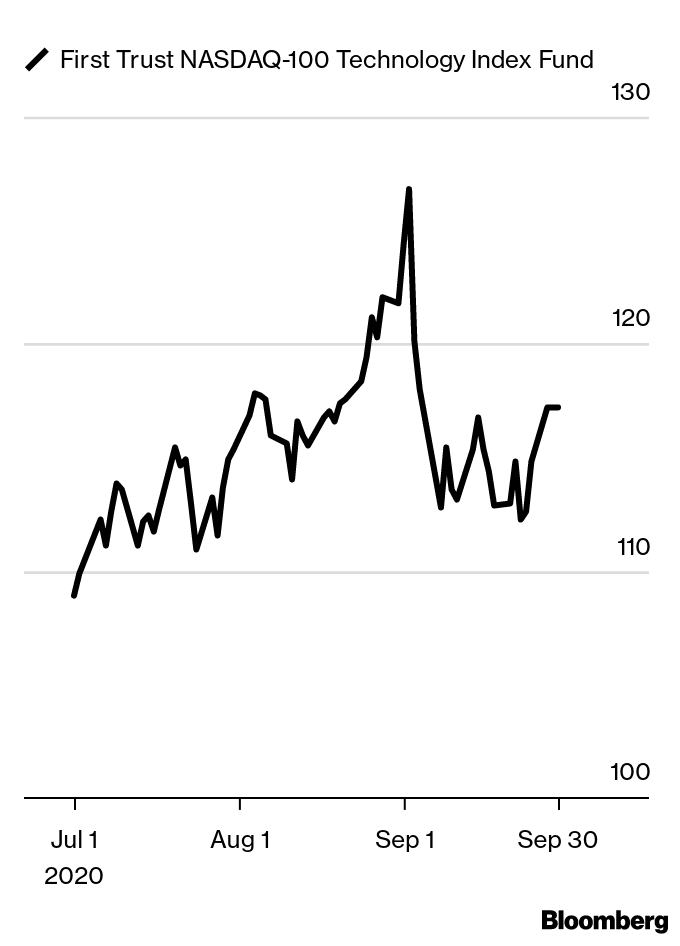 was up 7.4%.
was up 7.4%.
Look to Outsourcers
To temper volatility from cyclical stocks that are influenced by the economy, adding equities with consistent earnings growth seems prudent. A good example of this are companies that provide outsourcing for operations such as finance and accounting, reporting, web development, call centers, HR functions, marketing, and so on.
The industry has expanded at a pace slightly above global real GDP growth over the past several years, reaching total revenue of approximately $160 billion in 2019. Thousands of the world’s largest companies use those kinds of services in daily operations. In a Covid-19-induced recession, outsourcing becomes an imperative.
This type of business-process outsourcing began years ago with customer service call centers, often located in countries with low labor costs. It is evolving into digital transformation services, deploying artificial intelligence and automation, such as use of robot apps to automate processes and a virtual workforce. Companies that provide these services have sticky long-term annuity revenues, and the winners are expanding their profit margins as they add more sophisticated services.
How to play it with ETFs: The First Trust Nasdaq-100-Technology Sector Index Fund (QTEC) is loaded with B2B technology companies that are expanding more deeply into corporate services, and have the advantage of recurring revenue from software as a service models. The fund’s expense ratio is 0.60%.
is loaded with B2B technology companies that are expanding more deeply into corporate services, and have the advantage of recurring revenue from software as a service models. The fund’s expense ratio is 0.60%.
Performance of last quarter’s ETF plays: Balchunas’s pick for a way to invest in Ketterer’s theme last quarter was the US Global Jets ETF (JETS)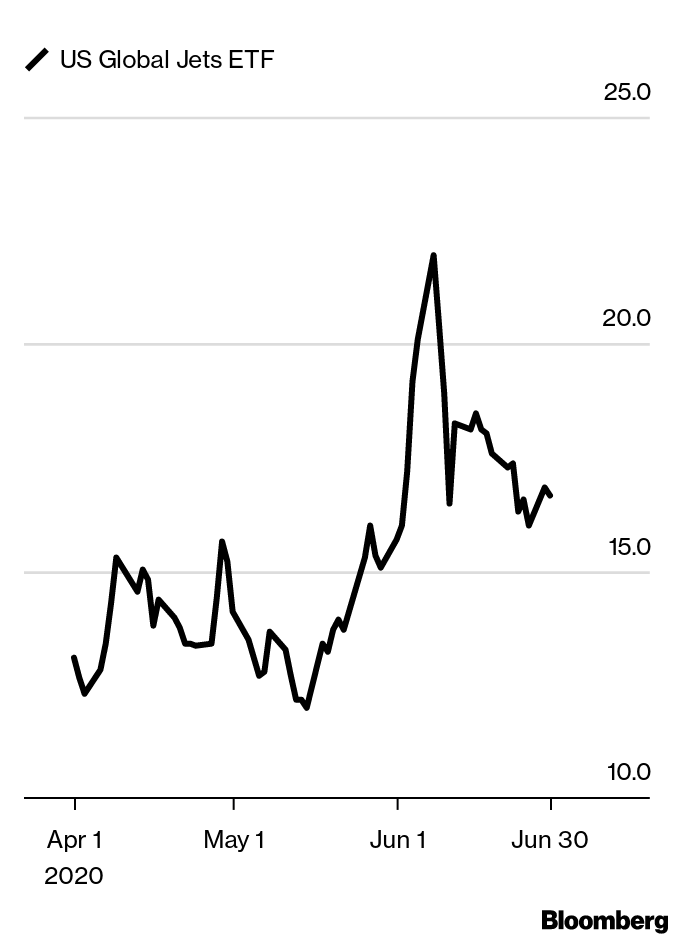 , which rose 13.5% in the second quarter.
, which rose 13.5% in the second quarter.
Buy into Aero-mageddon
To help contain the coronavirus, most commercial flights are grounded. Countries that account for more than 98% of global passenger revenues have imposed travel restrictions. IATA, an airline industry association, recently forecast passenger traffic down 38% this year (this compares with the worst drop on record of -3.5% in 2009) and a 44% decline in passenger revenue. Every additional week of lockdown worsens this aero-mageddon. Despite the recent groundings, investors would do well to look ahead.
Global aviation and aerospace has strategic importance, facilitating billions of passenger journeys and transporting billions of dollars worth of cargo, not to mention military applications. Most governments are extending financial lifelines to their respective national aviation and aerospace industries. High fixed costs, emblematic of these industries, translates to a very wide moat.
World class aerospace companies boast expertly-engineered products/equipment/software, global manufacturing facilities and massive supply chains, while airlines hold scarce allocations of airport landing/departure slots. Strong players in aviation and aerospace have a network and franchise that’s incredibly difficult and expensive to replicate.
Airplanes will take to the skies again soon, as they enable free movement of people and goods globally. There are no alternatives. With testing and vaccines, plus some type of health certification, passenger demand will recover, amplified by the expanding middle class in emerging countries. Expect medical breakthroughs for society to jettison “social distancing” within a two-year investment horizon.
When unrestricted, airlines will re-accelerate fleet-modernization programs, purchase new fuel-efficient aircraft and become more sophisticated at data analytics. Those with weak balance sheets and uncompetitive offerings will disappear. Only two companies manufacture the majority of short- and long-haul aircraft, and four aircraft engine companies dominate the global market and service the bulk of the installed fleet.
Several well-managed airlines will likely take capacity from weaker rivals. The aviation ecosystem of catering, airport retail and the like have also seen their revenues collapse — yet many have very profitable franchises. Aviation and aerospace stocks, normally highly cash-flow-generating businesses, have performed miserably. U.S. and European aerospace stocks trade at historically low forward-valuation multiples. Many of these stocks must double to return to prices seen only last January, and several are poised to do even better.
How to play it with ETFs: The US Global Jets ETF (JETS) is a concentrated portfolio of U.S. passenger airlines. It has a 12% exposure to each of the four largest carriers and a 4% weighting for the next five largest. The rest of the portfolio contains global airlines, airports and aircraft manufacturers, all of which are facing the near-term demand shock from restricted travel. The fund’s positioning toward the largest and best-capitalized U.S. airlines is likely advantageous in the current contraction, Balchunas said, especially in light of potential fiscal aid.
is a concentrated portfolio of U.S. passenger airlines. It has a 12% exposure to each of the four largest carriers and a 4% weighting for the next five largest. The rest of the portfolio contains global airlines, airports and aircraft manufacturers, all of which are facing the near-term demand shock from restricted travel. The fund’s positioning toward the largest and best-capitalized U.S. airlines is likely advantageous in the current contraction, Balchunas said, especially in light of potential fiscal aid.
Performance of last quarter’s ETF plays: The iShares Global Energy ETF (IXC)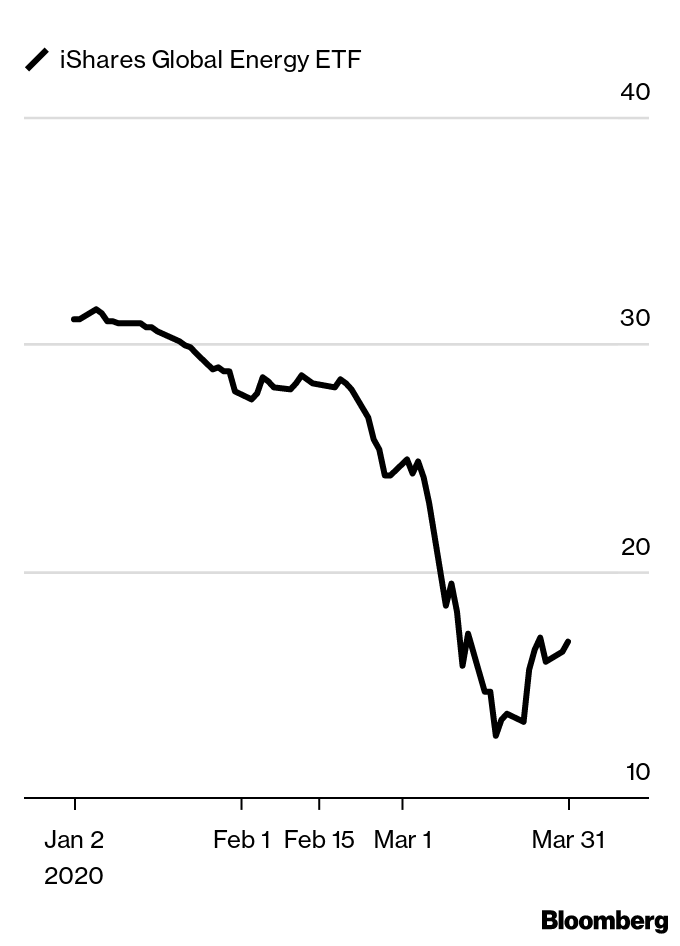 felt the pain in the oil sector and fell 45.2%.
felt the pain in the oil sector and fell 45.2%.
Look to the Energy Sector
Despite an upturn in crude oil prices last year, 2019’s runaway bull market trampled global integrated oil majors. Energy makes up less than 6% of the MSCI All Country World Index and returned only 14% last year versus 27% for the Index. Even this month’s U.S. airstrike in Iraq and subsequent Iranian retaliation hasn’t attracted much buying interest in energy stocks. The MSCI World Integrated Oil & Gas Index trades below its 10-year low in price-to-cash flow multiples, with several constituents offering dividend yields well above 5%. But the oil majors, especially the Europeans, will likely experience enough upstream production in 2020 to accelerate their revenue growth.
Meanwhile, Iran sanctions may shrink global supply by 1.8 million barrels per day. OPEC production cuts may also support crude oil prices near current levels. U.S. shale drillers—the big swing factor in non-OPEC production—are struggling to access capital, thereby limiting their production. With a slowing of liquified natural gas (LNG) capacity and demand for LNG by the global shipping industry to curb emissions, natural gas prices could rise, boosting revenues for oil majors.
Managements have become disciplined in spending on expansion and in assiduous cost control. European oil majors have reduced their capital expenditures to about 37% below their peak in the 2011-2014 period. Global oil majors continue to slash costs and generate free cash flow (that’s cash not needed in operations). To satisfy investors, the oil and gas industry must pay attractive dividends, buy back shares and continue investing in low-carbon businesses such as solar, wind, biofuels and electric vehicle charging. Several of these European majors have published long-term carbon emissions reduction goals, with some committing to reductions of 50% or more by 2050.
In a world where central banks have created mountains of monetary liquidity and investors expect double-digit percentage annual returns from stocks, these steady oil majors can’t compete. For many investors, the prospect of a few percentage points of capital gains plus 5% or more in dividend yields must look rather dull. But dull might be just the right answer in the next few years.
How to play it with ETFs: Balchunas says that while there is no European energy ETF (yet), the iShares Global Energy ETF (IXC) tracks oil majors from all over the world. It holds stocks such as Exxon Mobil, Chevron and BP, and has a little more than 20% of the fund in Europe. It has $863 million in assets and a fee of 0.46%.
tracks oil majors from all over the world. It holds stocks such as Exxon Mobil, Chevron and BP, and has a little more than 20% of the fund in Europe. It has $863 million in assets and a fee of 0.46%.
Performance of last quarter’s ETF plays: The Defiance Next Gen Connectivity ETF (FIVG)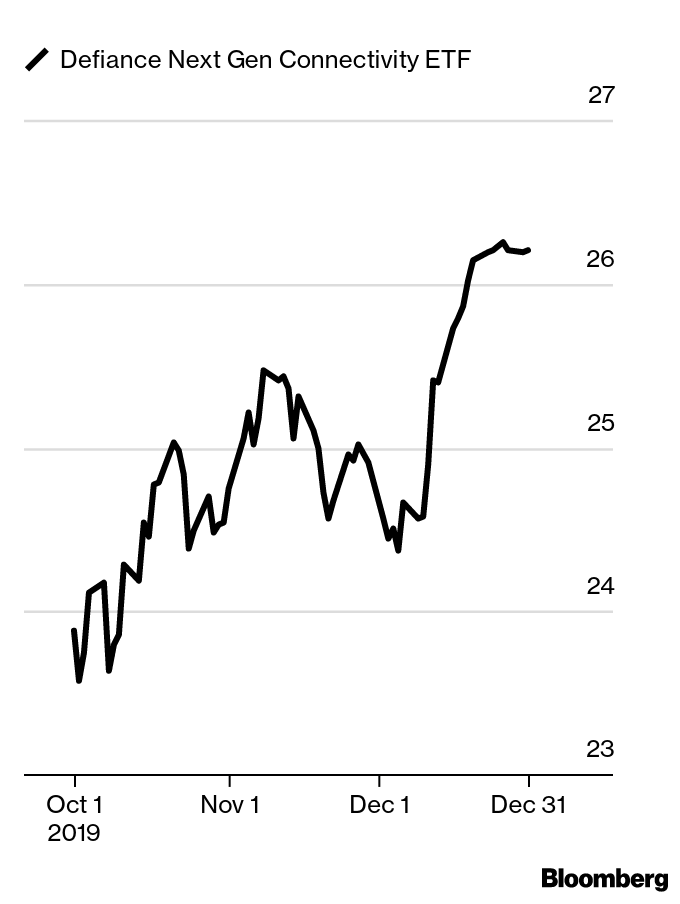 was Balchunas’s choice as a way to play Ketterer’s “factory of the future” theme. It had a 7.1% gain for the quarter.
was Balchunas’s choice as a way to play Ketterer’s “factory of the future” theme. It had a 7.1% gain for the quarter.
The Factory of the Future
With recession fears weighing on cyclical stocks globally, this may provide an excellent opportunity to buy some of Europe’s best industrial automation companies at relatively low valuations versus U.S. peers.
Advanced economies are on the doorstep of a 5G (5th generation cellular wireless) era of connectivity. Relative to the prior generation, 5G brings greater speed to move more data, lowers latency to boost responsiveness and connects a lot more devices.
In the next few years, this should help manufacturers move towards “Industry 4.0,” where connectivity and sensors augment machines connected to a system making both production and design decisions. This allows manufacturers to respond quickly to changing market dynamics with minimal disruption to production and make the entire value chain more efficient.
For example, if a product defect becomes apparent in the market, data regarding that flaw can be fed back into the factory to adjust the design and manufacturing process. Industry 4.0 will incorporate the smart factory: the latest fully automated flexible robotics capable of assembling products, 5G wireless technologies and industrial IoT (internet of things).
IoT is the network of physical objects and devices (such as computers, machines and robots) connected to the internet to collect and share data. Industrial automation will connect products and systems on the factory floor, as well as industrial assets in the field, through the cloud, allowing them to communicate to optimize design and production. This should lead to more productive factories and higher quality operations, not to mention better products.
A state-of-the-art automotive plant, for example, uses industrial automation technologies to design the optimal robotics path to boost weld quality and productivity. Sensors collect real-time data and can feed information about the production process from the later stages of manufacturing back into the earlier stages of design and manufacturing. In this factory of the future, people and collaborative robots work side by side. Global leaders in industrial automation will transform manufacturing and—as they succeed—attract considerable investor attention.
How to play it with ETFs: Defiance Next Gen Connectivity ETF (FIVG)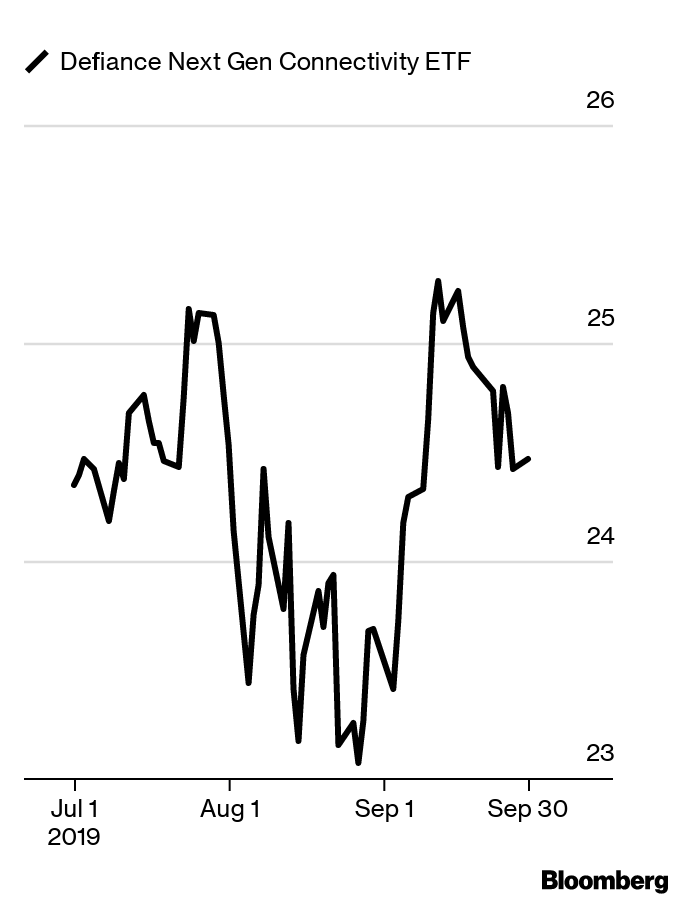 offers exposure to companies developing the 5G networking and communication technologies. The fund has 18% exposure to non-U.S. companies. Top constituents are Skyworks Solutions, Analog Devices, Marvel Technology Group and Nokia Oyj. The expense ratio is 0.30%.
offers exposure to companies developing the 5G networking and communication technologies. The fund has 18% exposure to non-U.S. companies. Top constituents are Skyworks Solutions, Analog Devices, Marvel Technology Group and Nokia Oyj. The expense ratio is 0.30%.
Performance of last quarter’s ETF plays: iShares Global Communications Services ETF (IXP)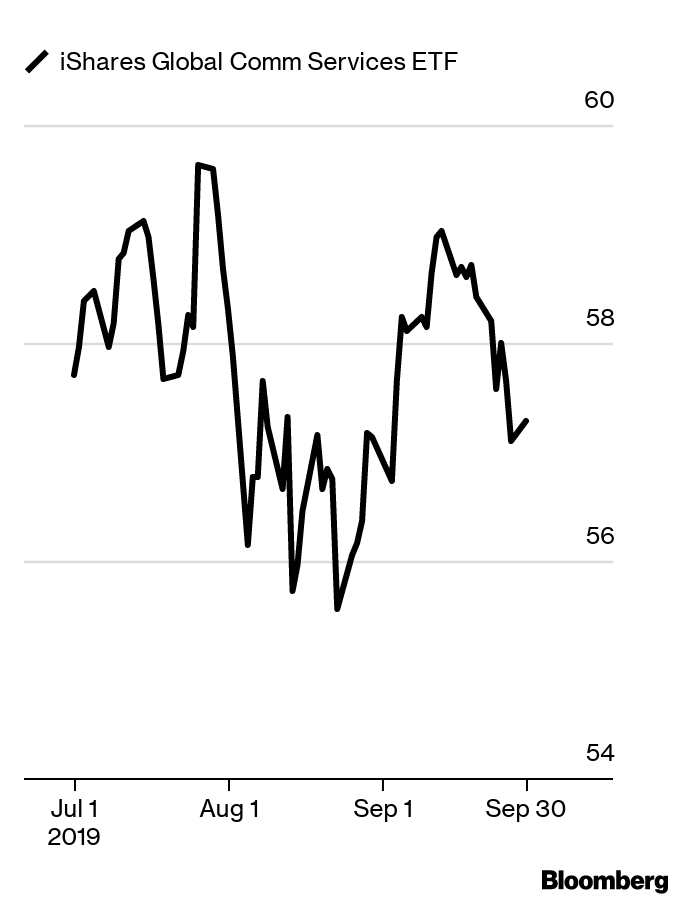 ended the quarter down 0.4%.
ended the quarter down 0.4%.
Look to Global Telcos
Equity markets don’t typically deliver double-digit percentage annual returns each year for 10 consecutive years. As of June 30, the U.S. and many foreign markets have achieved that feat. Super-normal returns reflect the tsunami of global monetary liquidity bidding up asset prices.
In this long-running bull market, investors seek growth and appear indifferent to valuation. For example, the percent of IPOs of companies with negative earnings in the past year exceeds the late 1990s technology bubble highs.
Rather than chase market winners—especially those in traditionally defensive sectors such as utilities and consumer staples—investors can find cheaper havens elsewhere. The unpopular global telecommunication stocks may have the right characteristics. Revenue growth for the telco industry should accelerate in the next few years as customers consume more data at an increased pace. A wider usage of additional devices—such as smart watches and a second mobile phone for work—is also driving up data usage and subscriber growth.
In Asia, the larger countries tend to have three telco competitors controlling the bulk of market share and enjoying favorable regulation. Several of these stocks trade at extremely low valuations relative to their markets and their own history. In Europe, the telco companies have acquired spectrum in various countries, defended their market positions against telco upstarts and are consolidating operations to improve returns.
For Europe to commercialize world-class 5G mobile telecommunications, the regulatory environment must become more supportive of the telco service providers. In all geographies, telco competitors will likely collaborate on infrastructure investments, sharing the cost of mobile phone towers. Meanwhile, many of the better-managed of these companies generate abundant surplus cash flow, and reward investors with generous dividends, which equate to yields well in excess of market averages.
Way to play it with ETFs: Balchunas’s choice is the iShares Global Communications Services ETF (IXP)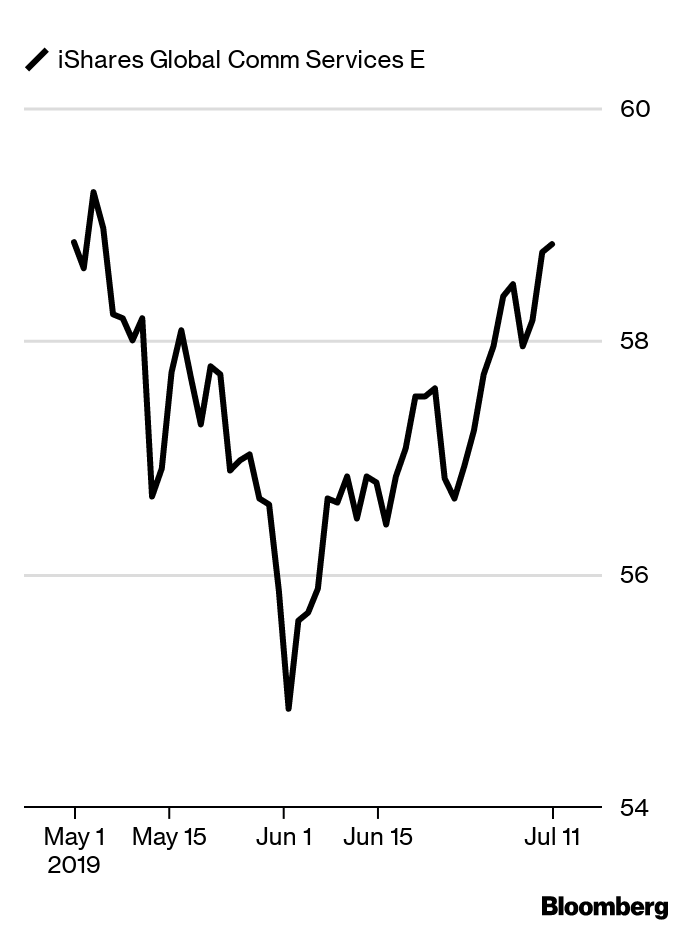 , which he expects will benefit from growth in telcos both domestic and international. It has direct exposure to three of Europe’s largest carriers, Deutsche Telekom, Telefonica, and Vodafone Group, as well as China Mobile and Japan’s NTT
, which he expects will benefit from growth in telcos both domestic and international. It has direct exposure to three of Europe’s largest carriers, Deutsche Telekom, Telefonica, and Vodafone Group, as well as China Mobile and Japan’s NTT
Docomo. The fund is market-cap weighted, with 34% international exposure and an expense ratio of 0.47%.
Performance of last quarter’s ETF plays: The Pacer Developed Markets International Cash Cows 100 ETF (ICOW)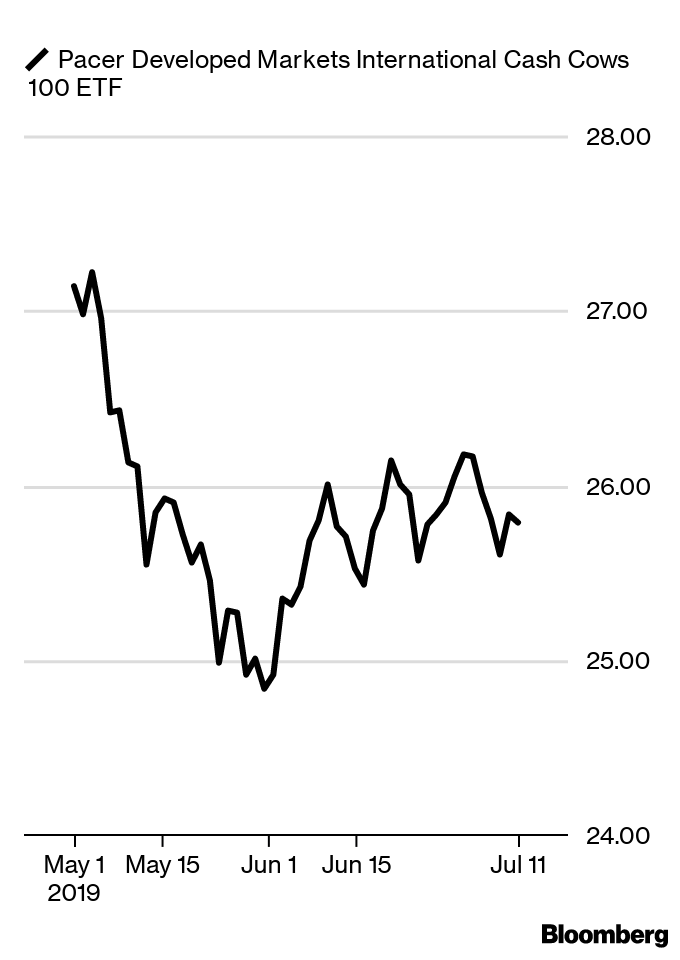 fell 1.3% in the second quarter.
fell 1.3% in the second quarter.
Look for the Tide to Turn
Cycles tend to turn when least expected. The past decade of massive global monetary accommodation has produced side effects such as asset inflation, fiscal deficits and rising levels of private and public sector debt. The excess liquidity effect in public equity markets has encouraged investors to care less about valuation—and more about growth.
Yet, as the pace of liquidity expansions slows, valuation will matter. Over the past decade to March 31, the U.S. market has returned almost 16 percent annually on average, a generous result for a developed-markets index. And it’s generous, indeed, given the shrinking risk, measured by near-record-low volatility.
Value stocks have underperformed growth for much of this post-2008 period, resulting in historically wide gaps between value indexes and growth indexes. From the year 2000, cheap stocks in the MSCI All Country World Index have outperformed expensive stocks by more than 40 percent over the next 12 months when the earnings yield spread (earnings yield of cheap stocks minus earnings yield of expensive stocks) has been in the top decile. At the end of March the earnings yield spread was in the 92nd percentile. At some point, extreme levels of depressed valuations will inspire buyers to snap up bargains.
The most undervalued stocks in many markets globally discount recession and structural disruption. Banks, maligned in a period of falling interest rates, trade at near-crisis levels, especially European ones. Global auto stocks trade at meager valuations versus history and compared with other cyclical segments of the markets, such as capital goods. Energy stocks are also trading at historically depressed levels.
For many growth stocks, earnings and cash flow are promised far into the future, which makes them the most sensitive to interest-rate fluctuations. As rates rise, these types of stocks typically swoon. In contrast, companies that generate surplus cash flow today, and return much of that to shareholders, offer immediate returns. With liquidity ebbing, a bird in the hand will (once again) be worth two in the bush.
Way to play it with ETFs: Balchunas points to Pacer Developed Markets International Cash Cows 100 ETF (ICOW)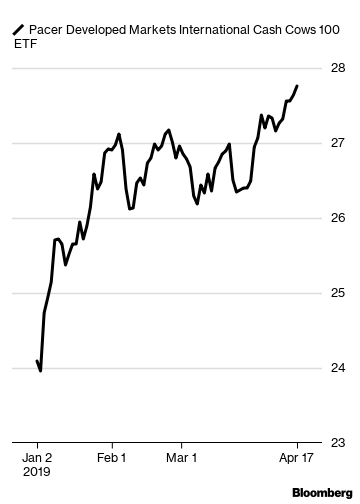 . The ETF offers international equity exposure to 100 securities with high free-cash-flow yields. ICOW has an expense ratio of 0.65 percent.
. The ETF offers international equity exposure to 100 securities with high free-cash-flow yields. ICOW has an expense ratio of 0.65 percent.
Performance of last quarter’s ETF plays: The iShares MSCI Europe Financials ETF (EUFN) , Balchunas’s pick to play on Ketterer’s theme of buying battered European bank stocks, rose 7.1 percent.
, Balchunas’s pick to play on Ketterer’s theme of buying battered European bank stocks, rose 7.1 percent.
There’s a Price for Everything
By the close of 2018, global equity markets had punished—more like pulverized—stocks with economically cyclical earnings and typically rewarded those in the most defensive industries. The defensive havens included stocks in such industries as utilities, household and personal products, food and staples and retailing. In contrast, banks and insurance stocks, especially those in Europe, fell in price so sharply that their valuations have reached levels consistent with a severe recession and a financial system crisis.
That’s a value investor’s dream: to buy stocks whose valuations already discount an unlikely scenario, and then wait for the inevitable recovery. Even better, the most battered of European bank stocks pay investors to be patient via generous dividends.
Early this month, the MSCI Europe Banks Net Total Return USD Index traded at a multiple of eight times 2019 earnings and 0.7 times book value, and had a dividend yield of almost 6 percent. But these are not the same banks as during Europe’s last banking crisis. These companies have strengthened their capital positions to have four times as much capital as a decade ago. U.K. banks have enough capital, according to their regulator, to withstand an economic collapse, a huge rise in U.K. unemployment, a 33 percent drop in residential property prices and a 27 percent devaluation of the pound sterling. That’s akin to multiple shocks, and even after that nightmare, the banks would have twice the required capital.
Admittedly, banks are leveraged into economic conditions, good or bad. Adept bank managers (and there are plenty of these in Europe) know how to use their two primary levers to improve shareholder returns: cost control and capital management. With disciplined lending, ultra-cost efficiency and savvy technology spending, these well-capitalized banks should have a rosy future. At these bargain valuations, misery is already priced in.
Way to play it with ETFs: The closest thing to a play on European banks is the iShares MSCI Europe Financials ETF (EUFN)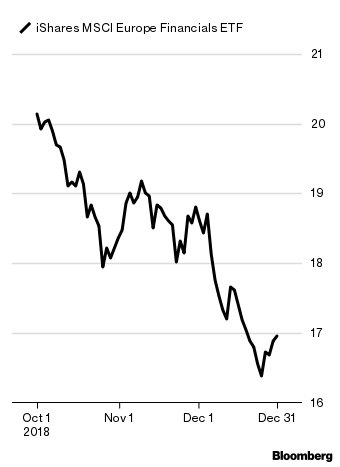 , which is made up of 60 percent banks. The ETF has a fairly reasonable expense ratio of 0.48 percent. Since the ETF is market cap-weighted, big players such as HSBC Holdings and Banco Santander make up a big chunk of holdings.
, which is made up of 60 percent banks. The ETF has a fairly reasonable expense ratio of 0.48 percent. Since the ETF is market cap-weighted, big players such as HSBC Holdings and Banco Santander make up a big chunk of holdings.
Performance of last quarter’s ETF plays: The First Trust Morningstar Dividend Leaders Index Fund (FDL)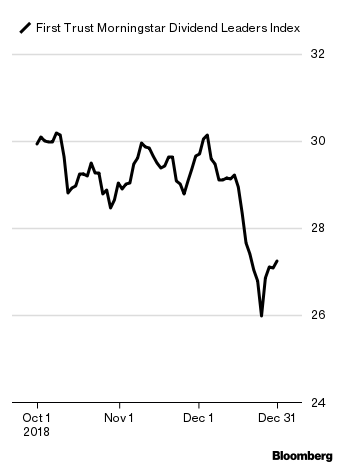 fell 9 percent in 2018’s final quarter.
fell 9 percent in 2018’s final quarter.
Cash Today Beats Cash Tomorrow
High-dividend-yielding, undervalued stocks may finally reign over growth stocks. In this global environment of gradually tighter monetary policy, the cash that a company returns to its shareholders in the next few years may be much more valuable than a potentially unfulfilled promise of rapid growth in profits many years ahead.
The massive growth in liquidity created by global central banks after the financial crisis has stalled in 2018, and will likely shrink in 2019. Meanwhile, valuation spreads between expensive and cheap stocks, measured by relative price-to-earnings ratios, are at extremely wide levels vs. history. In the past 20 years, these especially wide valuation spreads typically led to a narrowing of the gap and subsequent outperformance of cheap stocks.
The global consumer staples sector contains some of the cheapest, highest-dividend-yielding stocks. Many of these companies generate mountains of near-term cash flow. Within staples, the most maligned and possibly misunderstood segment is tobacco. Both U.S. and European-listed large-cap tobacco stocks trade at sizable discounts to their history. The discount may stem from investor concerns about the FDA’s tobacco regulation, shrinking U.S. cigarette volumes, a surge in demand for alternative products such as e-cigarettes and weakness in emerging market economies and currencies.
Much of this may be transitory, leaving investors with well-managed consumer marketing giants able to transition to a growing e-cigarette category. Heavily-taxed (and clearly very unhealthy) combustible cigarettes will likely disappear in the years ahead, replaced by less harmful forms of nicotine delivery. The more that global regulators focus their efforts on vapor, the better for these large incumbent tobacco companies, which are better able to absorb the costs of regulation than new entrants. Even in the shift to noncombustible products, global tobacco giants have the financial strength and prolific free cash flow generation to reward shareholders today and invest for tomorrow.
Way to play it with ETFs: Balchunas suggests the First Trust Morningstar Dividend Leaders Index Fund (FDL)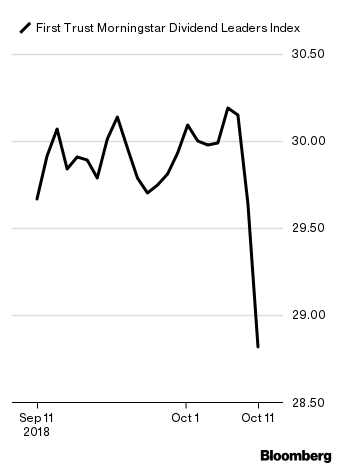 which screens for stocks that have shown dividend consistency and then picks the 100 highest-yielding names. It’s heavy in consumer staples stocks, with big tobacco companies among top holdings. The $1.4 billion ETF charges 0.45 percent.
which screens for stocks that have shown dividend consistency and then picks the 100 highest-yielding names. It’s heavy in consumer staples stocks, with big tobacco companies among top holdings. The $1.4 billion ETF charges 0.45 percent.
Performance of last quarter’s ETF plays: Balchunas pointed to the SPDR Oil & Gas Equipment & Services ETF (XES)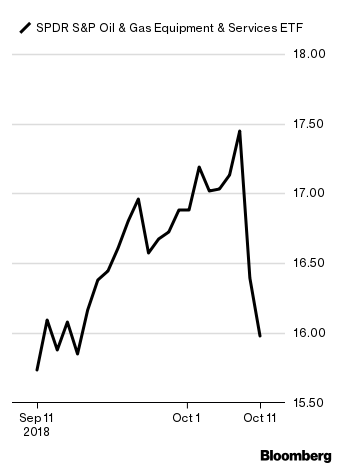 as a way to play Ketterer’s suggestion of oilfield services companies. The ETF rose about 1.5 percent in the third quarter.
as a way to play Ketterer’s suggestion of oilfield services companies. The ETF rose about 1.5 percent in the third quarter.
Check Out Oilfield Services Companies
Despite the recovery over the past year in crude oil prices, some energy-related equities can’t seem to shake investor skepticism.
One of the most undervalued areas of the U.S. unconventional oil and gas industry is oilfield services. Of the onshore oilfield service stocks, the pressure pumpers have sagged significantly in price.
Pressure pumping is closely tied to drilling rig activity and is used in development of oil fields. After the well is drilled, pumpers mix water, sand and chemicals, then blast it into the reservoir rock so that the hydrocarbons will flow. Aided by technological improvements, producers have exceeded even their own expectations.
In the Permian Basin of western Texas, producers have extracted oil faster than the pipeline infrastructure can transport it to Gulf refineries and port terminals. The Permian Basin, notable for its enormous supply of crude oil and gas, has no near-term answer to these serious transportation bottlenecks. However, the problem should disappear in 2019 with the addition of pipeline capacity.
Investors, apparently unwilling to wait, have cast aside oil services stocks, especially those with sizable exposure to the Permian Basin. But pipeline squeezes don’t last long in the shale era; they incentivize midstream companies to accelerate new pipelines or expand existing capacity to fill the gap.
Meanwhile, oil prices seem well supported. New crude oil discoveries since 2013 probably can’t offset the drag from aging oilfield production declines, falling reserves and insufficient replacement of produced volumes. Supply constraints in countries such as Venezuela, Iran, Libya, Nigeria and Mexico may get worse.
As a recent affirmation of U.S. shale’s promising future, energy majors are making sizable acquisitions of U.S. onshore oil and gas assets. Producers will need oil services companies—even the beleaguered pumpers—to develop these newly acquired fields.
Way to play it with ETFs: To play the oil services industry, investors could use the SPDR Oil & Gas Equipment & Services ETF (XES)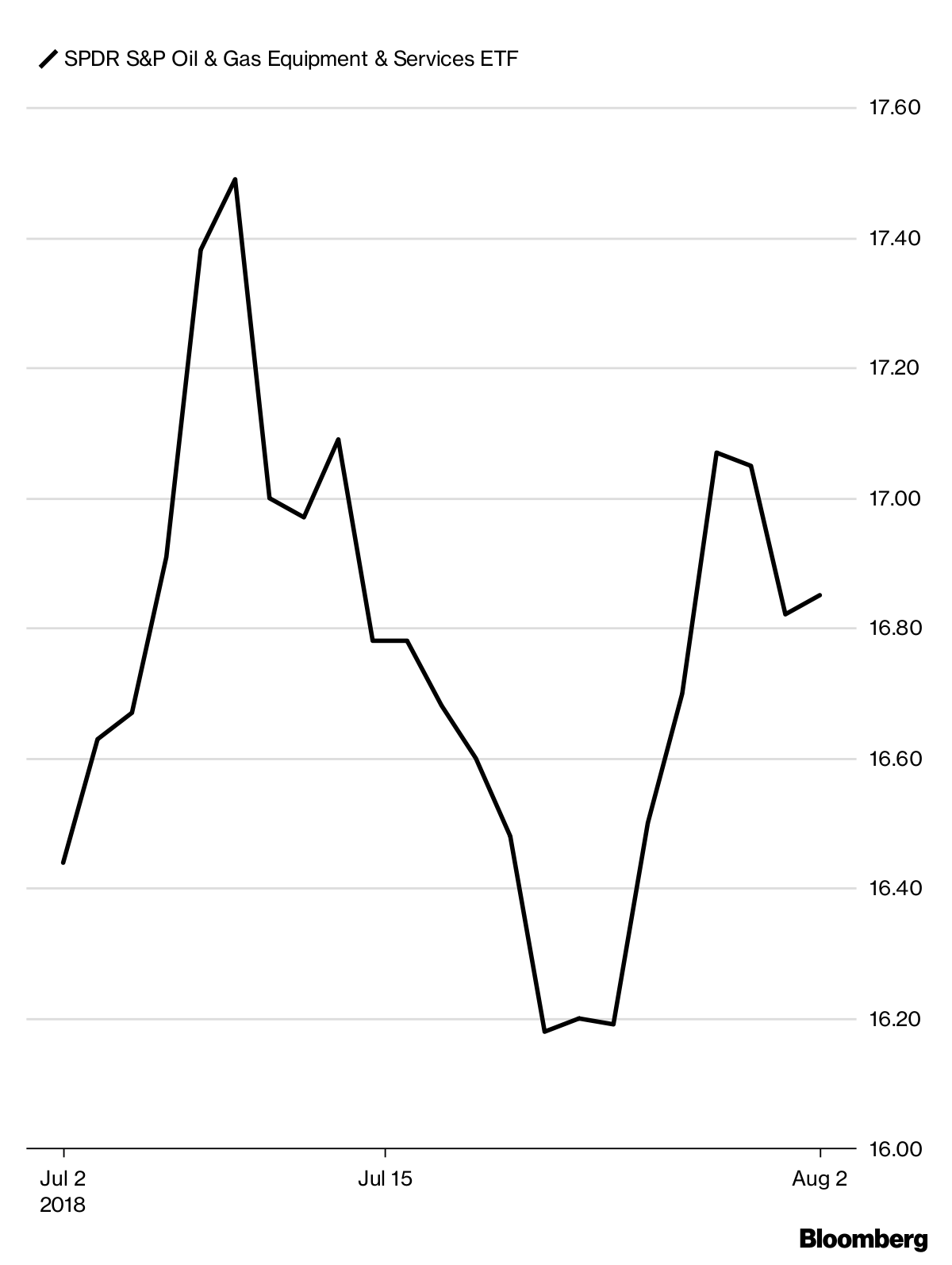 , an equal-weighted basket of large, mid- and small-cap oil services companies; its expense ratio is 0.35 percent.
, an equal-weighted basket of large, mid- and small-cap oil services companies; its expense ratio is 0.35 percent.
Performance of last quarter’s ETF plays: The iShares Global Telecom ETF (IXP)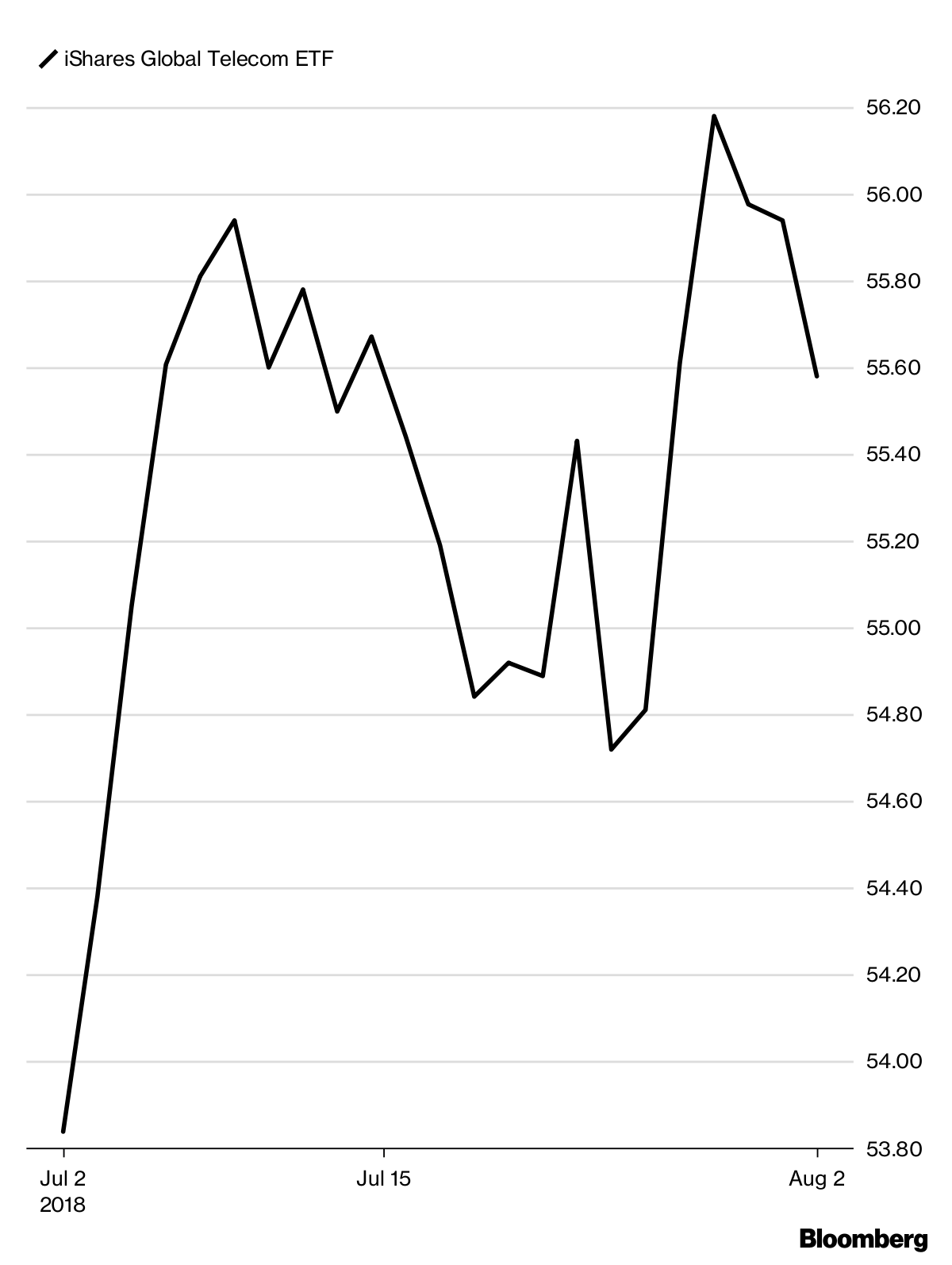 , which Balchunas chose as one way to play on Ketterer’s investing themes in the second quarter, dropped 5.7 percent in value over the quarter.
, which Balchunas chose as one way to play on Ketterer’s investing themes in the second quarter, dropped 5.7 percent in value over the quarter.
Go for Defensive Value
There’s a lot to be said for investment income, especially delivered via companies that are fully capable of sustaining that income for many years ahead. In sagging stock markets, some portion of an investor’s portfolio needs to produce returns now, not later. With plenty of dividend income, the wait for a market recovery shouldn’t seem quite so painful. Peer inside the global telecommunications sector and you will find many generous dividend payers also boasting financial strength far in excess of overall market averages.
These telecom stocks, unloved for their lack of recent growth and bland forecasts, have lost the interest of bull market investors. Mention Tencent or Alibaba and people will listen intently; refer to China Mobile or SK Telecom for yawns of boredom. Yet telecom behemoths offering mobile and fixed broadband services should grab our attention as ideal ballast for the inevitable bear markets. We need the services they offer—and will need them even more when fifth-generation wireless systems (5G) become commercially available.
The MSCI All Country World Telecommunications Services Index is made up of 81 constituents in developed and emerging-markets countries. By one valuation measure, enterprise value-to-Ebitda, it trades at a discount of more than 40 percent, compared with the aggregate equity market benchmark, the MSCI All Country World Index. (Enterprise value includes debt and cash when calculating company value, rather than just multiplying a company’s shares outstanding by its share price to arrive at market capitalization; Ebitda, a cash flow measure, refers to earnings before interest, taxes, depreciation and amortization.) The index also has a dividend yield almost 50 percent higher than the benchmark.
If sustainability of dividend yield makes you sleep better at night, focus on the companies with very low (or zero) net debt, defined as a company’s long-term debt less cash. In capital-intensive industries such as telecommunications, larger company size brings scale economies and cost advantages. Competitive, mature telecom markets typically cannot support more than three players, or returns on capital will decline for all participants. China, Japan and South Korea are three of the most attractive mature telecom markets globally.
Three-player telecom markets, in which competitors typically don’t engage in devastating price wars, often have stable participants generating reliable streams of cash. Companies rewarding shareholders by returning capital, through dividends and share repurchases, are less likely than growth-oriented peers to squander shareholder capital through overpriced acquisitions. Many telecom companies have learned that stability is one of their most attractive characteristics.
Way to play it with ETFs: There is no ETF tracking the MSCI All Country World Telecommunication Services Index, but Bloomberg Intelligence analyst Eric Balchunas says there is something very close: The iShares Global Telecom ETF (IXP)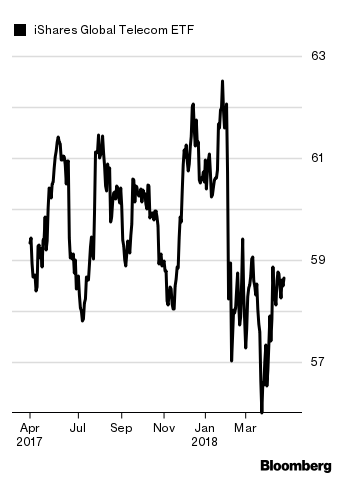 tracks 43 telecom stocks from about a dozen countries. It is notable for its high dividend yield of 3.5 percent, says Balchunas—and for its above-average fee (for a sector ETF) of 0.47 percent.
tracks 43 telecom stocks from about a dozen countries. It is notable for its high dividend yield of 3.5 percent, says Balchunas—and for its above-average fee (for a sector ETF) of 0.47 percent.
Performance of last quarter’s ETF plays: Balchunas chose the Vanguard Utilities ETF (VPU)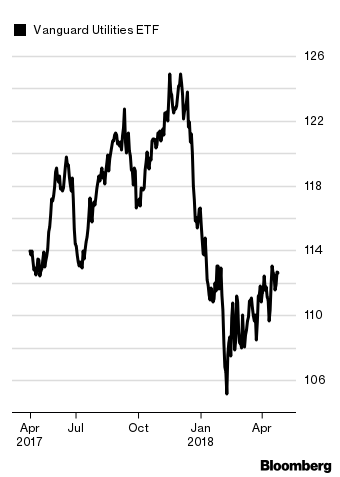 and the Global X Lithium & Battery Tech ETF (LIT)
and the Global X Lithium & Battery Tech ETF (LIT)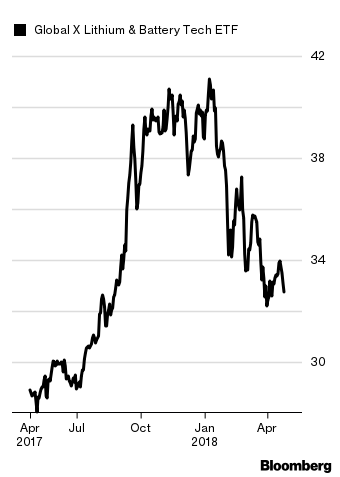 as ways to play Ketterer’s suggestion that investors consider global utility stocks. In 2018’s first quarter, VPU fell 4.1 percent and LIT tumbled 15.3 percent. LIT fell as analysts turned bearish on lithium, fearing a supply glut, as well as possibly less demand for electric vehicles in 2019.
as ways to play Ketterer’s suggestion that investors consider global utility stocks. In 2018’s first quarter, VPU fell 4.1 percent and LIT tumbled 15.3 percent. LIT fell as analysts turned bearish on lithium, fearing a supply glut, as well as possibly less demand for electric vehicles in 2019.
Think Smart Power
Utility stocks around the world have generally trailed their respective equity market performance over the past year. In the U.S., rising interest rates will push up utility borrowing costs, and corporate tax reform won’t boost earnings if the tax benefit must be passed on to customers. But just look a few years ahead, and the prospects for electric utilities may be considerably brighter than they are today.
The global conversion of internal combustion engine vehicles to electric vehicles (EVs, including plug-in hybrids) will boost the demand for electricity delivered efficiently to public charge points and homes. If large concentrations of EVs were to charge in the same hour, demand could spike to several times the norm, overloading the grid, causing overheating and blackouts. To avoid this, many electric utilities, especially in countries determined to reduce carbon emissions, will need to increase power utility investments substantially.
With new capacity, utilities may find it more efficient and cost-effective to provide power to large industrial customers, possibly operators of autonomous vehicle fleets, where recharging can be centralized rather than scattered across countless garages and parking spots. Electric utility regulators should allow the utilities to earn a healthy return on grid upgrades, new connections (such as new power lines to electrify parking bays), smart architecture, digitization and new peaking capacity. According to Goldman Sachs, these will be big global investments: $2.6 trillion for charging infrastructure to support full passenger vehicle electrification, plus another $3 trillion spent by the utilities for transformers, new lines and smart infrastructure.
Without a proper reconfiguration of a country’s electricity distribution grid, as well as security of electricity supply, the EV rollout simply cannot happen. This effort to build infrastructure for a massive global conversion to EVs should benefit electric utilities able to distribute low-cost power incorporating renewables such as solar and wind.
Way to play it with ETFs: For a cheap and deep utilities ETF, the Vanguard Utilities ETF (VPU) tracks 77 utility stocks for a fee of 0.10 percent. A more out-of-the-box but related play on the move to electric vehicles is the Global X Lithium & Battery Tech ETF (LIT)
tracks 77 utility stocks for a fee of 0.10 percent. A more out-of-the-box but related play on the move to electric vehicles is the Global X Lithium & Battery Tech ETF (LIT)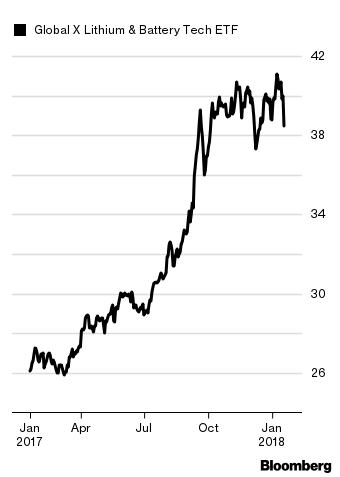 . It tracks lithium miners and battery producers and has a fee of 0.76 percent.
. It tracks lithium miners and battery producers and has a fee of 0.76 percent.
Performance of last quarter’s ETF plays: Last quarter, the ETF that was the closest fit for Ketterer’s theme of investing in China’s health care demand was the Global X China Consumer ETF (CHIQ)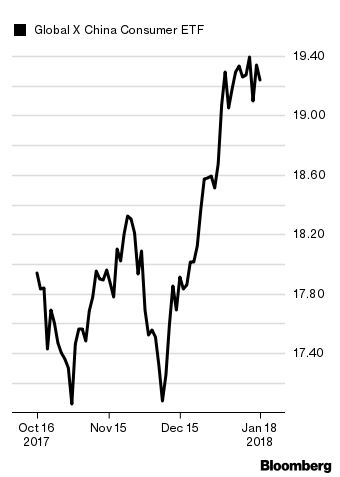 , which had about 8 percent of assets in the sector. In 2017’s final quarter, it gained 8.7 percent.
, which had about 8 percent of assets in the sector. In 2017’s final quarter, it gained 8.7 percent.
Invest in China’s Health Care Demand
Shifting from an emerging to a developed country, China can’t escape its demographics. As a byproduct of the one-child policy, China’s enormous population increased at only 0.6 percent per year from 1996 to 2015. That compares with the U.S. population’s expansion of 0.9 percent a year over the same period.
Low growth implies an aging population, and aging has its societal costs. Many Americans are struggling to pay for health care, and the Chinese are facing an even bigger tab. By 2050, roughly a quarter of China’s citizens will be older than age 60. With less than 6 percent of gross domestic product spent on health care (vs. 9 percent to 12 percent in most developed countries), the Chinese will likely devote more of their resources to staying healthy.
With rising disposable income per capita, China’s demand for health care, especially top-tier hospital services, exceeds supply. The central government recognizes the problems and aims to relieve congestion at the most reputable public hospitals by welcoming private capital into the industry. This flow of funds should improve conditions and spawn many higher-quality private hospitals. Other reforms include the elimination of unneeded middlemen in drug distribution, as well as prohibiting the markup of drug and medical devices.
Hospitals had become heavily dependent on drug sales to keep the lights on. To supplement their measly salaries, doctors accepted prescription-related bribes from pharmaceutical manufacturers. After a successful pilot program, zero markup of drugs became reality for most hospitals across the country this year. To speed up the approval process for efficacious drugs, the China Food and Drug Administration quadrupled its staff in 2015-16 and is on track to increase staff by 50 percent this year.
China’s health-care industry reforms, combined with the inevitable consolidation or demise of smaller or weaker players, will likely result in much greater efficiency and profitability in such areas as hospital management, drug and medical equipment distribution, private supplemental health insurance, and new-drug discovery and launch.
To complement reforms, the Middle Kingdom boasts a rising supply of young scientific talent, who are paid about a third as much as their peers in the developed world. Add to the mix a 15 percent corporate tax rate plus government subsidies to spur innovation, and the investment landscape looks very promising for Chinese health-care companies. (The standard Chinese corporate income tax rate is 25 percent, but the rate could be reduced to 15 percent for qualified enterprises engaged in industries encouraged by the Chinese government. Indigenous Chinese health-care companies are included in that category.)
Way to play it with ETFs: There are many China ETFs but none specific to the health-care sector, and most broad China ETFs have next to nothing in health-care exposure. The ETF with the most exposure to health care is the Global X China Consumer ETF (CHIQ)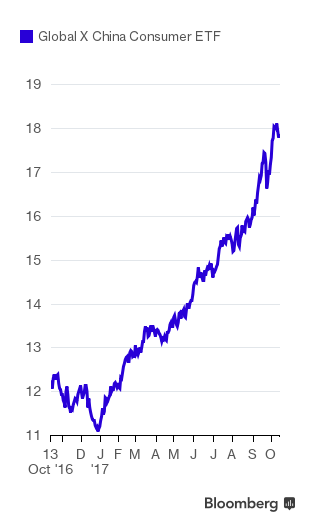 , which has about 8.7 percent of its assets in the sector.
, which has about 8.7 percent of its assets in the sector.
Performance of last quarter’s ETF plays: The Energy Select Sector SPDR Fund (XLE)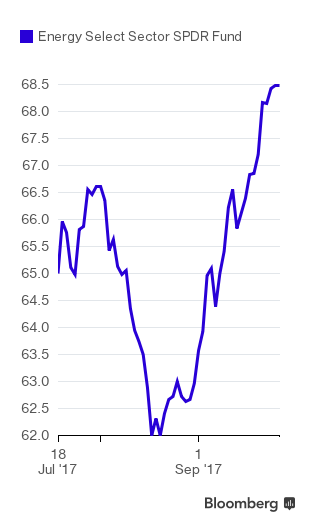 rose 5.6 percent in the quarter ended Sept. 30. Top holdings Chevron Corp., Schlumberger Ltd., and Exxon Mobil Corp. rose 12.6 percent, 6 percent, and 1.6 percent, respectively.
rose 5.6 percent in the quarter ended Sept. 30. Top holdings Chevron Corp., Schlumberger Ltd., and Exxon Mobil Corp. rose 12.6 percent, 6 percent, and 1.6 percent, respectively.
Fuel Up on Energy
Buy high-quality energy. Investor skepticism weighs heavily on the sector, making this one of the more promising areas in this mature bull market.
Oil and gas companies exhibit cyclicality in sales and earnings, traits that investors have shunned in recent years in favor of steady growth. Relative to high-flying technology stocks, the recent performance of energy equities looks abysmal. Over the past 12 months, global energy indexes have underperformed global technology by more than 30 percent and are trading at a sizable valuation discount.
The forces of supply and demand dictate the price of semiconductors as well as oil, with the lowest marginal cost producers having a distinct advantage over the competition. Advertising, including the internet, also has a cycle. The last time markets ignored the cyclicality of technology was in the late 1990s, a rough period for the most overvalued stocks.
Investors may be worried about a global glut of crude oil, especially from rising U.S. shale oil production. U.S. shale productivity continues to surprise on the upside, especially in the Permian Basin. As marginal costs have fallen from 2014, oil producers have increased wells and drilling volumes. The threat of a possible lack of OPEC production discipline also clouds the oil price outlook.
But exploration and production costs have recently turned upward in pressure pumping, sand, rail, trucking and labor. Oil-producing nations, including OPEC members as well as U.S. shale producers, cannot afford to spend more cash than they generate. As industry profits get squeezed, oil and gas companies’ credit ratings deteriorate, constricting lending to energy. At current spot prices, the world’s oil and gas industry doesn’t generate enough cash flow to sustain the spending required to expand capacity. In U.S. shale, production volumes per well decline particularly rapidly without additional investment.
On the demand side, the energy industry will not thrive in a recession. But technology doesn’t fare well in that scenario, either. Expect at least two more decades of rising demand for crude oil and gas, as electric vehicles will only gradually substitute for gasoline.
Look for companies with productive acreage and experienced management, financial strength, and cyclically low valuations. As the crude oil price recovers—perhaps approaching $60 per barrel, with natural gas reaching $3.25 per thousand cubic feet—energy sector share prices should prove rewarding.
Way to play it with ETFs:The Energy Select Sector SPDR Fund (XLE) is high-quality energy. Top holdings Exxon Mobil Corp., Chevron Corp., and Schlumberger Ltd. make up more than 40 percent of the portfolio. There’s a liquid market for the ETF, and it’s cheap, with a fee of 0.14 percent.
is high-quality energy. Top holdings Exxon Mobil Corp., Chevron Corp., and Schlumberger Ltd. make up more than 40 percent of the portfolio. There’s a liquid market for the ETF, and it’s cheap, with a fee of 0.14 percent.
Performance of last quarter’s ETF plays: The SPDR S&P International Health Care Sector ETF (IRY) was Balchunas’s pick as a way to play Ketterer’s focus on big pharma companies selling at a discount. It returned 7.9 percent from Mar. 31 to June 30.
was Balchunas’s pick as a way to play Ketterer’s focus on big pharma companies selling at a discount. It returned 7.9 percent from Mar. 31 to June 30.
Buy the Pharma Discount
Why do several of the large global pharmaceutical stocks trade at above-market dividend yields and below-market price/earnings ratios? Perhaps the repeated threats by President Trump to cut drug prices have scared investors.
The president will likely claim victory for something that is already happening. The large buyers of U.S. pharmaceuticals, such as pharmacy benefit managers and health insurers, continue to exert tremendous pressure on drug companies to discount prices. This is evident in 2016 data from Express Scripts that show year-on-year price percentage shrinkage in traditional pharmaceuticals and a slowing, mid-single-digit percentage increase for specialty drugs.
Importantly, utilization growth rates are greater than unit cost rises, indicating product efficacy. If the drugs weren’t effective, doctors wouldn’t prescribe them. Assuming buyers will pay for efficacious drugs, then the prognosis for the more innovative pharmaceutical companies is good.
Notably, several of the European drug giants with promising pipelines trade at valuation discounts to the health-care sector and to their own historical averages. Examples include Novartis AG, AstraZeneca Plc, Roche Holding AG and GlaxoSmithKline Plc. These well-managed, shareholder-friendly companies generate plenty of surplus cash to reward investors. Many of them have dividend yields at least a full percentage point in excess of the global pharmaceutical and biotech industry and well above overall equity market averages.
Famously profitable, the best-managed pharmaceutical companies should be able to offset reduced unit prices with volume growth. In their report dated January 2017, Evercore ISI analysts Umer Raffat and Akash Tewari note that most of Medicare/Medicaid spending increases are due to higher enrollment, not because of pharmaceutical costs. While total U.S. health-care spending continues to increase, the percentage attributable to prescription drugs has stayed flat, at around 10 percent.
Proposed drug pricing reforms, such as bidding, reimportation, Medicare negotiating prices and value-based pricing either already exist or have serious, likely insurmountable flaws, such as public safety. Even Medicare, the colossus of U.S. pharmaceutical buyers, probably can’t negotiate prices more favorable than under current law without being forced to restrict access, as drug demand may rise. Aging demographics imply increased drug usage over at least the next decade. The most innovative pharmaceutical companies will likely benefit, even as traditional branded drug prices fade.
Ways to play it with ETFs: The SPDR S&P International Health Care Sector ETF (IRY)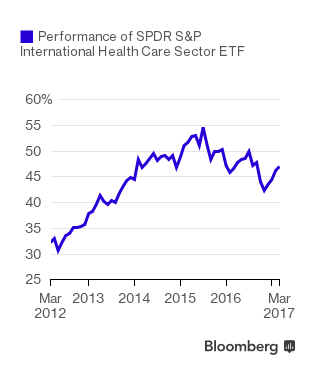 has the most exposure of any ETF to international pharma companies such as Novartis AG and AstraZeneca Plc. Those companies are in the top 10 holdings. The ETF has 75 percent allocated to pharma companies, 25 percent of which are based in Switzerland. IRY comes with a fee of 0.40 percent.
has the most exposure of any ETF to international pharma companies such as Novartis AG and AstraZeneca Plc. Those companies are in the top 10 holdings. The ETF has 75 percent allocated to pharma companies, 25 percent of which are based in Switzerland. IRY comes with a fee of 0.40 percent.
Performance of last quarter’s ETF plays: The iShares MSCI India ETF (INDA)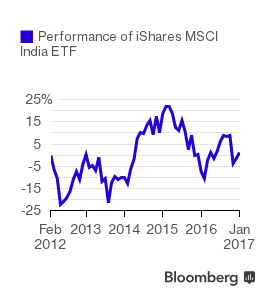 rose 16.9 percent over the past three months. Balchunas’s other pick, the PureFunds ISE Mobile Payments ETF (IPAY)
rose 16.9 percent over the past three months. Balchunas’s other pick, the PureFunds ISE Mobile Payments ETF (IPAY)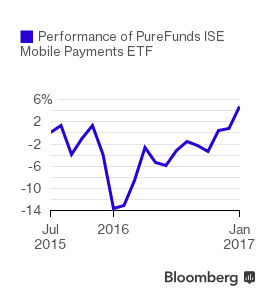 , gained 10 percent.
, gained 10 percent.
Think Long, Think Far
India is far. Flying from Los Angeles to Mumbai via Hong Kong takes about 24 hours, several meals, and almost 10,000 miles. Despite the distance, Causeway has this populous country on our investment radar. India’s demographic bulge of young consumers want to buy smartphones, cars, and homes, and their spending power rises annually.
India’s 2016 real gross domestic product growth of 7.3 percent tops the charts, beating all major countries including China. The recent demonetization to encourage a shift from cash to a digital (taxable) economy should ultimately fuel growth. Rising tax revenues facilitate fiscal spending on roads, bridges, highways, hospitals, etc., thereby boosting commerce. India’s stock market, which is severely lagging most global markets this year, has become a source of investment ideas for our clients.
Imagine a country with 90 percent of all transactions in cash. Of the roughly $240 billion of currency in circulation, the government has recently made 86 percent of that currency illegal. Exchange your soon-to-be-obsolete bank notes or they become worthless. A shortage of legal tender has placed severe working-capital constraints on businesses and harmed roughly half the population without a bank account.
Poorly implemented, the demonetization has dragged on the country’s economy as the banking system could not meet the demands of cash distribution. Longer term, the formal, taxable economy should prosper, and the central and state governments can proceed with much-needed infrastructure projects. The payment and growth inefficiencies of a cash economy should lessen.
We expect the population to open hundreds of millions of new bank accounts, resulting in a lower overall cost of funding for the country’s banking system. Prime Minister Modi’s demonetization offers India an opportunity to leapfrog several banking stages, avoiding checks and bank cards and moving directly to digital payments. We believe non-cash transactions should grow 50 percent annually through to 2025 and account for 40 percent of payment transactions. Banks that already have scale in credit and debit cards, point of sale, and mobile banking should see a substantial pickup in market share.
Way to play it with ETFs: The iShares MSCI India ETF (INDA)  is the fastest growing and cheapest of the India ETFs, with an expense ratio of 0.68 percent. There is an ETF that specifically tracks the move to mobile payments, called the PureFunds ISE Mobile Payments ETF (IPAY)
is the fastest growing and cheapest of the India ETFs, with an expense ratio of 0.68 percent. There is an ETF that specifically tracks the move to mobile payments, called the PureFunds ISE Mobile Payments ETF (IPAY)  , but it holds 80 percent of assets in U.S. companies, with just a dash of international exposure. It’s also a little expensive, with a fee of 0.75 percent, and doesn’t trade a lot, so potential buyers should use a limit order that specifies the price they want to pay.
, but it holds 80 percent of assets in U.S. companies, with just a dash of international exposure. It’s also a little expensive, with a fee of 0.75 percent, and doesn’t trade a lot, so potential buyers should use a limit order that specifies the price they want to pay.
Performance of last quarter’s ETF plays: The ETF Balchunas chose to track Ketterer’s advice back in October was First Trust NASDAQ Technology Dividend Index Fund (TDIV) 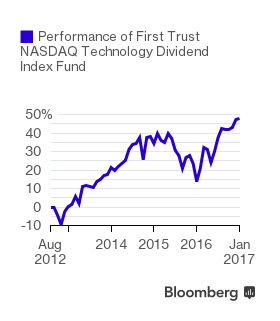 . It rose 3.6 percent for the three months ended Dec 31.
. It rose 3.6 percent for the three months ended Dec 31.
Invest in Corporate ‘Self-Help’
In this seemingly endless environment of economic stagnation, what will drive revenue and profit growth? Central banks may be running out of monetary solutions to stimulate credit and demand. While we wait for the political landscape to become less muddled, investors can get access to companies engaged in operational restructuring or “self-help.”
These companies, boasting strong balance sheets and modest levels of debt, typically have managements committed to a continuous and inexorable process of cost cutting and increased efficiency. In mobile telephony, especially in Japan, China, and South Korea, several of the largest listed companies have found increasingly ingenious ways to extract above-industry-average returns from the mature telecommunications market. [China Mobile Ltd. and SK Telecom Co. Ltd. were in the top 15 holdings of the Causeway International Value Fund (CIVIX), as of June 30.] Smart self-help moves by senior managements of these companies have led to a reduction in capital expenditures and operating costs.
These companies are typically creating innovative and value-added services, introducing popular data plans and benefiting from supportive local regulations. Similarly, in the more mature segment of technology, “legacy tech” companies also have managements committed to reinvigorating growth. Even though these companies have valuable proprietary technology, sell-side analysts put some of them in the dinosaur category. But the analysts often take a short-term view. Market pessimism can give investors a chance to buy world-class technology franchises in transition.
For example, large enterprise software companies must make a successful transition from an on-premises licensing business model to a cloud-computing subscription-based model. Semiconductor companies currently expert in mobile wireless technology are making measurable progress to deliver next-generation technology. Look for efficient operations, focused and shareholder-friendly managements, as well as inherent advantages in research and development expertise and resulting defendable intellectual property. [SAP and Samsung Electronics are CIVIX holdings.]
Economic malaise aside, these great companies, albeit often labeled mature and in transition, still trade at valuations that imply the potential for above-market returns.
Way to play it with ETFs: The First Trust NASDAQ Technology Dividend Index Fund (TDIV)  holds tech companies that pay the highest dividend, which means it has the largest percentage of “legacy tech” names such as Intel Corp., Microsoft Corp., Cisco Systems Inc., and Oracle Corp. This “I love the 90s” portfolio has the lowest volatility, lowest average price-to-earnings ratio, and highest dividend yield of the technology ETFs.
holds tech companies that pay the highest dividend, which means it has the largest percentage of “legacy tech” names such as Intel Corp., Microsoft Corp., Cisco Systems Inc., and Oracle Corp. This “I love the 90s” portfolio has the lowest volatility, lowest average price-to-earnings ratio, and highest dividend yield of the technology ETFs.
Performance of last quarter’s ETF plays: The ETF Balchunas chose to track Ketterer’s advice back in June was The WisdomTree Japan Hedged Equity Fund (DXJ) 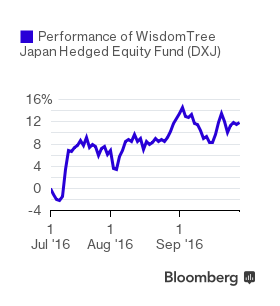 . It rose 11 percent for the three months ended Sept. 30.
. It rose 11 percent for the three months ended Sept. 30.
Play Japan
Something interesting is happening in the Land of the Rising Sun. The Japanese equity market has slipped 20 percent from its five-year high, reached last August, reflecting an economy unresponsive to monetary stimulus. Despite this gloom, many Japanese companies have the financial wherewithal to reward shareholders with dividends.
As of late May, over 200 Japanese stocks with market caps above $1 billion also have dividend yields greater than 2 percent (several offer yields of 4 percent), with dividend payout ratios less than 50 percent. In other words, these dividends should be well covered by earnings, and (thanks to the low payout ratios) have room to grow.
Some of the best-managed companies with generous dividends include Sumitomo Mitsui Financial Group Inc. (4 percent yield), Japan Airlines Co. (3 percent), Komatsu Ltd. (3 percent), KDDI Corp., and Hitachi Ltd. (both 2.5 percent). Bonds can’t compete. The 10-year Japanese government bond yield is negative, making generous dividends all the more appealing.
In the U.S., investor demand for high-dividend-yielding stocks, and exchange-traded funds that track such stocks, has risen sharply in our own prolonged low-interest-rate environment. Perhaps the same will happen in Japan. Mrs. Watanabe, the proverbial Japanese retail investor, wants income. It may make sense to own some of these income-generating, better-quality Japanese stocks before she does.
Ways to play it with ETFs: The WisdomTree Japan Hedged Equity Fund (DXJ) 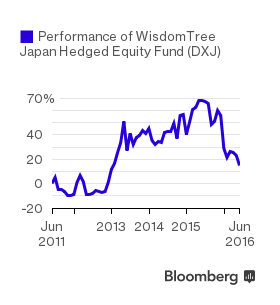 goes long the stocks mentioned by Ketterer, and many more, said Balchunas. It also shorts—bets against—the yen, and weights stocks by the size of their dividend. It yields 3 percent.
goes long the stocks mentioned by Ketterer, and many more, said Balchunas. It also shorts—bets against—the yen, and weights stocks by the size of their dividend. It yields 3 percent.
Terri Spath
Chief investment officer, Sierra Mutual Funds
Look Abroad
Volatility has become a staple of 2020, and wild swings are unnerving — but that’s not necessarily a bad thing.
This year has tested investor resolve like rarely before. Fear and uncertainty associated with the pandemic sent investors fleeing everything from tech stocks to municipal bonds, and the quickest bear market decline in history was followed by the fastest rally on record early in the year.
Whether you are looking to diversify or for new avenues of growth, international stocks are the answer. The prospect of accelerating growth over the long term, increasing productivity, and growing standards of living support a thesis that the world’s strongest advance will come outside U.S. borders.
A weakening U.S. dollar also gives life to foreign stocks. Research shows that in the years when the American currency is relatively weak, shares abroad go up 85% of the time.
Broadly, the iShares MSCI Emerging Markets ETF (EEM) tracks over 800 large- and mid-sized companies in China, Taiwan, Korea, India and more. We recommend going a step further and focusing on exposure to Taiwan via iShares MSCI Taiwan ETF (EWT) and India via WisdomTree Indian Earnings Fund (EPI). These two countries offer terrific demographics and the ETFs participate in ample exposure to technology companies. Strong growth and favorable industry exposure combine for promising opportunities for investors.
How to play it with ETFs: Even after a relatively strong first half, the iShare MSCI Taiwan ETF (EWT)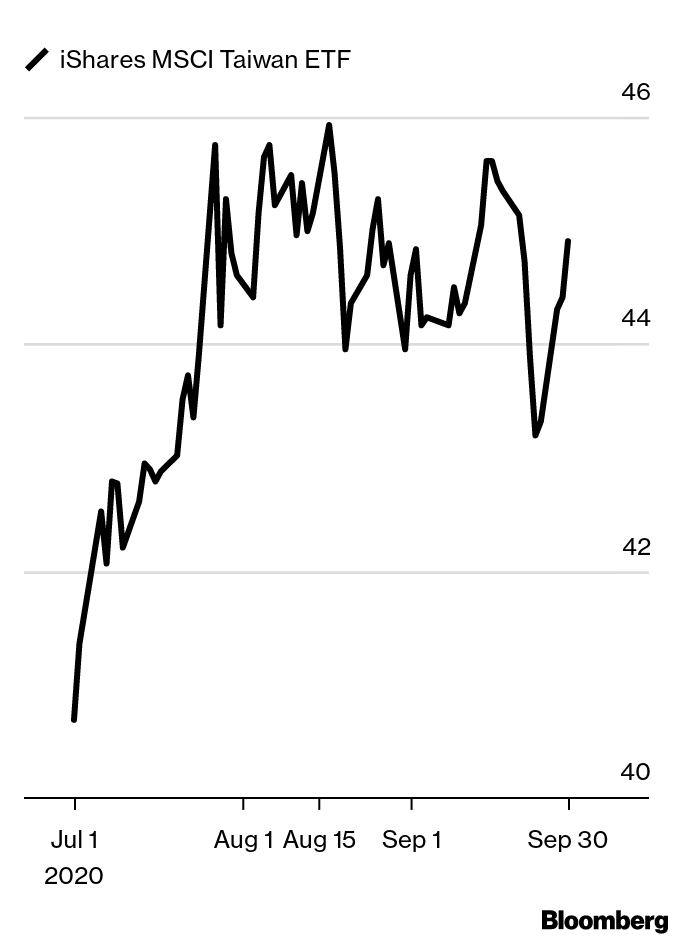 could have room to run. Its 12-month forward earnings-per-share growth, led by cyclical stocks, is north of 23% on 9.7% sales growth, according to Bloomberg consensus estimates. The expense ratio is 0.59%.
could have room to run. Its 12-month forward earnings-per-share growth, led by cyclical stocks, is north of 23% on 9.7% sales growth, according to Bloomberg consensus estimates. The expense ratio is 0.59%.
Performance of last quarter’s ETF plays: The iShares Convertible Bond ETF (ICVT)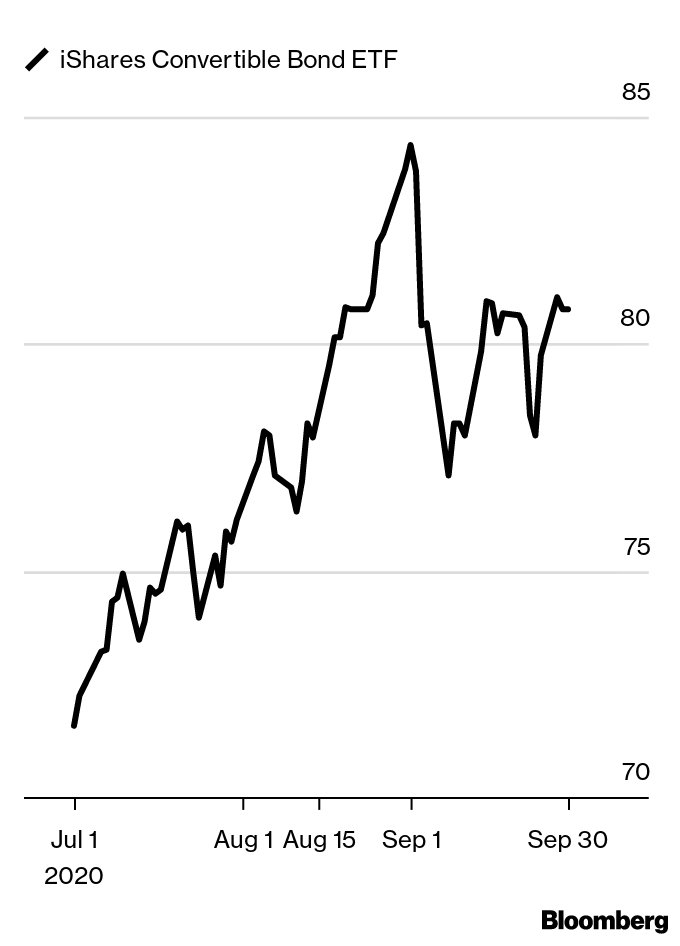 rose 15%.
rose 15%.
Hop Into a Convertible
The Federal Reserve has said that it will do whatever it takes, igniting a stampede into stocks. The most common question we have fielded recently is why the S&P 500 has recovered to January 2020 levels when economic growth has contracted, millions are out of work and default rates are surging. The economic data is awful, but the Fed has proclaimed that the printing presses are rolling and they are ready for a shopping spree.
The disconnect presents a perfect storm. The sharp snapback in recent months increases the probability of volatility and painful losses in the future. To play defense, we see convertible bond funds as a good place to put $10,000 now. These are bonds that can be converted into stock at a specific price.
Historically, convertibles have offered equity sensitivity on the upside while cushioning downside risk by paying income. Getting exposure through a mutual fund gives diversification as well as access to potential alpha created by the portfolio manager. We recommend several opportunities in the convertible bond universe. Top picks are Columbia Convertible Securities Fund (PACIX) and Calamos Convertible Fund (CCVIX). There is also an iShares Convertible ETF (ICVT) for investors that prefer using ETFs.
How to play it with ETFs: Balchunas also points to the iShares Convertible Bond ETF (ICVT)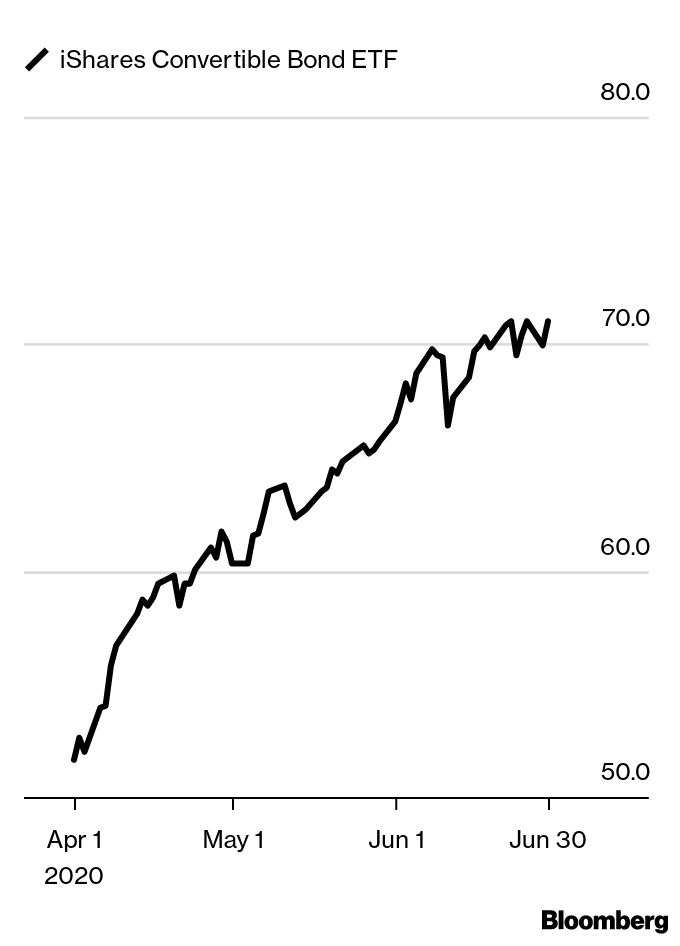 , which has an expense ratio of 0.20%. The fund has over 38% in software and internet companies, darlings of this year’s rally.
, which has an expense ratio of 0.20%. The fund has over 38% in software and internet companies, darlings of this year’s rally.
Performance of last quarter’s ETF plays: The First Trust Tactical High Yield ETF (HYLS)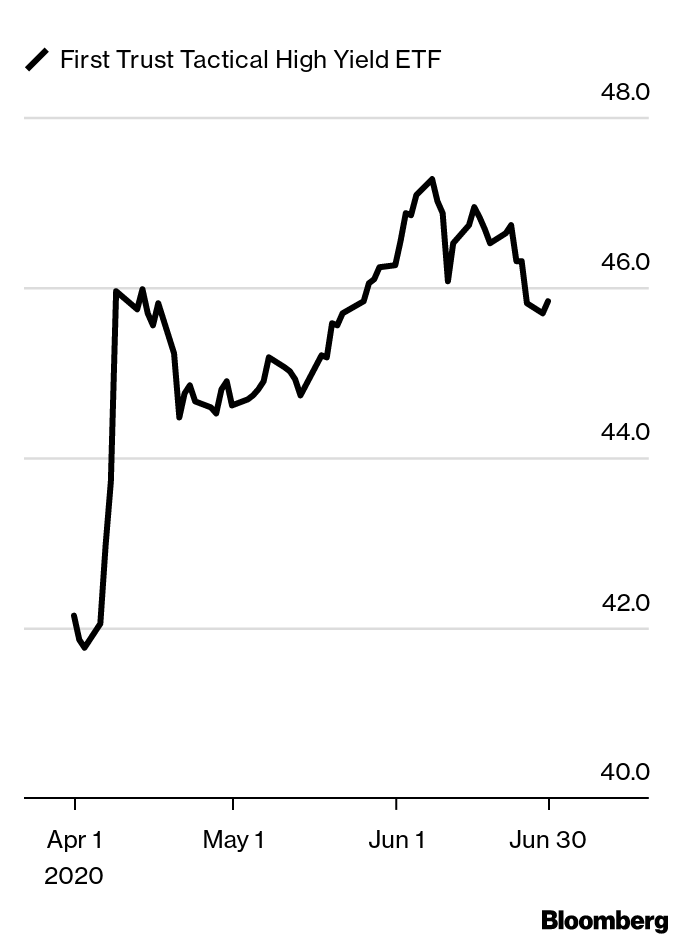 and the iShares Broad USD High Yield Corporate Bond ETF (USHY)
and the iShares Broad USD High Yield Corporate Bond ETF (USHY)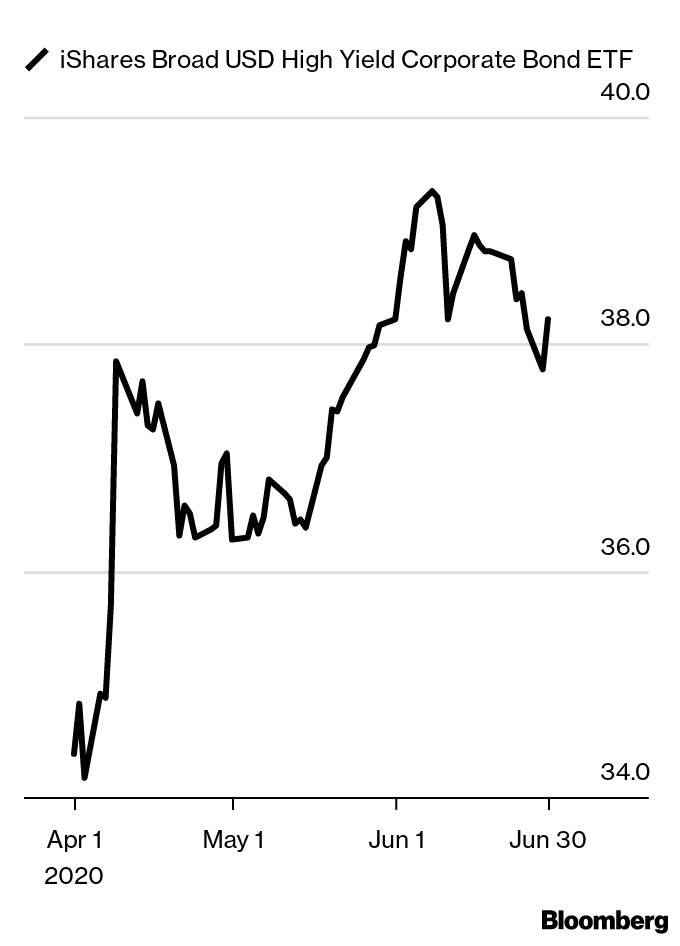 saw gains of 6.4% and 7.9%, respectively.
saw gains of 6.4% and 7.9%, respectively.
Look to High Yield
Like a black swan flying against a dark night sky, the Covid-19 virus arrived without much warning, affecting our personal and financial lives. The impact on nearly every asset class available was swift and brutal. The optimism that defined the start of a new decade quickly cycled to anxiety, denial and outright fear. While cities, states and the U.S. government issued stringent health guidelines, the Federal Reserve and Trump Administration committed to massive action to steady financial markets and the economy.
It is exactly in times like these where the question “Where to put $10,000?” seems like it deserves an answer of “Under the mattress!”
So we ask the same question a bit differently: When it comes time to buy, will you do it?
Panic is not a strategy. Hope is also not a strategy. Maximum financial opportunity coincides with maximum pessimism, according to legendary investor Sir John Templeton.
High-yield corporate bond spreads over comparable maturity U.S. Treasury bonds have widened to levels that historically have translated into great opportunity for investors with a medium- to long-term investment horizon. Investors in high yield are getting paid well for the risk taken over a “risk-free” U.S. bond issue.
Risk matters, and it is intriguing to know that in past periods of fear when high-yield corporate bonds have offered similar returns, the asset class has rebounded more quickly and outpaced U.S. stocks in the following months and even up to three years.
In a period when active management is more likely to outpace passive benchmarks, our top mutual fund picks are two Diamond Hill funds: Corporate Credit Fund (DHSTX) and High Yield Fund (DHHIX). We also like PIMCO’s High Yield Fund (PHYRX) for its recent rebound. After drawdowns in March, these funds are poised to gain with less risk than stocks and similar returns.
How to play it with ETFs: First Trust Tactical High Yield ETF (HYLS)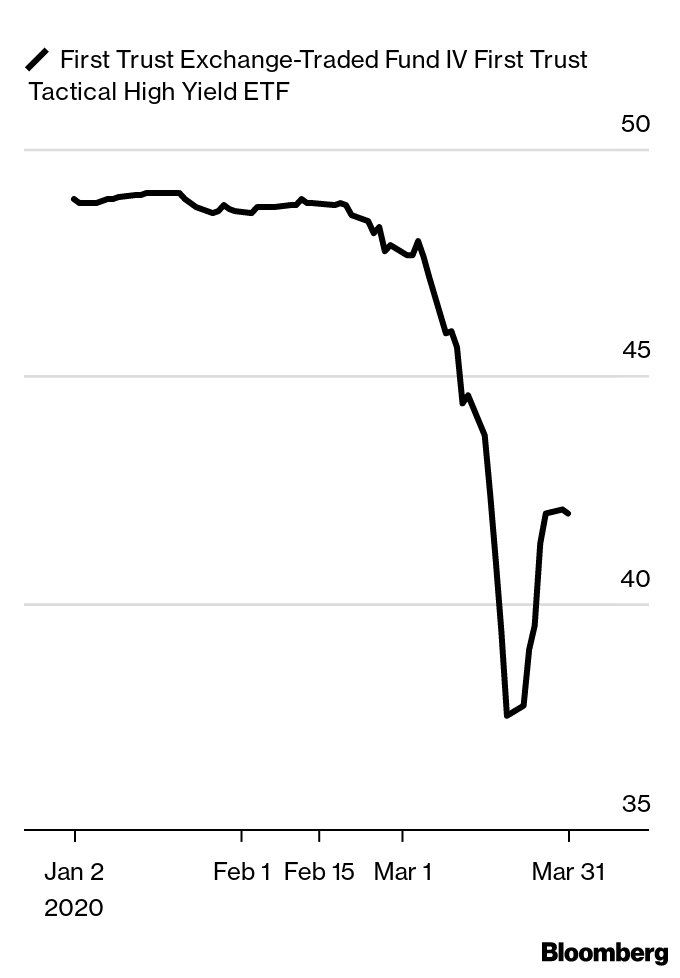 is an actively managed corporate high yield fund that has shown a better late March rebound than the iBoxx Liquid High Yield index. The $1.2 billion fund can have short positions for up to 30% of net assets and long positions up to 130%, opportunistically, with the ability to earn return on the short side. The fund charges 95 basis points. Alternatively, the iShares Broad USD High Yield Corporate Bond ETF (USHY)
is an actively managed corporate high yield fund that has shown a better late March rebound than the iBoxx Liquid High Yield index. The $1.2 billion fund can have short positions for up to 30% of net assets and long positions up to 130%, opportunistically, with the ability to earn return on the short side. The fund charges 95 basis points. Alternatively, the iShares Broad USD High Yield Corporate Bond ETF (USHY)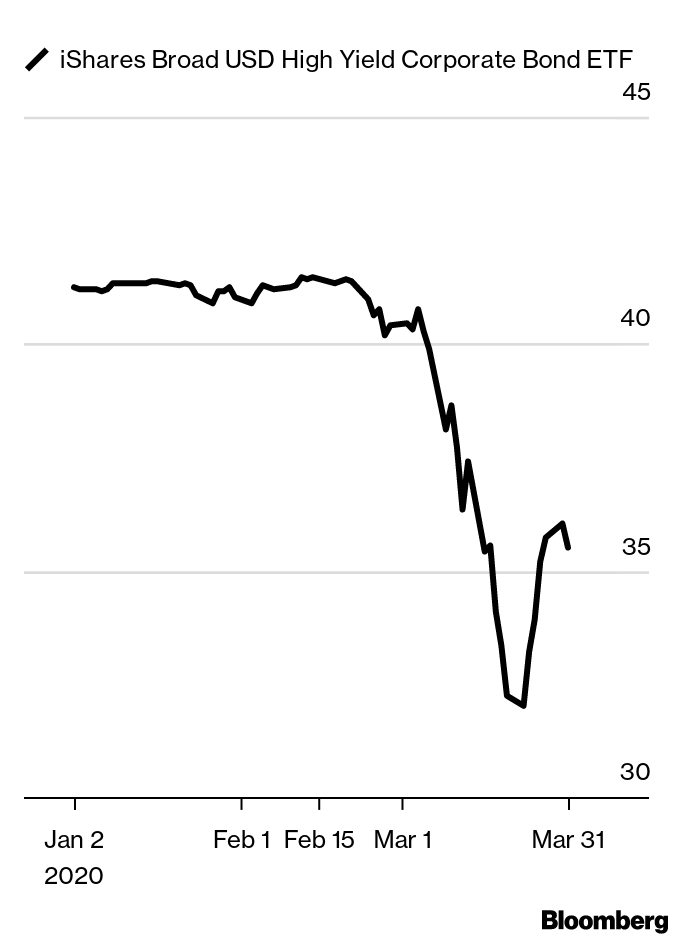 is a cheap-and-deep passive alternative holding 1,700 junk bonds and charging 0.15%.
is a cheap-and-deep passive alternative holding 1,700 junk bonds and charging 0.15%.
Performance of last quarter’s ETF plays: The Davis Select International ETF (DINT)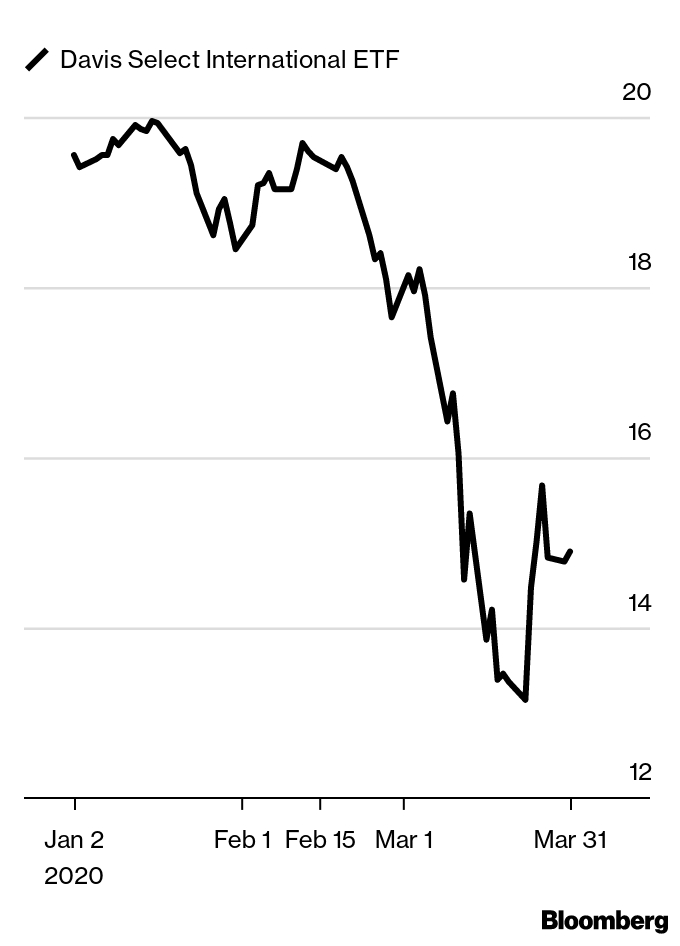 saw a price drop of 21.7%.
saw a price drop of 21.7%.
Take Your Money Abroad
After a decade of relative underperformance, international stocks are staging a stealth rally and mark our top pick for new money. International stocks offer diversification to a domestically dominated stock portfolio, but that’s not the main reason why we recommend readers put their $10,000 to work outside U.S. borders. Recently, we’ve seen stronger uptrends in international stocks than for domestic ones and the risk, as measured by historic volatility, is similar. We see this as promising and recommend investors pay attention to opportunities abroad.
Last year, nothing seemed to move global equities markets more often or with more tenacity than headlines renewing optimism or pessimism around U.S. and China trade talks. The Phase One U.S.-China deal in December propelled a late-year spike in global stocks and a banner year for global equities.
While trade challenges still exist, the needle is moving in the right direction and a resulting rebound in global economic growth would benefit international stocks. Further, systematic fiscal stimulus overseas is lurking on the horizon. Relative valuations are also low and can therefore offer more upside potential (and less downside risk).
While geographic diversification is generally a beneficial tactic, we warn against using passive benchmark-hugging exchange-traded funds. International stocks are an asset class where actively managed fund managers can consistently demonstrate alpha, or better risk-adjusted performance relative to a benchmark. A top pick of ours is Artisan Global Opportunities (ARTRX).
How to play it with ETFs: For those looking for that active approach, Balchunas says a steadily growing option is the Davis Select International ETF (DINT)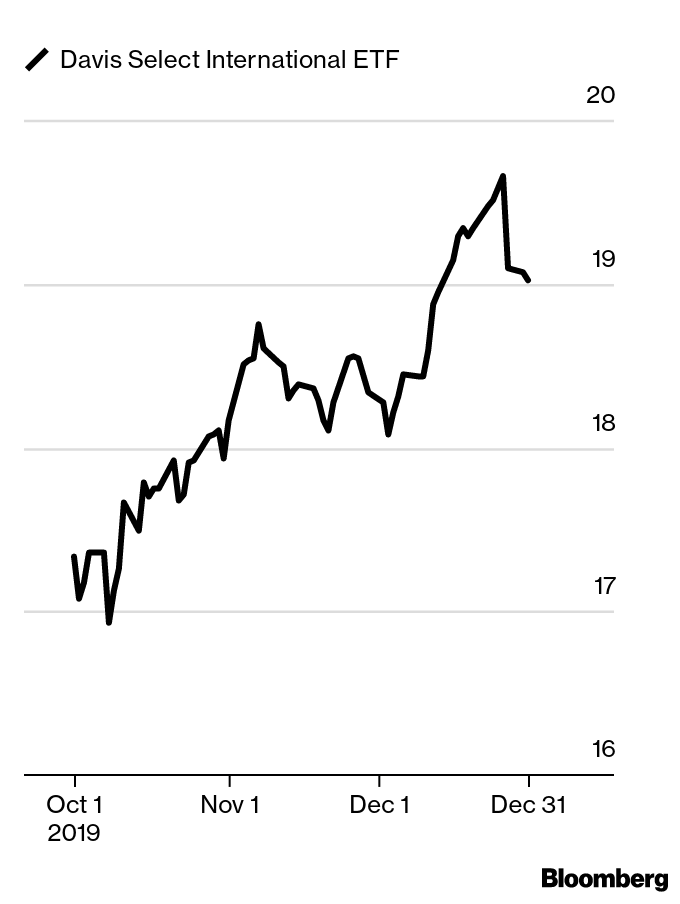 , which tracks a 31-stock basket of the manager’s best picks. That means there will be more volatility—which could be good or bad. It outperformed the ultra-popular ETF play in the area, the iShares Core MSCI EAFE ETF (IEFA)
, which tracks a 31-stock basket of the manager’s best picks. That means there will be more volatility—which could be good or bad. It outperformed the ultra-popular ETF play in the area, the iShares Core MSCI EAFE ETF (IEFA) , over the past 12 months. You have to pay up for DINT, as it charges 0.75% to IEFA’s 0.07%.
, over the past 12 months. You have to pay up for DINT, as it charges 0.75% to IEFA’s 0.07%.
Performance of last quarter’s ETF plays: The price of the Franklin Liberty High Yield Corporate ETF (FLHY)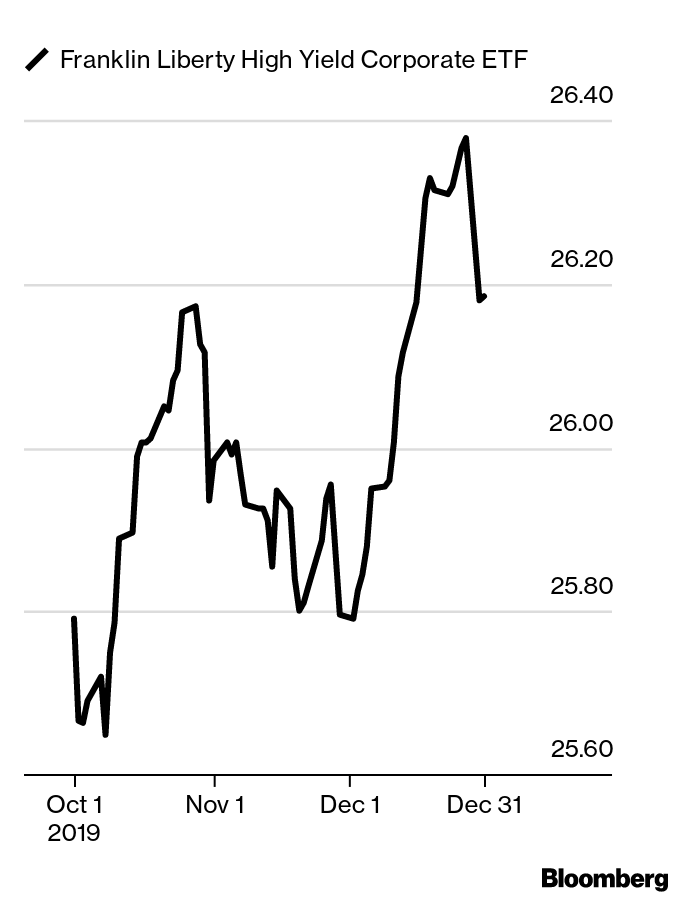 rose 1.5% and it had a 3.1% total return for the quarter.
rose 1.5% and it had a 3.1% total return for the quarter.
Lower for Longer —Or Forever
Lower for longer is fast turning into lower forever.
Lower for longer was a phrase coined several years ago as interest rates stayed at historically low levels for longer than nearly anyone had predicted. It may be time to expect lower forever.
Here are a few facts to consider:
- Over 30% of investment-grade global debt, more than $17 trillion, bear sub-zero yields. This means that all else equal, the borrower of the debt will owe less than was originally borrowed.
- Austria recently issued 100-year debt at a 1.2% yield.
- The $27.8 trillion of non-U.S. dollar investment grade global debt is yielding 0.11%.
Here in the U.S., the yield on the 10-year Treasury is 1.53% versus 1.94% for the S&P 500. It’s as though investors are buying stocks for yield and bonds for capital appreciation (which results as interest rates fall).
Except that stocks have far worse downside risk than bonds. A favorite adage is that “a bad day in the stock market is a bad year for the bond market.” A better way to earn income in bonds with less risk than stocks is to hold high-yield corporate bond funds.
We recommend that readers with $10,000 to invest put that in an actively managed high-yield corporate bond fund. High-yield corporate bonds are kicking off as much as 6%, which is downright juicy in this “lower forever” environment. An actively managed mutual fund, or even a passive ETF such as the SPDR Bloomberg Barclays High Yield Bond ETF (JNK) or the iShares iBoxx High Yield Corporate Bond ETF (HYG) diversifies over hundreds and sometimes thousands of bonds to substantially reduce risk and the impact of any particular corporation defaulting on its obligation.
Earnings and cash flows are healthy and will support interest and bond payments for the foreseeable future. Like any investment, though, we recommend using a sell strategy to exit early when trends (inevitably) turn down. Our quantitative, rules-based approach uses banded moving averages that typically give a sell signal for lower- and medium-volatility asset classes within a few percentage points of a top price.
In a lower forever environment, economically solid high-yield corporate bond funds offer solid income with manageable risk.
How to play it with ETFs: The actively managed Franklin Liberty High Yield Corporate ETF (FLHY)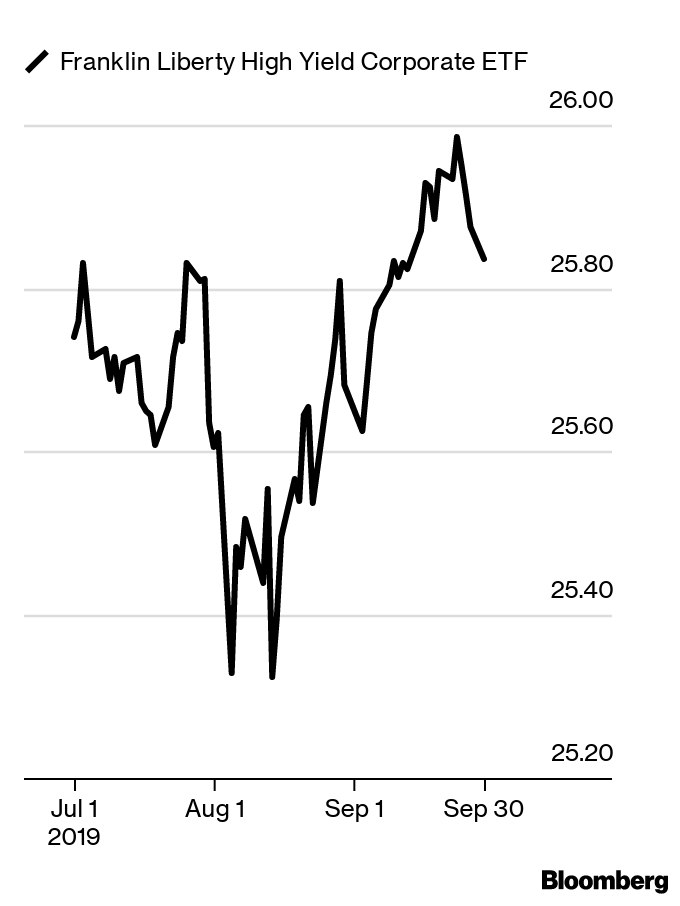 is outpacing the iShares iBoxx High Yield Corporate Bond ETF (HYG)
is outpacing the iShares iBoxx High Yield Corporate Bond ETF (HYG) by nearly 180 basis points for the year to date. The fund is diversified across sectors and issuers, with nearly 82% in U.S. corporate debt. The expense ratio is 0.40%.
by nearly 180 basis points for the year to date. The fund is diversified across sectors and issuers, with nearly 82% in U.S. corporate debt. The expense ratio is 0.40%.
Performance of last quarter’s ETF plays: WisdomTree Emerging Markets Corporate Bond Fund (EMCB) rose 0.1% for the quarter.
rose 0.1% for the quarter.
Target Emerging Market Debt
U.S. stock and bond markets are in a state of confusion. The S&P 500 and other benchmark indices for U.S. stocks are tapping on new all-time highs, anticipating a soft landing for the economy, engineered with finesse by the Federal Reserve. The U.S. bond market seems much more concerned—there is nothing normal about a 10-year Treasury bond below 2% and a 90-day Treasury bill above 2%. More daunting is that this relationship in yields has historically signaled negative economic growth in the near future.
The confusion in financial markets has, and surely will, contribute to further uncertainty and volatility. Managing volatility, or risk, is one of the few things investors can control. For these reasons, we favor emerging markets debt over emerging markets equity, and recommend that readers with $10,000 to invest put that in an actively managed emerging markets debt fund (EMD).
Why EMD? The asset class is currently, and often has been, overlooked—and it shouldn’t be. The global economy is growing, albeit at a slower rate than last year at this time, but growing. At the same time, debt-to-GDP ratios are stronger across the board for emerging countries over developed ones, a fact that has been largely missed. Also, yields for EMD funds are at least 5%, offering a built-in return if prices remain stable.
EMD also has a lower correlation to more traditional asset classes like stocks or bonds, providing strong diversification. Against a backdrop where U.S. asset classes are acting confused, EMD has delivered steady returns with low volatility. This isn’t limited to the U.S. Over the past year, emerging markets equities have lost money (based on EEM, the iShares MSCI Emerging Markets ETF) and shocked with an almost 20% drawdown. EMD is up more than 10% (based on EMB, the iShares J.P. Morgan USD Emerging Markets Bond ETF) on a generally smooth ride. More return, less risk.
The key to successful investing in EMD is to use an actively managed mutual fund. The performance of any particular developing country can be vastly different—what is impacting Russia can be very different than what is driving Turkey. An active manager can guide a portfolio more effectively than a benchmark that is required to hold the best and the worst securities. An actively managed fund will also hold hundreds of bonds, allowing far greater diversification than an individual can achieve through an individual portfolio.
Our top picks in EMD are DoubleLine Emerging Markets Fixed Income Bond fund (DBLEX) and MFS Emerging Markets Debt Fund (MEDIX). For those with a view of a weakening dollar, PIMCO Emerging Markets Local Currency and Bond Fund (PELBX) looks great.
Way to play it with ETFs: Balchunas suggests WisdomTree’s Emerging Markets Corporate Bond Fund (EMCB)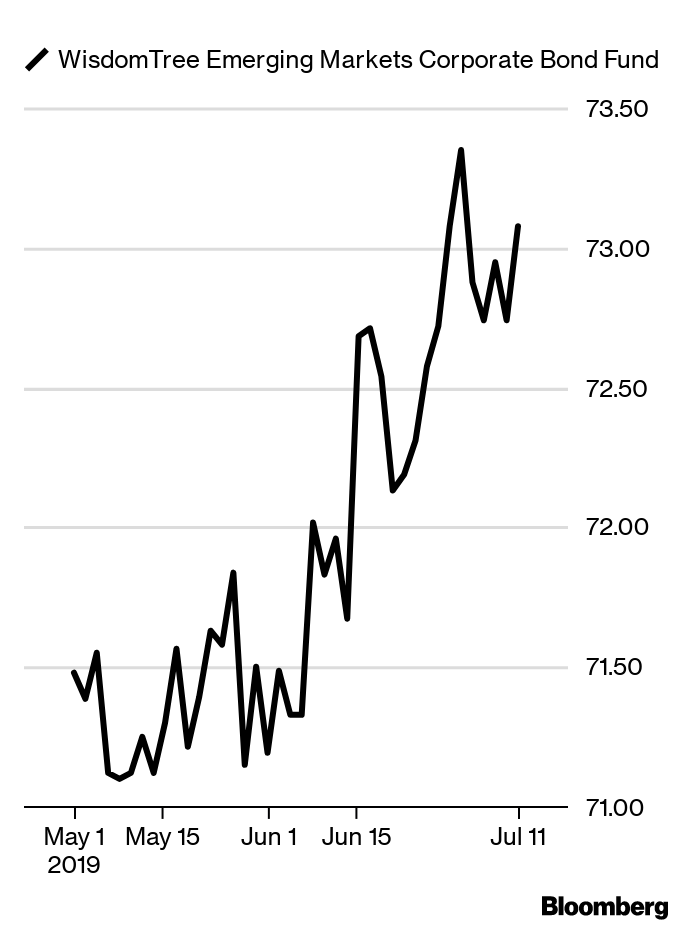 , which has gained near 10% year-to-date on both income and capital appreciation from corporate issuers. The geographic exposure spans Luxembourg, Netherlands, Mexico, Turkey and India, among others. The fund has broad industry diversification and maturity range, and a 0.60% fee.
, which has gained near 10% year-to-date on both income and capital appreciation from corporate issuers. The geographic exposure spans Luxembourg, Netherlands, Mexico, Turkey and India, among others. The fund has broad industry diversification and maturity range, and a 0.60% fee.
Russ Koesterich
Portfolio manager, BlackRock Global Allocation Fund
Buy High-Quality Cyclicals
After being trounced by growth stocks — such as tech companies — during both the market selloff and subsequent rebound this year, cyclical stocks are starting to have their day. There are at least two arguments for rotating into them: The economy is doing much better than expected, and these shares are playing catch-up with the rest of the market.
In recent months, economic data has been exceeding expectations by the largest margin in at least a decade. Economic improvement provides a catalyst for closing a yawning performance gap. For the year-to-date, the S&P 500 is up 3.6%, while tech stocks have gained about 26%. By contrast, shares of industrial companies are down more than 4%.
When thinking about adding cyclicals, emphasize quality, not deep value. Remain leery of piling into secularly challenged industries — whose long-term growth are uncertain — such as energy. Instead, focus on niche areas with long-term pricing power, such as rails and specialty chemicals. Another way to play the theme is to focus on areas where cyclical and secular growth intersect, such as semiconductors.
The lesson here is to be discerning. A recovering economy supports cyclicals, but emphasize companies with earnings consistency and high profitability.
How to play it with ETFs: Balchunas suggests the Invesco Dynamic Semiconductors ETF (PSI)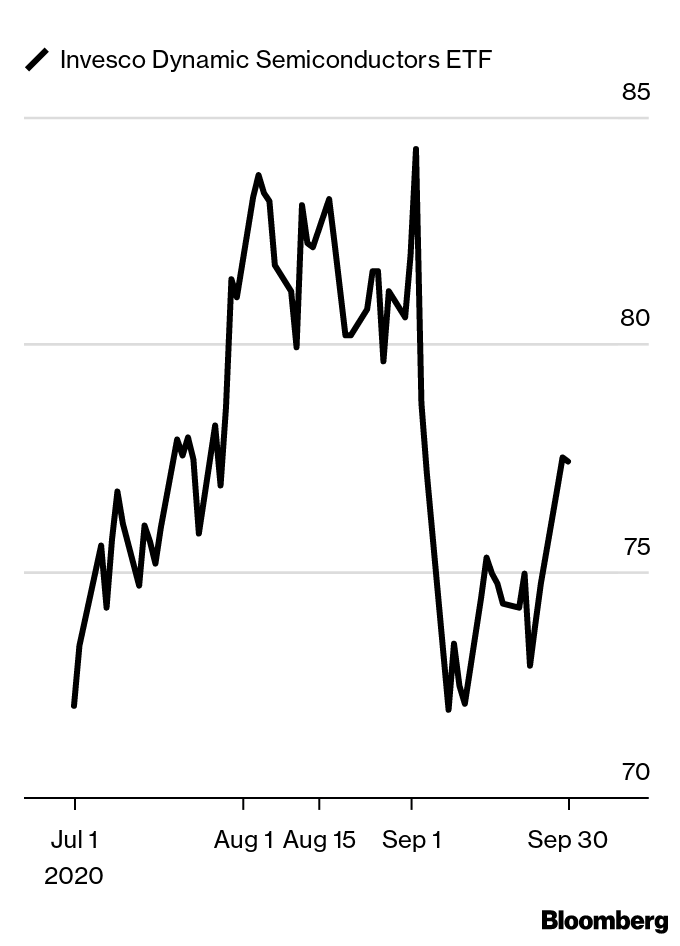 . It caps holdings at 30 semiconductor producers and adjusts them using fundamental quality and momentum criteria. The expense ratio is 0.61%.
. It caps holdings at 30 semiconductor producers and adjusts them using fundamental quality and momentum criteria. The expense ratio is 0.61%.
Performance of last quarter’s ETF plays: Balchunas’ suggestion, the iShares MSCI USA Momentum Factor ETF (MTUM)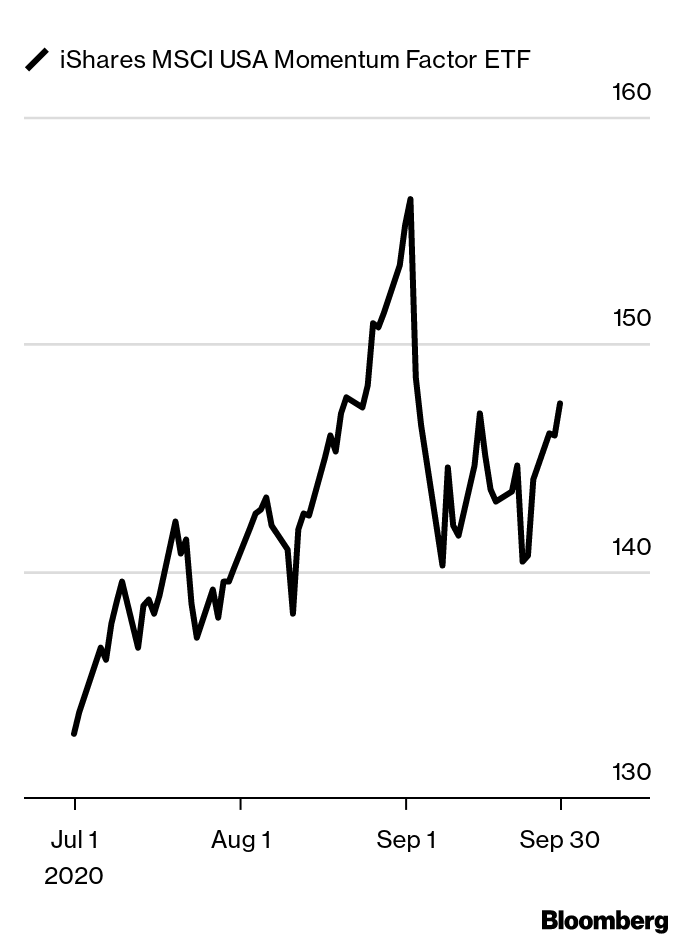 , was up 12.4% in the third quarter.
, was up 12.4% in the third quarter.
Go With the Flow
Even as the pandemic subsides, both unemployment and savings are likely to remain elevated, and value investing — where you focus on beaten-down assets seen as relative bargains — is likely to struggle. Value-style investing typically works at the bottom, because investors anticipate a strong recovery on the back of pent-up demand. Today, circumstances are very different, with a lot of uncertainty and what’s likely to be an uneven recovery.
But momentum investing — or following an existing market trend — is likely to thrive, as it benefits from the policy reaction to volatility: more liquidity. Historically, rapid growth in liquidity has favored momentum, particularly compared with strategies like value investing.
While the long-term impact of the Covid-19 pandemic is hard to predict, it is not difficult to imagine an acceleration in trends that were already evident prior to the crisis: internet commerce, cloud computing, social media and more time and money spent online.
Most momentum portfolios or funds are overweight industries that aren’t affected too much by short-term factors: technology and increasingly healthcare, specifically biotech. To the extent these segments are more insulated, and in some cases stand to benefit from longer-term structural changes, this may further favor the style.
How to play it with ETFs: Balchunas suggests the iShares Edge MSCI USA Momentum Factor ETF (MTUM)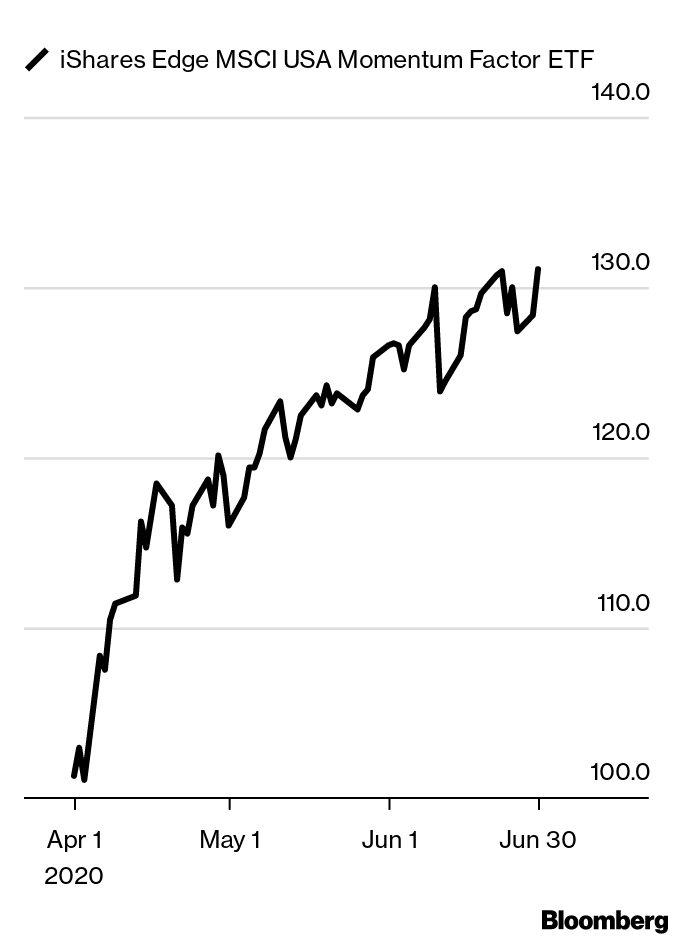 , which holds some of the largest tech companies. The ETF caps each position at 5%, so may book gains as the big get bigger. The expense ratio is 0.15%.
, which holds some of the largest tech companies. The ETF caps each position at 5%, so may book gains as the big get bigger. The expense ratio is 0.15%.
Performance of last quarter’s ETF plays: The SPDR Gold MiniShares Trust (GLDM)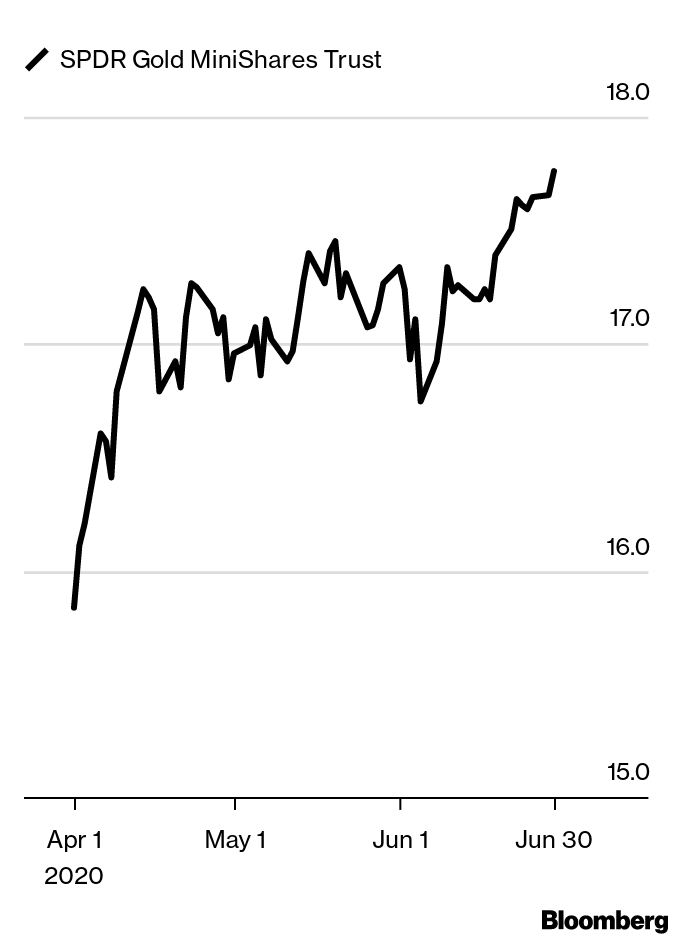 and SPDR Gold Shares (GLD)
and SPDR Gold Shares (GLD)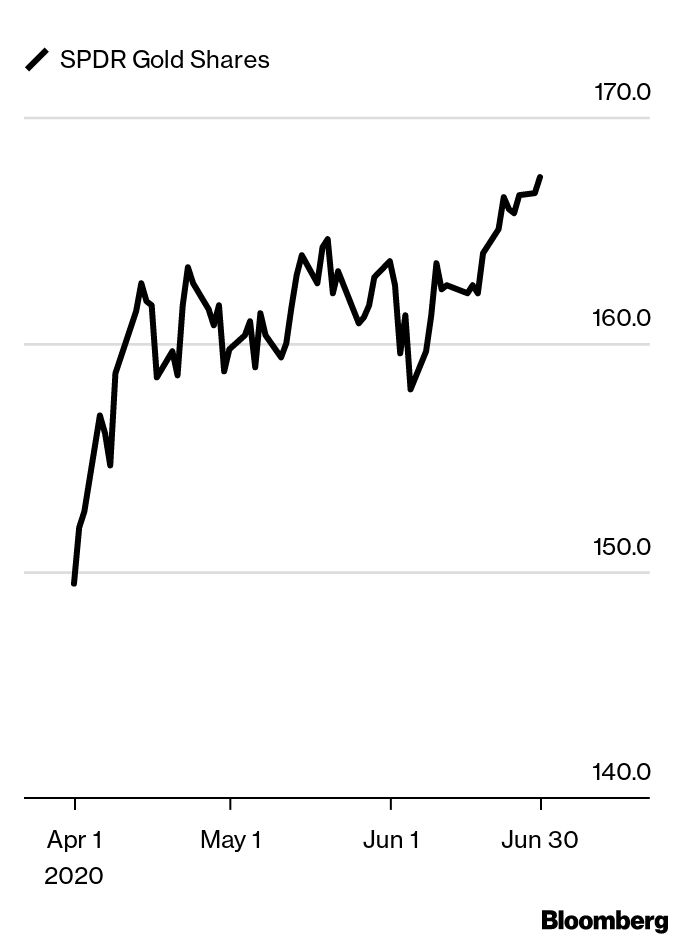 both rose 9.8%.
both rose 9.8%.
Insulate with Gold
Given the human and economic toll that the Covid-19 virus has already extracted, it’s not surprising that just five major asset classes posted gains in the first quarter. Apart from classic safe havens — U.S. Treasuries and German Bunds — the list includes two currencies — the yen and the U.S. dollar — as well as gold.
While we can only hope that the second quarter is less painful than the first, investors need to continue to look for ways to insulate portfolios even as they start to venture back into stocks. While no hedge works in all circumstances, given the current combination of record central bank stimulus, a rapid and unprecedented drop in economic activity and negative real interest rates, investors should look to increase exposure to gold.
With all central bank interest rates at or near zero, the dollar is likely to be contained. After initially surging on foreign demand, the dollar has pulled back into its long-term range. This is important as gold’s efficacy as a hedge is partly a function of the dollar. Gold tends to perform best when the dollar is flat-to-down.
Growth expectations are collapsing, and while often viewed as an inflation hedge, gold performs best when investors are worried about too little growth. Historically, gold has risen the fastest when forward-looking economic measures, such as manufacturing surveys, are falling rapidly. This is exactly the situation we’re in today.
Real (inflation-adjusted) interest rates are negative and likely to stay that way. As an asset class that produces no income, gold typically suffers when real rates are high. In these environments, investors sell gold as they’re unwilling to forego the opportunity cost of lost income. Today we have the exact opposite: U.S 10-year real yields are -0.30%, down roughly 0.90% in barely a month. In an environment in which bond yields are close to zero, and decidedly negative after inflation, there is no opportunity cost to holding gold.
How to play it with ETFs: Balchunas points to the SPDR Gold MiniShares Trust (GLDM)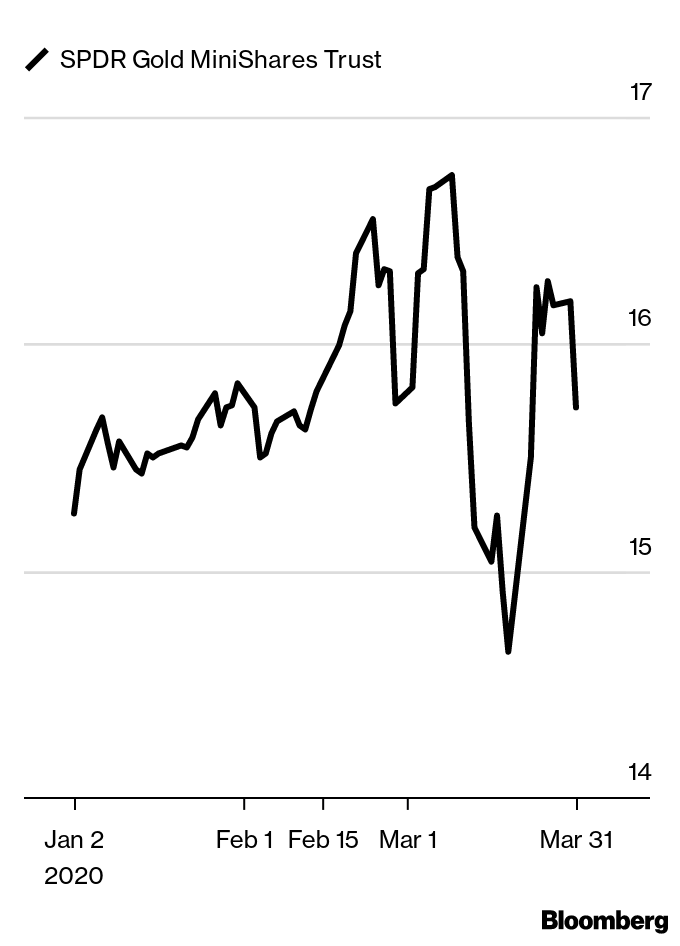 as a way to gain exposure to the price of gold in a lower-cost ETF designed for retail investors. Its 18-basis point expense ratio is less than half that of SPDR Gold Shares (GLD)
as a way to gain exposure to the price of gold in a lower-cost ETF designed for retail investors. Its 18-basis point expense ratio is less than half that of SPDR Gold Shares (GLD) , which commands a higher fee for the liquidity it offers institutional investors. GLDM has $1.8 billion in assets.
, which commands a higher fee for the liquidity it offers institutional investors. GLDM has $1.8 billion in assets.
Performance of last quarter’s ETF plays: The Vanguard Consumer Discretionary ETF (VCR)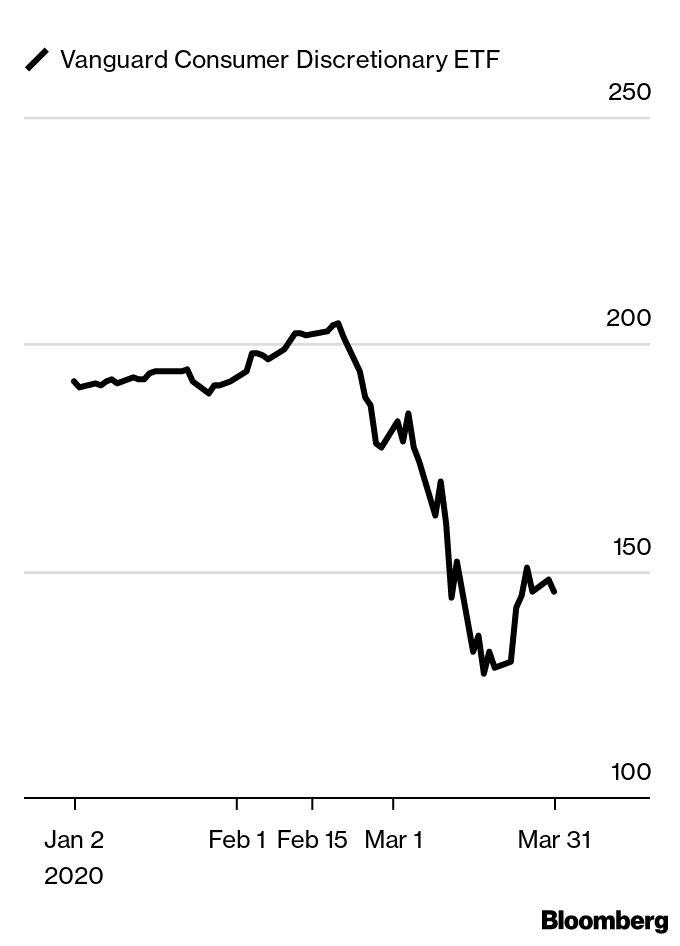 and Amplify Online Retail ETF (IBUY)
and Amplify Online Retail ETF (IBUY)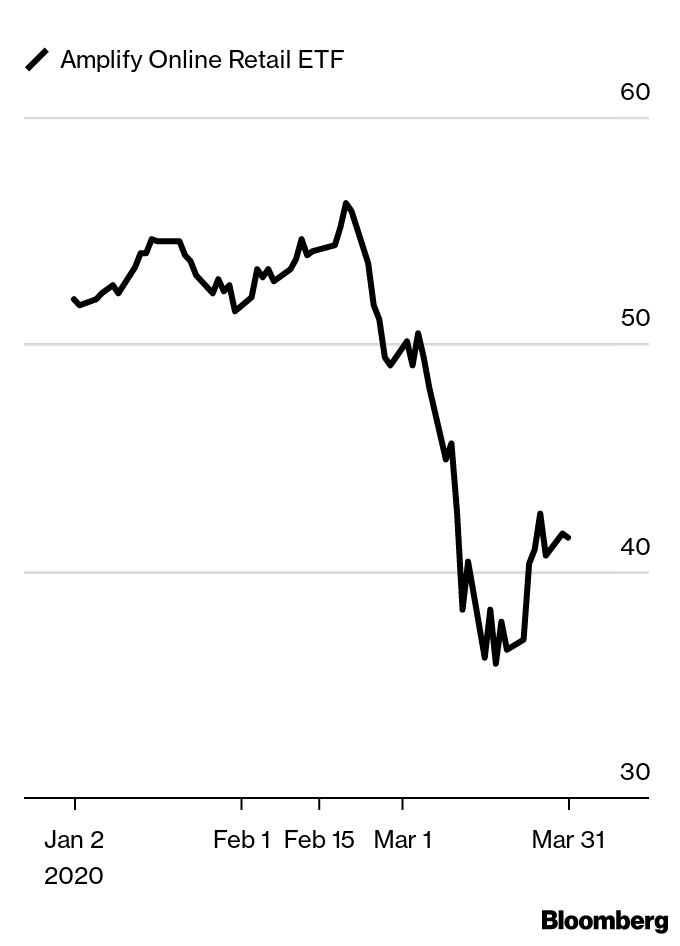 fell 23.3% and 19.2%, respectively, in the first quarter.
fell 23.3% and 19.2%, respectively, in the first quarter.
Focus on the U.S. Consumer
Two pillars continue to support the economy and markets: central banks and the U.S. consumer. While U.S. households never quite regained the housing-induced elation of the aught years, consumption continues to support not only the U.S. economy, but the global one as well. It also suggests that investors consider overweighting U.S. consumer discretionary companies in 2020.
The biggest factor supporting consumer stocks is a surprisingly healthy household sector. While over-indebted homeowners were at the epicenter of the last recession, things are very different today. Job growth remains robust and real incomes continue to rise. In fact, real personal consumption has been growing every quarter since the end of 2009. And unlike in the aught years, when consumers regularly stretched themselves and savings rates plunged, today’s spending is more sustainable. The personal savings rate is nearly 8%, above the 40-year average and more than double the level from 2007.
Not only are consumer income statements in better shape, balance sheets are cleaner as well. Debt-to-disposable income, an early warning signal in ’07, stands at an 18-year low. Thanks to low interest rates, not only is debt lower relative to income but the cost of servicing that debt is the lowest in decades.
As for the companies, while not cheap at nearly 25 times trailing earnings and 22 times next year’s earnings, the sector’s valuation premium is justified. There are clearly some dinosaurs unlikely to survive the next decade, but overall the consumer sector is extremely profitable, with a return on equity of 30%, the highest of all 11 global industry classification sectors.
To be sure, there is turmoil below the surface. Since the turn of the millennia, spending on travel, recreation and the internet has steadily grown at the expense of household goods and cars. Not only are spending patterns changing, shopping habits are evolving even faster. That said, few segments of the global economy look as promising as the one closest to home.
How to play it with ETFs: Eric Balchunas points to the $3.1 billion Vanguard Consumer Discretionary ETF (VCR)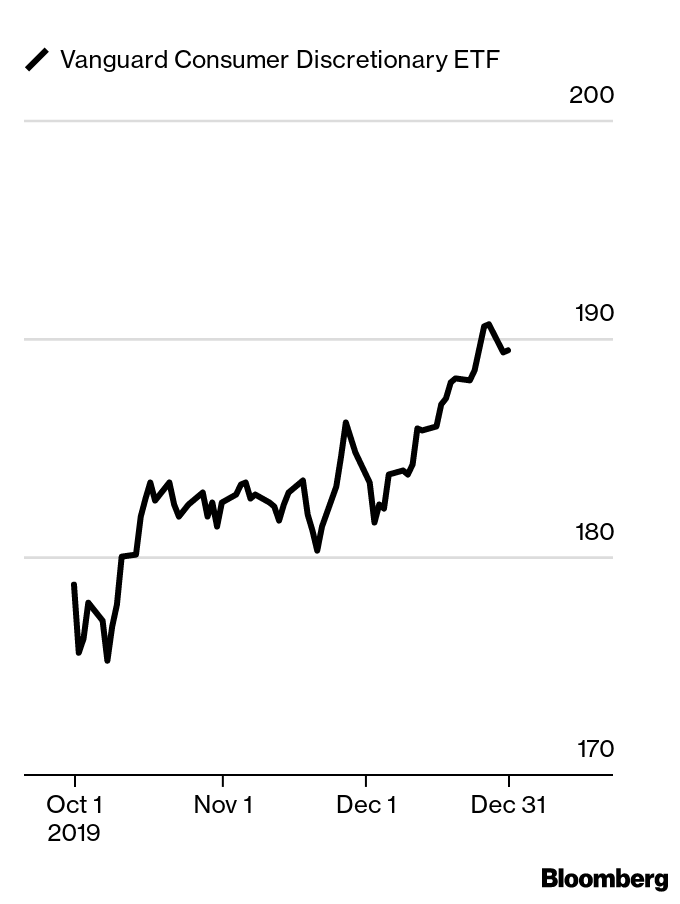 as a solid cheap-and-deep play. It holds stocks like Amazon, Home Depot and Nike and has a fee of 0.10%. A more targeted option is the Amplify Online Retail ETF (IBUY)
as a solid cheap-and-deep play. It holds stocks like Amazon, Home Depot and Nike and has a fee of 0.10%. A more targeted option is the Amplify Online Retail ETF (IBUY) , which equal-weights e-commerce companies such as Chewy, Peloton Interactive and EBay. It has $249 million in assets and a fee of 0.65%.
, which equal-weights e-commerce companies such as Chewy, Peloton Interactive and EBay. It has $249 million in assets and a fee of 0.65%.
Performance of last quarter’s ETF plays: Balchunas chose the Xtrackers Harvest CSI 300 China A-Shares ETF (ASHR)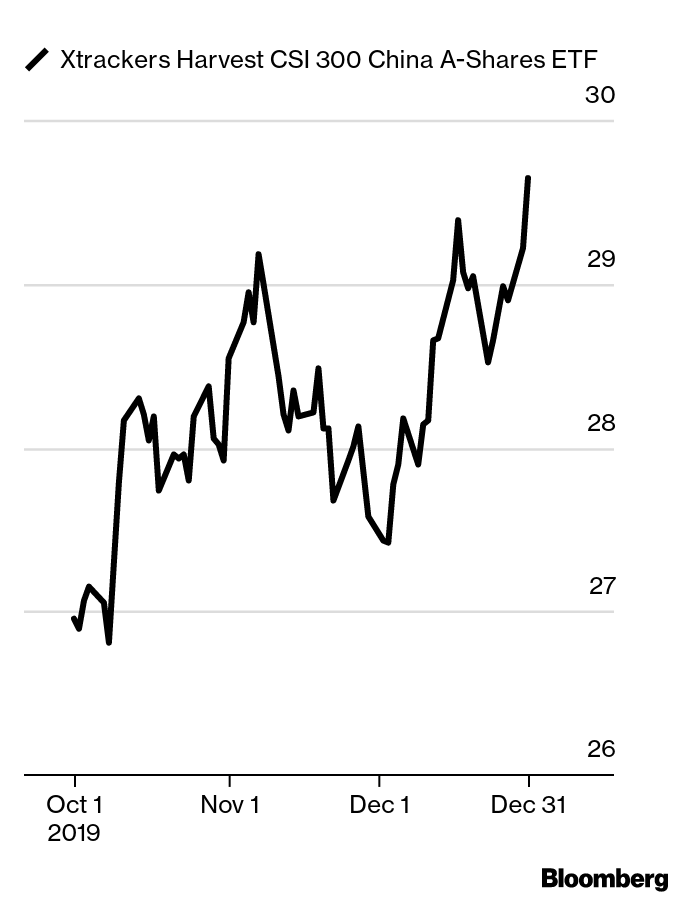 as a way to play Koesterich’s China theme last quarter. Its price rose nearly 9% in the fourth quarter.
as a way to play Koesterich’s China theme last quarter. Its price rose nearly 9% in the fourth quarter.
Investing in the Eye of the Storm
For the most part, 2019 has been a stellar year for stocks. To the extent there have been episodic bouts of volatility, they have been brief and quickly reversed. That said, the source of the volatility has been fairly consistent: China. Whether due to the day-to-day vagaries of the trade war or longer-term concerns over growth and decoupling, China has been the most common source of investor angst. Given this dynamic, investing in China seems like an odd call. But as any storm watcher knows, the safest place to be is often in the eye of the storm. Here are three reasons to consider investing in Chinese equities:
- China is very cheap. Given the longevity of the bull market and a sustained period of low interest rates, few asset classes look really cheap on an absolute basis. Chinese stocks are the exception to this rule. The China H Shares Index, i.e. Chinese companies listed in Hong Kong, is trading at roughly 8.5 times forward earnings.
- China is becoming more of a domestic consumption play. To the extent there is a silver lining in the trade war, it is the ongoing Chinese evolution towards more domestic consumption. This trend supports the increasing share of Chinese stocks geared towards the consumer sector. Furthermore, to the extent the economy and stock market are more tied to local consumers, and less to global trade, the better for Chinese equities’ role as a diversifying asset.
- Coordinated easing is a tailwind. Last year Chinese equities, along with the broader emerging-market sector, struggled with tightening financial conditions. This trend has swiftly reversed. The European Central Bank has reignited its bond-buying program while the Federal Reserve is lowering rates and no longer shrinking its balance sheets. Looser monetary conditions and easier overall financial conditions create a more favorable backdrop for developing market assets.
Make no mistake, this is a volatile market. Last year domestically listed A-shares fell roughly 30% from peak-to-trough. However, for investors willing to take some long-term risk, China looks like the rarest of things: a value play with the potential for growth.
How to play it with ETFs: Xtrackers Harvest CSI 300 China A-Shares ETF (ASHR)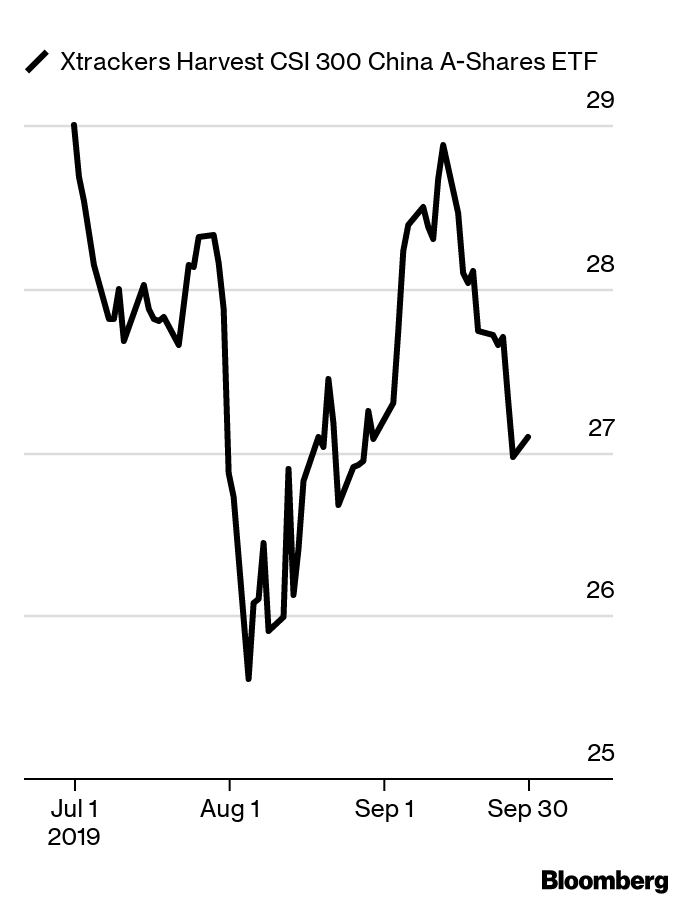 is a market-cap weighted fund of China’s A-Shares with healthy exposure to consumer segments of the market. It has an expense ratio of 0.65%.
is a market-cap weighted fund of China’s A-Shares with healthy exposure to consumer segments of the market. It has an expense ratio of 0.65%.
Performance of last quarter’s ETF plays: Balchunas’s suggestion to play on Koesterich’s theme last quarter—investing in European equities—was the iShares Core MSCI Europe ETF (IEUR)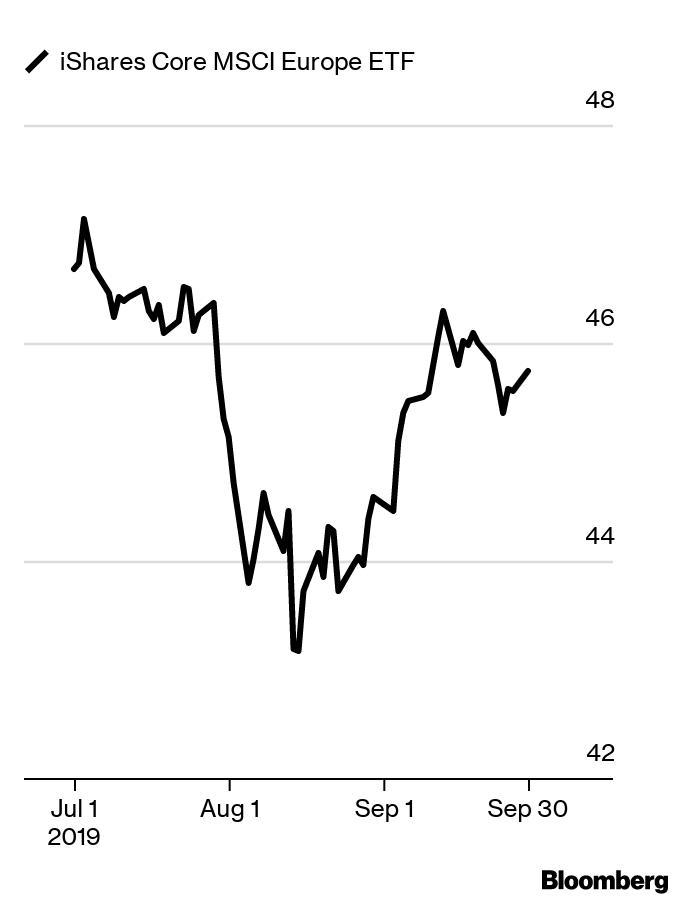 . It fell about 1.8%.
. It fell about 1.8%.
The Case for European Equities
With the S&P 500 up almost 20% year-to-date, investors can be forgiven for staying close to home. That said, the case for international diversification remains sound, in part because other markets are also producing stellar returns. China is up almost 30% year-to-date. To many investors’ surprise, another bright spot is Europe. While not quite keeping pace with the U.S., European equities are up 15% in 2019. For investors under-invested in non-U.S. stocks, Europe is worth another look.
While there are challenges, including structurally lower growth, there are several factors favoring European equities: valuation, dividends, low growth expectations, the composition of the index and finally, the European Central Bank (ECB).
Starting with valuations, European equities trade at 13 to 14 times next year’s earnings, which is cheap relative to the almost 18 times next year’s earnings for the S&P 500. Europe also scores much better on dividend income. Dividend yields are approximately 3.5% for the continent and 4.5% for the U.K., almost double the 1.8% on the S&P 500.
While Europe is struggling to grow, this appears well-discounted in the market. The Citi European Economic Surprise Index is close to flat. In contrast, the U.S. economic surprise index is near a two-year low. To be clear, this doesn’t mean that the U.S. will grow slower. But relative to expectations, European growth is coming in better than in the U.S.
Even if European growth is soft, European equity indices are more exposed to global, rather than local, growth. Most of the big names in the index are global champions, such as SAP in technology or Royal Dutch or BP in energy. The fortunes of these companies are more tied to global conditions.
Finally, there is the ECB. The ECB is likely to extend its stimulus—and potentially its asset-buying program—later this year. As my colleague Rick Rieder has suggested, this may even involve the eventual purchase of equities, as the Bank of Japan has been doing for years.
The bottom line: Europe has its challenges, but also some fairly consequential tailwinds.
Way to play it with ETFs: Balchunas likes the iShares Core MSCI Europe ETF (IEUR)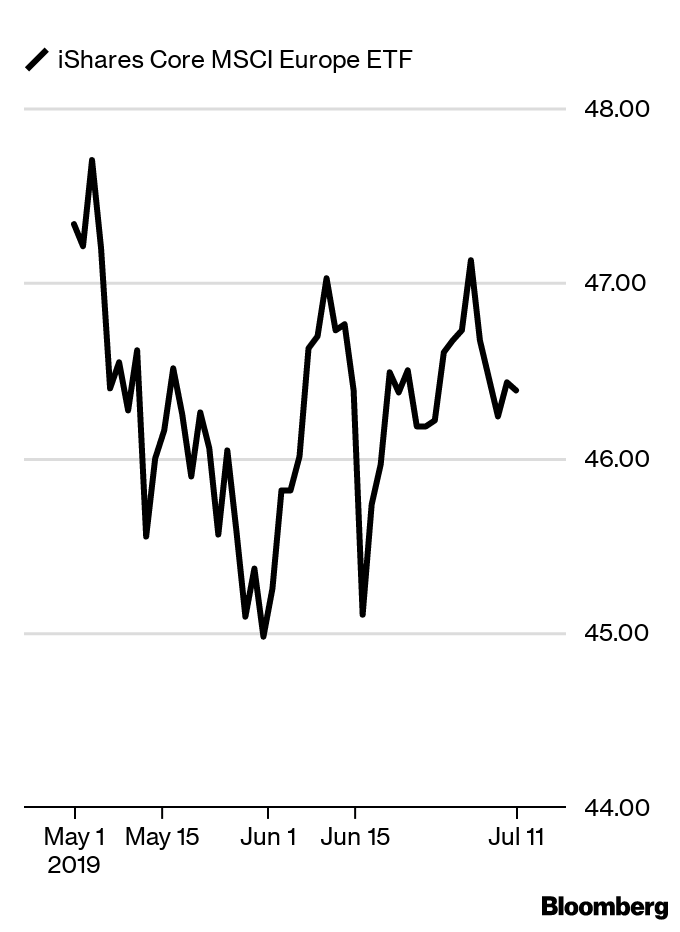 as a way to play Koesterich’s themes. The market-cap weighted fund offers healthy exposure to the global equity sway that could help growth, and would benefit from European Central Bank stimulus. The fund has a good market-cap range, with 7% mid-caps and 3% small caps, and a 0.09% expense ratio.
as a way to play Koesterich’s themes. The market-cap weighted fund offers healthy exposure to the global equity sway that could help growth, and would benefit from European Central Bank stimulus. The fund has a good market-cap range, with 7% mid-caps and 3% small caps, and a 0.09% expense ratio.
Performance of last quarter’s ETF plays: The iShares Core MSCI Emerging Markets ETF (IEMG) fell 0.5% in the second quarter.
fell 0.5% in the second quarter.
Surf the Emerging-Market Wave
With stocks up about 16 percent year-to-date, and more than 20 percent from the December 2018 low, investors could be forgiven for believing there are no bargains left.
In the U.S., for example, multiple expansion—i.e., what an investor is willing to pay for a dollar of earnings—has left large-cap U.S. equities about 15 percent more expensive than they were at the end of 2018. That said, many market segments outside the U.S. still look cheap. More specifically, emerging-market (EM) equities are not only cheap but are also likely to benefit from the current economic environment.
At the end of March, the MSCI Emerging Market Index was still trading at less than 13 times trailing earnings, a discount to the post-crisis average since 2010. Relative to developed markets, EM equities are trading at a 26 percent discount.
While EM looks inexpensive, the stocks can struggle even with modest valuations, as investors were reminded last year. Often the challenge is U.S. monetary policy. Emerging-market stocks were some of the worst performers last year as the Federal Reserve hiked rates and the U.S. dollar rose. In contrast, the current environment looks much more supportive. The Fed is on hold, real interest rates are stable and, most important, the dollar appears contained, with the U.S. Dollar Index (DXY) stuck in a range for the past six months.
To the extent that the Fed remains on hold, while the European Central Bank and the People’s Bank of China are attempting to stimulate their respective economies, this creates an ideal regime for emerging-market assets. After one of the sharpest rallies in recent memory, EM equities still offer further upside. Among the countries where we see particularly good opportunities, I would highlight China, specifically in internet commerce and other consumer-oriented companies.
Way to play it with ETFs: The iShares Core MSCI Emerging Markets ETF (IEMG)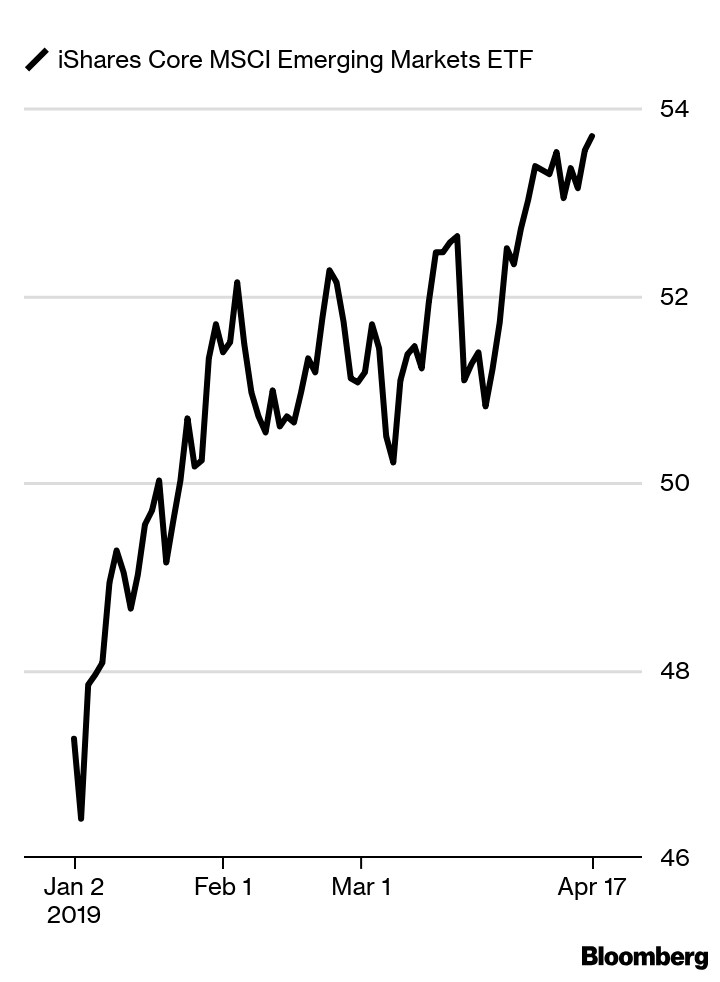 is Balchunas’s pick to get broad, market-cap weighted emerging market exposure. Its highest country allocations are China, South Korea, Taiwan, India and Brazil. It has an expense ratio of 0.14 percent.
is Balchunas’s pick to get broad, market-cap weighted emerging market exposure. Its highest country allocations are China, South Korea, Taiwan, India and Brazil. It has an expense ratio of 0.14 percent.
Performance of last quarter’s ETF plays: Balchunas’s ETF choices to play the oil patch, Energy Select Sector SPDR Fund (XLE)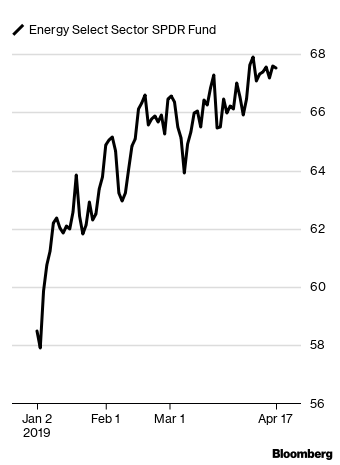 and the Invesco S&P 500 Equal Weight Energy ETF (RYE)
and the Invesco S&P 500 Equal Weight Energy ETF (RYE)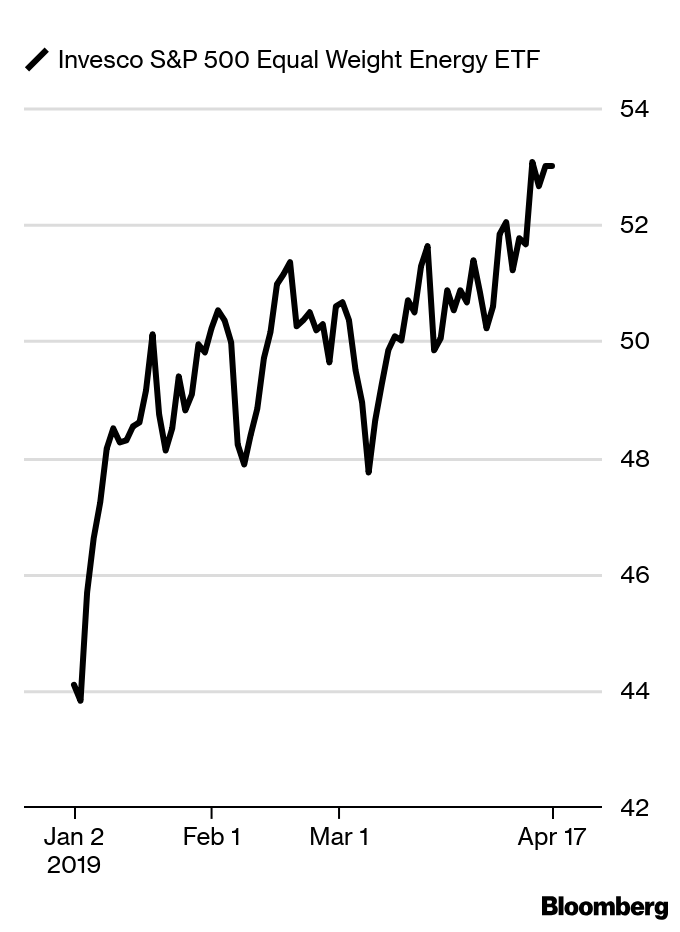 , rose 16.2 percent and 18 percent, respectively, in 2019’s first quarter.
, rose 16.2 percent and 18 percent, respectively, in 2019’s first quarter.
Head for the Oil Patch
Of the casualties in the 2018’s fourth-quarter carnage, energy stocks were some of the worst hit. Even after the recent rebound, the three-month rolling return for the U.S. energy sector as of Jan. 10 was -16 percent (excluding dividends), while the S&P 500 price return was -6 percent. The rout has left many of these stocks looking cheap, particularly considering the recent stabilization in crude oil prices.
As of the end of December, the S&P 500 energy sector was trading at a multiple of roughly 1.55 to book value (P/B). That’s the lowest since early 2016 and about on par with the trough valuation during the financial crisis. Valuations look even cheaper relative to the broader market. The current P/B represents nearly a 50 percent discount, the largest since at least 1995.
The sector also appears inexpensive compared with the price of oil. As you’d expect, the sector’s relative valuation tends to move (roughly) in tandem with crude prices. When oil prices are lower, the sector trades at a lower valuation compared with the market. Based on oil prices at $48 per barrel, history would suggest a 20 percent discount to the market, not a 50 percent one.
In addition to value, there are two other reasons to consider raising the allocation to energy shares. Historically, energy stocks have been more resilient than the broader market during periods of rising interest rates and/or inflation. If part of what has dislocated the market is the challenge of navigating higher interest rates, energy companies offer a reasonable hedge. Finally, large integrated energy companies are offering dividend yields north of 4 percent. In a yield-starved world, this looks attractive.
Way to play it with ETFs: The Energy Select Sector SPDR Fund (XLE)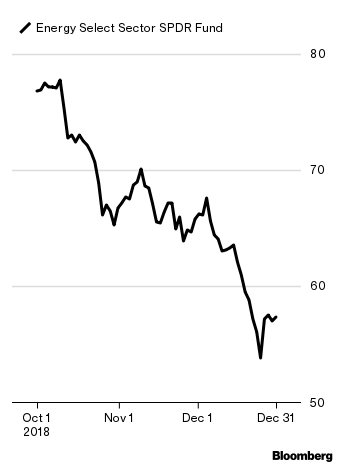 is most people’s go-to way to play energy stocks in the short-term, according to Balchunas. It has good liquidity and a low fee of 0.13 percent. However, the ETF is market cap-weighted, so Exxon Mobil and Chevron make up 40 percent of the portfolio. For those who want a more diversified play there’s the equal-weighted Invesco S&P 500 Equal Weight Energy ETF (RYE)
is most people’s go-to way to play energy stocks in the short-term, according to Balchunas. It has good liquidity and a low fee of 0.13 percent. However, the ETF is market cap-weighted, so Exxon Mobil and Chevron make up 40 percent of the portfolio. For those who want a more diversified play there’s the equal-weighted Invesco S&P 500 Equal Weight Energy ETF (RYE)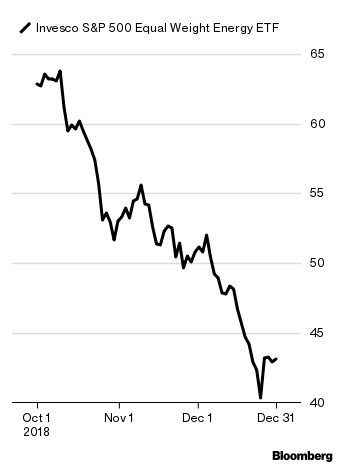 . It has a fee of 0.40 percent.
. It has a fee of 0.40 percent.
Performance of last quarter’s ETF plays: The ETFs that Bloomberg Intelligence ETF analyst Eric Balchunas highlighted as possible ways to play Koesterich’s theme of scooping up bargains in Asia—the iShares MSCI Japan ETF (EWJ)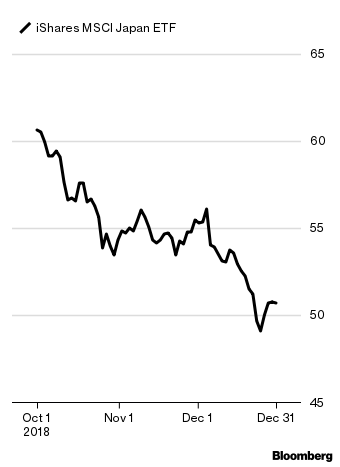 , Franklin FTSE Japan ETF (FLJP)
, Franklin FTSE Japan ETF (FLJP) and JPMorgan BetaBuilders Japan ETF (BBJP)
and JPMorgan BetaBuilders Japan ETF (BBJP) —all fell about 15 percent for the quarter.
—all fell about 15 percent for the quarter.
Asia on Sale
As many markets started the year at already-full valuations, investors could be forgiven for thinking that there are few bargains left. Interestingly, many Asian equities appear really cheap.
For example, as of the end of September, Japanese equities remain the cheapest in the developed world. The Topix Index (TPX) is trading at 1.3 times price-to-book (P/B), less than half the level of the S&P 500. The current discount is close to the widest since 2012, a period that preceded a three-year, 150 percent rally.
The Asia discount applies to a number of emerging markets as well. South Korean equities remain not only the cheapest in this category, but looking across equities, sovereign debt and credit, they are by some measures the cheapest asset class. The current valuation represents a 35 percent discount to the rest of the emerging markets, the largest discount since the Asian financial crisis.
Historically, many of these markets, especially Korea, have traded at a discount. The same is true for Japan, but while the discount may have been justified in the past, much has changed in recent years. Japan has witnessed a significant improvement in both corporate governance and profitability. The return on equity for Japan’s Topix index now stands at around 10 percent, close to a multi-decade high. When you factor in Japanese monetary conditions that are still ultra-accommodative, the low equity valuations seem even harder to justify.
Rather than resting on fundamentals, today’s Asia discount can arguably be attributed to three trends: stellar U.S. earnings growth, a stronger dollar as a headwind for emerging markets stocks, and rising trade frictions.
While trade and the U.S. dollar remain real issues, these concerns already appear reflected in equity prices. As a result, Japan and much of Asia appear to be that increasingly rare find: a bargain.
Way to play it with ETFs: The iShares MSCI Japan ETF (EWJ)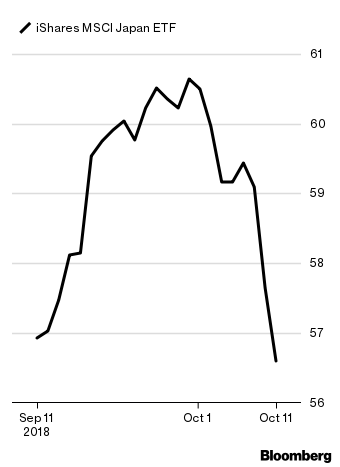 is far and away the largest Japan ETF, at $17.4 billion in assets, said Bloomberg Intelligence ETF analyst Balchunas. It has a fee of 0.49 percent. For cheaper ETFs that basically track the same stocks he likes the Franklin FTSE Japan ETF (FLJP)
is far and away the largest Japan ETF, at $17.4 billion in assets, said Bloomberg Intelligence ETF analyst Balchunas. It has a fee of 0.49 percent. For cheaper ETFs that basically track the same stocks he likes the Franklin FTSE Japan ETF (FLJP)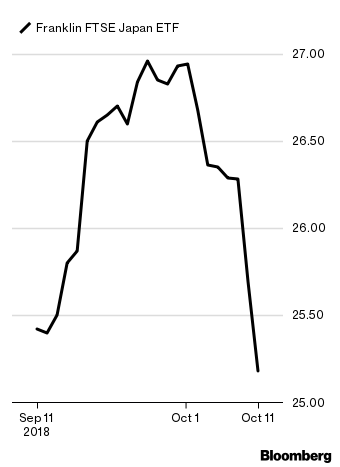 , which charges 0.09 percent, and the JPMorgan BetaBuilders Japan ETF (BBJP)
, which charges 0.09 percent, and the JPMorgan BetaBuilders Japan ETF (BBJP)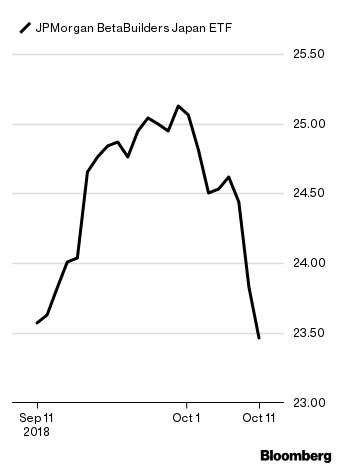 , which charges 0.19 percent.
, which charges 0.19 percent.
Performance of last quarter’s ETF plays: Balchunas highlighted the SPDR S&P Emerging Asia Pacific ETF (GMF)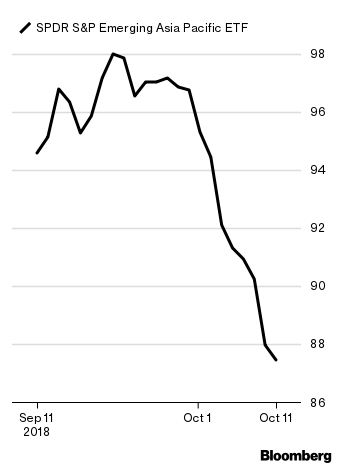 . It fell 2.4 percent in the third quarter.
. It fell 2.4 percent in the third quarter.
Seek Value in Emerging Markets
Following a stellar 2017, emerging-market equities are once again on the back foot. Despite bouncing in recent weeks, so far this year the MSCI Emerging Market Index is trailing the MSCI World Index of developed countries by about 8 percentage points. The selling has left many of these markets cheap at a time when economic prospects are improving and the dollar is stabilizing.
The MSCI Emerging Market Index is trading at 13.5 times trailing earnings and 11.3 times forward earnings. The former represents a 26 percent discount to developed markets. Based on price-to-book (P/B), emerging-market stocks look even cheaper. Currently, the stocks are trading at a 30 percent discount, the largest since the summer of 2016.
The magnitude of the discount looks odd given that EM economic data is improving relative to expectations. From late March through mid-June, the Citi EM Index of Economic Surprises plunged from a positive 40 to a negative 25. In other words, economic data went from reliably beating expectations to chronically missing estimates. However, since late June, things have started to improve.
It’s important to highlight that a more constructive view on EM equities comes with three big caveats: financial conditions, trade and precision. EM assets are still vulnerable to tightening U.S. financial conditions, particularly a stronger dollar. Outside of the dollar, investors should be concerned about trade. While trade issues have faded in recent weeks, fundamental tensions with China haven’t been resolved. If trade concerns escalate, EM assets are vulnerable.
Finally, the notion of EM equities assumes a homogenous asset. In reality, EM is a heterogeneous collection of countries, with wildly varying fundamentals and valuations. Turkey is not Taiwan, and Brazil is not Poland.
For myself, I see the best opportunities and value in EM Asia. While not without risks, this part of the world looks to once again offer some value.
Way to play it with ETFs: To play emerging-market countries in Asia, investors could use the SPDR S&P Emerging Asia Pacific ETF (GMF)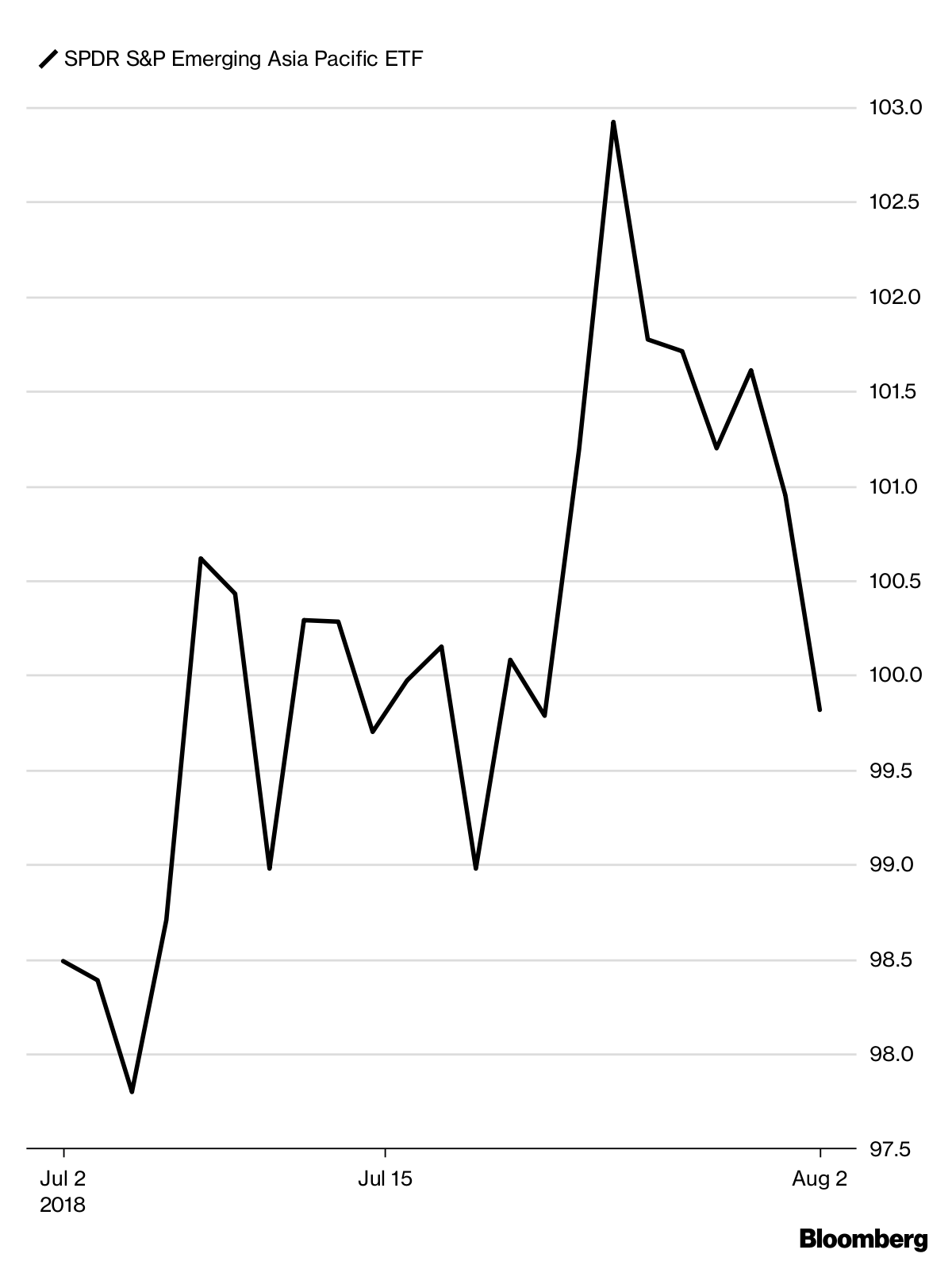 , said Balchunas. It has heavy allocations to China, Taiwan and India, but also includes countries like Malaysia and Indonesia. It charges 0.49 percent.
, said Balchunas. It has heavy allocations to China, Taiwan and India, but also includes countries like Malaysia and Indonesia. It charges 0.49 percent.
Performance of last quarter’s ETF plays: The iShares Core MSCI Emerging Markets Index (IEMG)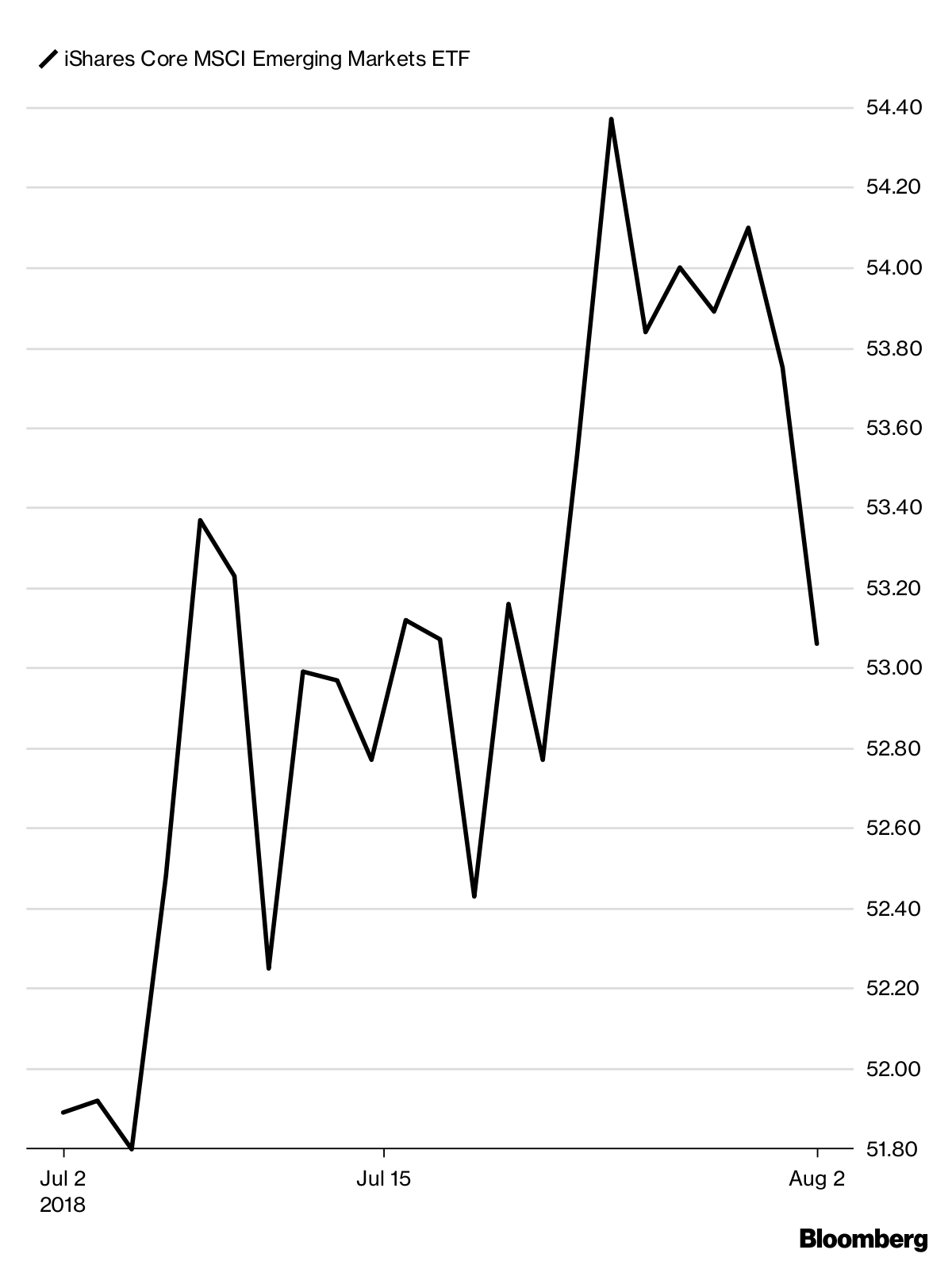 was Balchunas’s choice to play emerging-market stocks; it had a rough second quarter, falling 10 percent.
was Balchunas’s choice to play emerging-market stocks; it had a rough second quarter, falling 10 percent.
Emerging Markets May Be Cheap
Given that we’re in the 10th year of the bull market, the second-longest on record, investors are not inundated with investment bargains. Most asset classes are somewhere between reasonable and off-the-charts expensive. At the same time, volatility has returned with a vengeance, and an escalating trade dispute has the potential to disrupt what was supposed to be a year of synchronized growth. This combination does not immediately suggest adding to one of the riskier asset classes: emerging-market stocks. That said, given cheap valuations, a still-resilient economy and a stable dollar, emerging markets may represent one of the more interesting opportunities in 2018.
In an environment where valuations have been pushed ever higher by an extended bull market, most emerging-markets countries stand out as cheap. The MSCI Emerging Market Index is trading at approximately 1.6 times its book value, a 27 percent discount to developed-markets indexes. The current discount compares favorably with the 10-year average discount of 15 percent.
A larger discount might be justified, given higher volatility and political uncertainty. The irony is that much of that uncertainty is emanating not from emerging markets but from the United States. And despite the lingering questions over trade, most indicators still suggest a year of solid growth, which has historically been a tailwind for emerging markets’ outperformance.
Finally, there is the U.S. dollar. While investors sometimes exaggerate the role of the dollar in emerging markets, a weaker dollar has generally been supportive of emerging markets assets.
To be clear, there are risks. An economic slowdown or a more abrupt tightening of U.S. monetary conditions, particularly in the context of a stronger dollar, would probably cause emerging market stocks to lag. However, to the extent that the global expansion continues, emerging markets is the rarest of things in a prolonged bull market: a cheap asset class.
Way to play it with ETFs: Balchunas points to a “cheap and deep” way to play EM in the iShares Core MSCI Emerging Markets ETF (IEMG)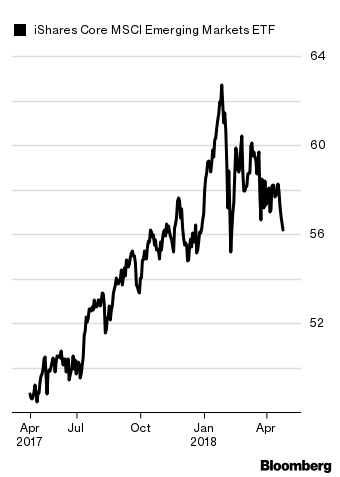 . It serves up nearly 2,000 stocks across several countries, with China the largest weighting at about 24 percent of assets. It charges a 0.14 percent fee and has quietly grown assets to $50 billion since launching a little over five years ago.
. It serves up nearly 2,000 stocks across several countries, with China the largest weighting at about 24 percent of assets. It charges a 0.14 percent fee and has quietly grown assets to $50 billion since launching a little over five years ago.
Performance of last quarter’s ETF plays: Balchunas’s picks to play Koesterich’s previous recommendation to expand stock holdings internationally, the SPDR Euro Stoxx 50 ETF (FEZ)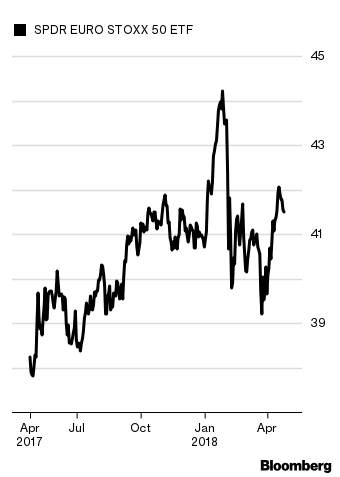 and the iShares MSCI Australia ETF (EWA)
and the iShares MSCI Australia ETF (EWA)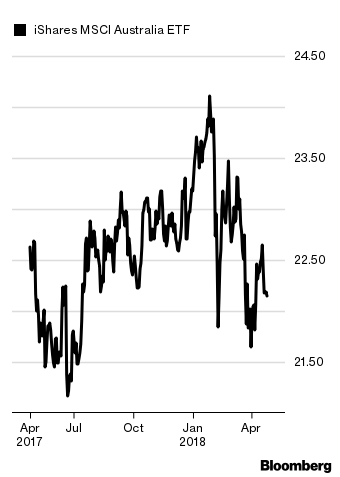 , fell 1.7 percent and 6.2 percent, respectively, in 2018’s first quarter.
, fell 1.7 percent and 6.2 percent, respectively, in 2018’s first quarter.
Stick With Equities—Just Cast a Wider Net
The past year was, in every sense, as good as it gets. Stocks posted gains of more than 20 percent, with virtually no pullbacks. While we’re unlikely to be so fortunate in 2018, this is not the time to abandon stocks. Given a synchronized global recovery and still-easy financial conditions, 2018 is likely to be another year in which stocks beat bonds. For those already heavily invested in U.S. equities, there are four reasons to consider adding to your holdings of international stocks.
Cheaper valuations. Based on the trailing price-earnings ratio, the S&P 500 is trading at a 13 percent premium to other developed markets. While the U.S. has recently enjoyed a strong rebound in corporate earnings, valuations have expanded even faster. This leaves the U.S. as the world’s most expensive stock market.
Faster earnings growth. Part of the reason U.S. valuations have risen relative to the rest of the world is that while earnings are growing in the U.S., they are rebounding even faster elsewhere.
More income. As stocks have risen, dividend yields have fallen. In the U.S., the dividend yield on the S&P 500 is below 2 percent. For the first time since the financial crisis, the dividend yield on large-cap stocks is now below the yield available on a 2-year Treasury note. In contrast, the dividend yield on the Euro Stoxx 50 is well above 3 percent. Australian equities yield over 4 percent. Income-oriented investors should ponder the opportunities outside the U.S.
Easier monetary policy. To be sure, 2018 is the year when most of the world’s large central banks will either be withdrawing monetary accommodation or publicly pondering its withdrawal. That said, the U.S. Federal Reserve is ahead of the curve in tightening monetary policy. Other central banks, notably the Bank of Japan, will be slower to withdraw easy money policies.
Way to play it with ETFs: The SPDR Euro Stoxx 50 ETF (FEZ)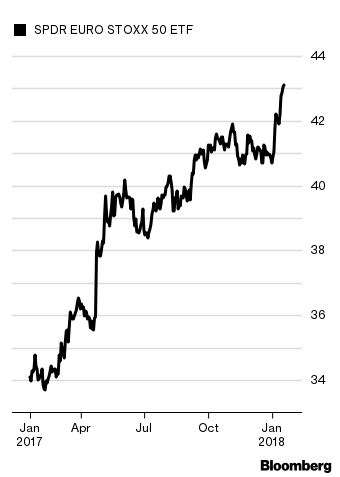 is a way to track that European blue chip stock index, and investors can use the Shares MSCI Australia ETF (EWA)
is a way to track that European blue chip stock index, and investors can use the Shares MSCI Australia ETF (EWA)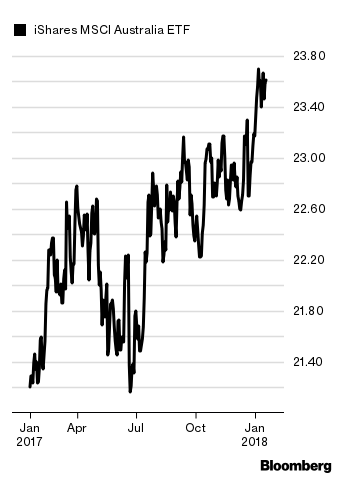 for exposure to Australia. The ETFs charge 0.29 percent and 0.48 percent, respectively.
for exposure to Australia. The ETFs charge 0.29 percent and 0.48 percent, respectively.
Performance of last quarter’s ETF plays: The ETFs chosen to play on Koesterich’s theme of not giving up on value investing were the Vanguard Value ETF (VTV)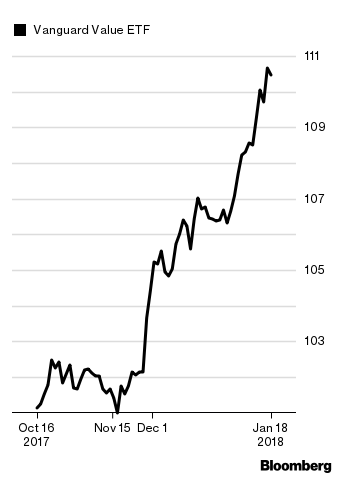 , the iShares Edge MSCI USA Value Factor ETF (VLUE)
, the iShares Edge MSCI USA Value Factor ETF (VLUE)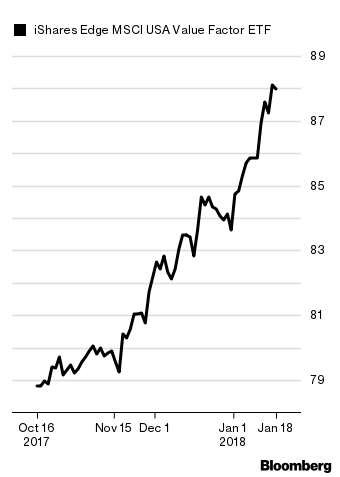 and the ValueShares US Quantitative Value ETF (QVAL)
and the ValueShares US Quantitative Value ETF (QVAL)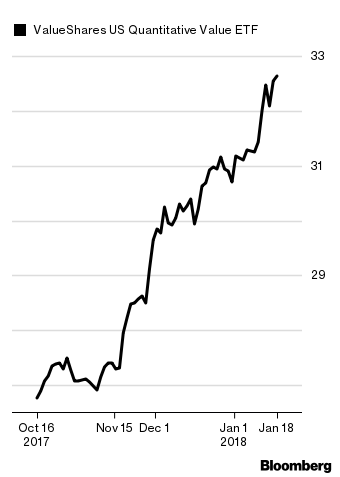 . The ETFs gained 6.5 percent, 8.1 percent and 13.1 percent, respectively.
. The ETFs gained 6.5 percent, 8.1 percent and 13.1 percent, respectively.
Don’t Give Up on Value
After a stellar back half of 2016, U.S. value names have largely disappointed in 2017. As the post-election euphoria faded and everyone faced up to the reality of still modest growth, most investors reverted to old habits: a focus on yield and growth at the expense of value.
Still, value’s relative performance may once again be inflecting. Value stocks outperformed their flashier growth cousins in September, and there are several reasons to believe that trend can continue.
First, value is cheap. While value stocks are by definition cheaper than growth, today they are much, much cheaper. Since 1995 the average ratio between the Russell 1000 Value and Russell 1000 Growth Indices (based on price-to-book) has been 0.45; i.e., value typically trades at a 55 percent discount to growth. Currently the ratio is 0.30. Value has not been this cheap relative to growth since early 2000.
In addition to being cheap, for the first time this year value may once again have a catalyst. It normally outperforms when economic expectations are improving. In contrast, when economic growth is modest, investors are more likely to put a premium on companies that can generate organic earning growth, regardless of the economic climate. This dynamic helps explain the strong year-to-date rally in technology and other growth stocks.
Recent economic data, however, have been modestly stronger, and investors are, once again, entertaining visions of tax cuts. Granted, the economic impact of temporary tax cuts is more a sugar high than structural reform, but you take what you can get. At this point, even a modest boost in near-term growth expectations is arguably enough to shift investor preferences.
This creates an opportunity for value. In an environment in which investors are more sanguine about economic growth, they are more likely to notice that value stocks are not only cheap but also offer better leverage to any economic acceleration. Value is not dead yet.
Way to play it with ETFs: When it comes to picking a value ETF, the question is how bargain basement you want to go. The Vanguard Value ETF (VTV)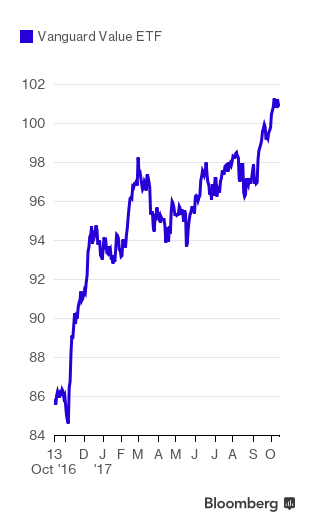 is the most popular but has only a slight tilt toward value. The iShares Edge MSCI USA Value Weighted Index Fund (VLUE)
is the most popular but has only a slight tilt toward value. The iShares Edge MSCI USA Value Weighted Index Fund (VLUE)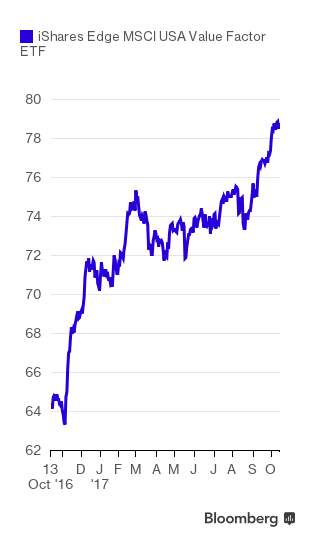 is much more exposed to value stocks. For hard-core value seekers, the ValueShares US Quantitative Value ETF (QVAL)
is much more exposed to value stocks. For hard-core value seekers, the ValueShares US Quantitative Value ETF (QVAL)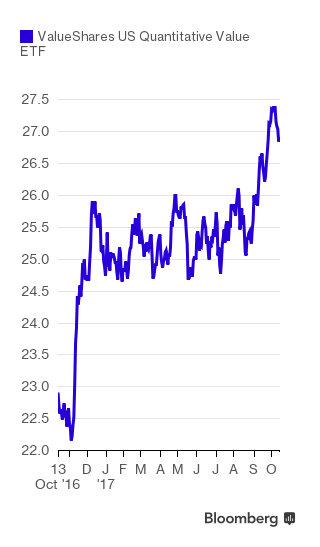 goes very deep to “buy stocks everyone else hates,” as its manager puts it.
goes very deep to “buy stocks everyone else hates,” as its manager puts it.
Performance of last quarter’s ETF plays: Balchunas pointed to the iShares U.S. Preferred Stock ETF (PFF) as a way to play Koesterich’s preference for preferred stock in last quarter’s writeup. It was down 0.8 percent for the quarter.
as a way to play Koesterich’s preference for preferred stock in last quarter’s writeup. It was down 0.8 percent for the quarter.
Seek Yields With Protection
There are times to stretch and take more risk, and there are times when discretion is the better part of valor. Following a bull market that turned eight years old in March and countless trillions of dollars of central bank asset purchases, few asset classes are obviously cheap. Still, in a world in which interest rates are barely 1 percent, investors can be forgiven for not wanting to stick their spare cash under the mattress.
This suggests to me a compromise: finding assets with a respectable yield that will provide downside protection if markets turn south.
U.S. preferred stock is currently yielding about 5.50 percent. This compares favorably with most of the other alternatives, including high-yield, investment-grade and emerging-market debt, and a basket of U.S. common dividend-paying stocks. [Preferred shares are sort of a stock and bond hybrid; they generally pay a fixed dividend and put you ahead of common-stock holders in cashing in shares if the company’s assets are liquidated.]
More to the point, following a disastrous period during the financial crisis, preferred stock has become a much less volatile asset class, currently offering the most attractive ratio of yield to volatility of the yield-oriented plays. Comparing the yield to the three-month trailing volatility of the asset class, you get a ratio of more than 1.3. In other words, investors are receiving 1.3 percentage points of income for every percentage point of annualized volatility. This is significantly higher than any of the alternatives.
Some will recall that preferred stocks did not live up to their reputation for low volatility during the financial crisis. At that time, an index of U.S. preferred, dominated by financial issuers, fell approximately 70 percent, worse than the broader market.
I see much less downside risk today. It is not clear that U.S. financials will be at the epicenter of the next crisis, as was the case in 2007-09. The sector is much better capitalized and run more conservatively than it was 10 years ago.
While preferred stocks aren’t likely to send anyone’s heart racing, a yield of 5 percent-plus in a world still characterized by low rates, high valuations, and uncomfortably low volatility is worth a look.
Way to play it with ETFs:The iShares U.S. Preferred Stock ETF (PFF) currently yields 5.6 percent and has great liquidity. Its 0.47 percent fee is high for an ETF but below average for an ETF specializing in preferred stocks.
currently yields 5.6 percent and has great liquidity. Its 0.47 percent fee is high for an ETF but below average for an ETF specializing in preferred stocks.
Performance of last quarter’s ETF plays: To follow Koesterich’s strategy of focusing on Asian equities, Balchunas pointed to the iShares MSCI Japan ETF (EWJ) , which gained 5.2 percent, and the iShares MSCI Emerging Markets Asia ETF (EEMA)
, which gained 5.2 percent, and the iShares MSCI Emerging Markets Asia ETF (EEMA) , which returned 8.5 percent.
, which returned 8.5 percent.
Look to Japan
We see the best opportunities within Asian equities, with an emphasis on Japan.
We’re now in the eighth year of the bull market in U.S. equities, and it’s increasingly difficult to find bargains. U.S. stocks have done exceptionally well, but investors have been pushing valuations to somewhat extreme levels. Large-cap U.S. equities are trading at approximately 22 times trailing earnings, the highest multiple since 2010 and at more than 30 times the CAPE ratio, a level last seen near the peak of the tech bubble. Making matters worse, U.S. Treasury bond prices look extremely rich after several years of buying by central banks.
In this environment, Asian equities stand out as a relative bargain. In recent years, Japanese stocks have traded at a discount to the U.S., and that discount is particularly large today. The Topix index is trading at approximately 1.3 times book value, vs. more than 3 times for the S&P 500.
Japanese profitability has been improving since 2012, thanks to better corporate governance and share buybacks. In addition, Japanese equities offer accounting standards that are strict relative to the U.S., low leverage and the continuing tailwind of monetary accommodation. Finally, to the extent the global economy is likely to modestly accelerate in 2017, Japanese exporters are well positioned to benefit from improving global growth and a firmer economy.
We also see select opportunities in other parts of Asia, including emerging markets. In particular, Indian companies offer an interesting take on emerging markets. [Click on last quarter’s tab for Sarah Ketterer’s take on India.] India is a large, domestically oriented economy that is relatively insulated from many of the more macro risks that often derail other segments of the emerging-market universe.
Ways to play it with ETFs: Investors can use the iShares MSCI Japan ETF (EWJ) 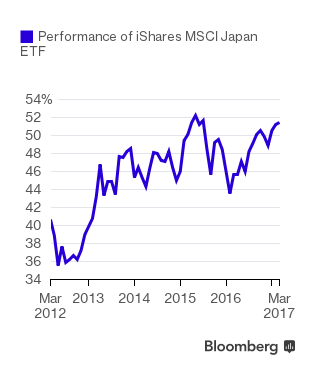 for Japan exposure. It is by far the most popular Japan ETF and charges 0.48 percent, about average for a single-country ETF. For Asia emerging markets, the iShares MSCI Emerging Markets Asia ETF (EEMA)
for Japan exposure. It is by far the most popular Japan ETF and charges 0.48 percent, about average for a single-country ETF. For Asia emerging markets, the iShares MSCI Emerging Markets Asia ETF (EEMA) 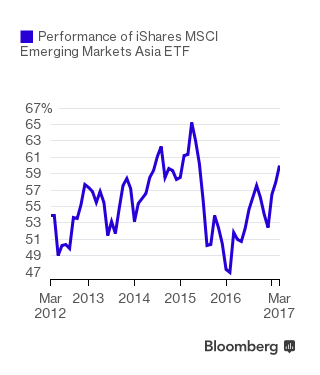 tracks many Asian countries such as China and Taiwan, as well as India, which has a 12 percent weighting in the ETF. EEMA charges a fee of 0.48 percent.
tracks many Asian countries such as China and Taiwan, as well as India, which has a 12 percent weighting in the ETF. EEMA charges a fee of 0.48 percent.
Ian Harnett
Chief investment strategist, Absolute Strategy Research
Hedge Inflation Risks
Equity investors should focus on increasing their protection against inflation and adding cyclical stocks into their portfolios.
Three months ago, we downgraded U.S. equities, as well as technology and growth stocks, because they were too expensive. Now we’re focusing on three new themes: increased U.S. dollar caution, the broadening of the global economic recovery and inflation risks rising in equity portfolios.
Even though the recovery may be muted, it can still be broad — nearly all purchasing manager index surveys (which measures manufacturing activity) published around the world in recent months have risen. Typically, such a scenario would trigger a flow into cyclical stocks and out of defensive shares (which usually offer some protection even when the economy is struggling) at both the sector and regional levels as company profits improve.
Broad recoveries also tend to weaken the U.S. dollar. That helps boost commodity prices and is a positive for emerging market equities.
While the Eurozone business cycle remains volatile and subject to concerns over Covid-19, our macroeconomic indicators continue to suggest room for outperformance. We expect bank stocks to outperform as regional cross-border bank consolidation increases.
We remain overweight global banks versus technology, and value versus growth, since both trades have historically been good inflation hedges. We also suggest overweighting industrials versus retailers, and energy versus utilities.
How to play it with ETFs: The Industrial Select Sector SPDR Fund (XLI)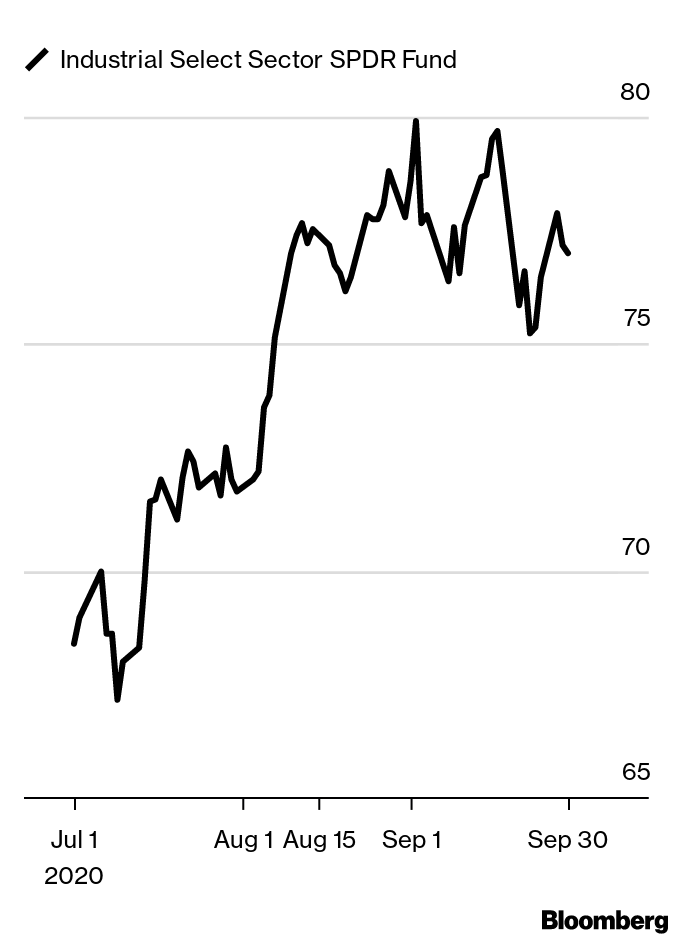 holds large-cap U.S. industrial stocks. Top holdings include Union Pacific Corp., United Parcel Service Inc., and Honeywell International. The expense ratio is 0.13%.
holds large-cap U.S. industrial stocks. Top holdings include Union Pacific Corp., United Parcel Service Inc., and Honeywell International. The expense ratio is 0.13%.
Performance of last quarter’s ETF plays: The SPDR Euro Stoxx 50 ETF (FEZ)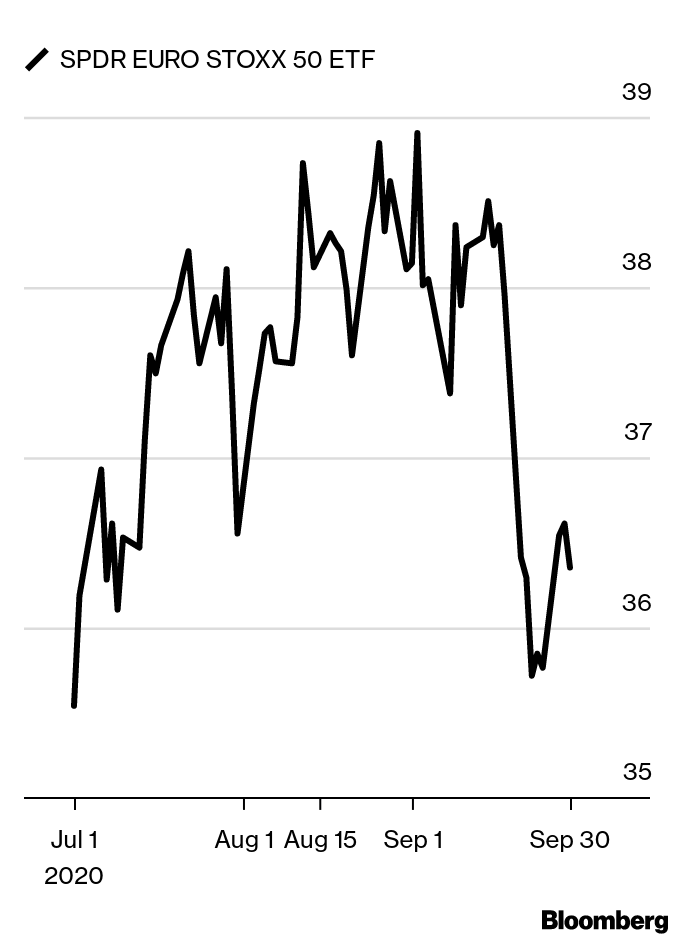 gained 3%.
gained 3%.
Play the New Policy Regime
The dramatic rally since March 23 may tempt some investors to think that the world is rapidly returning to previous norms. We think this is unlikely. The Covid-19 recession has triggered unprecedented levels of policy interventions.
We suggest investors reduce their U.S. equity weighting for the first time in three and a half years — and overweight the Eurozone instead. There are several reasons. The U.S. is seeing a second wave of Covid-19 infections, which may limit its recovery in the second half, just as the Eurozone is recovering. Also, U.S. valuations are more stretched relative to the rest of the world than they were at the peak of the tech bubble.
Plus, there’s been a major shift in Eurozone fiscal policy, with Germany not only supporting the $850 billion “Recovery Fund” but also committing to its own major fiscal expansion (13% of gross domestic product). These policy initiatives could lead to strategic rethinking of the attraction to euro assets and the euro versus the U.S. dollar, especially given the political uncertainty surrounding the U.S. election.
We’re underweighting tech and upgrading banks. Tech and banks are also the key drivers of growth versus value, and after the outperformance of growth in recent years we are shifting our bias towards quality and value. Until we see more evidence of a global recovery, or a weaker U.S. dollar, we remain underweight emerging markets equities, instead preferring Japan as a hedge against U.S. and global insolvency risks if the Covid-19 crisis persists into 2021.
How to play it with ETFs: Balchunas suggests the SPDR Euro Stoxx 50 ETF (FEZ)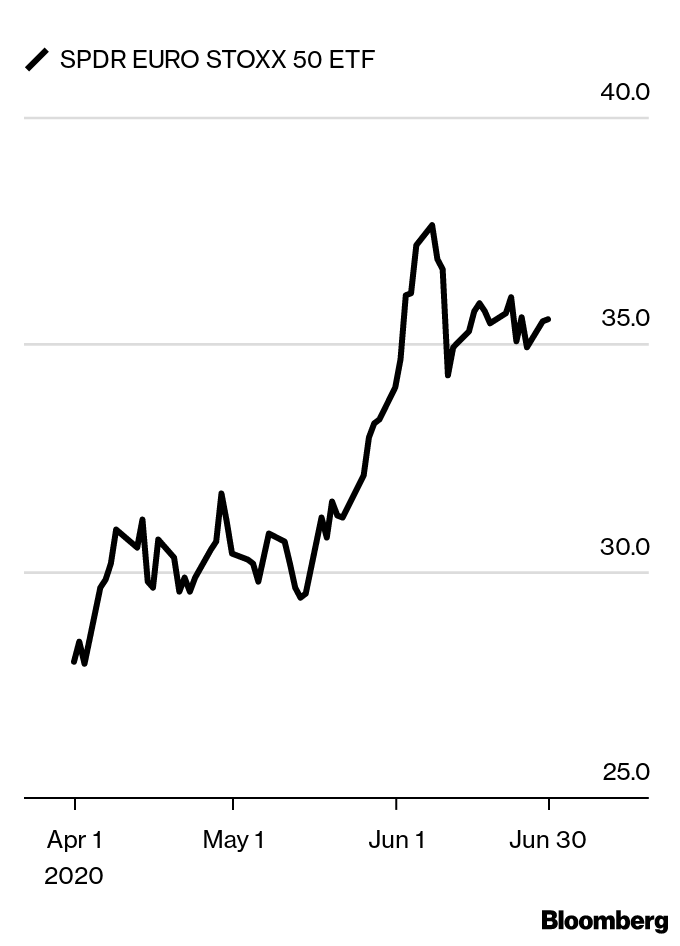 . Banks, with a 7% weight in the fund, have been the biggest drag on performance this year. The expense ratio is 0.29%.
. Banks, with a 7% weight in the fund, have been the biggest drag on performance this year. The expense ratio is 0.29%.
Performance of last quarter’s ETF plays: Invesco’s S&P 500 Quality ETF (SPHQ) rose 18.4%.
rose 18.4%.
Beware of Buying Dips
After the aggressive pullback in markets, it will be tempting to buy the dips. However, this is not a normal pullback caused by normal economic drivers. Rather, recent market volatility is reflecting a complex, multi-factor shock that will probably result in a multi-phase sell-off.
This pullback was the result of several factors: an economic shock, as optimistic market valuations confronted growth in G-7 gross domestic product that was weak even before the impact of the biological shock of coronavirus. Lower gas prices fueled an energy shock as oil investment and profits collapsed and petrodollar liquidity stalled. This helped drive a financial shock as liquidity and earnings stress exposed fragility in money markets, equities and credit.
Complex problems likely require complex solutions and those tend to take time to deliver, suggesting the duration of this market volatility could be lengthy.
We see three phases for markets to work through. The current technical bounce reflects hope of a V-shaped recovery in response to aggressive policy easing and hopes of stabilization in the virus. The second phase of market weakness should see investors price a deeper-for-longer demand shock as a rolling recession shifts from Asia into Europe and then the U.S., with global profits falling 30% to 50%. This will challenge both equity and credit valuations.
Finally, as we move into the fourth quarter, markets will need to price a supply shock as supply chains built for efficiency, rather than resiliency, fail or are harder to restart than hoped. Wafer-thin margins and high debt levels will put many small- and medium-sized companies critical to the supply chain at risk, which will affect activity, drive supply shortages and fuel stagflation.
Although these scenarios point to several short, sharp rallies in coming months, the trend will probably be for continued market volatility and stress.
The eventual crisis resolution requires not only a vaccine (which favors pharma) and sustained low rates (favoring a growth style over value) but also further fiscal policy easing (which favors specific national industries). The need for higher oil prices should also favor the oil majors. And eventually the U.S. dollar will also need to weaken, boosting gold.
For us, it remains too early to rotate into oversold value plays such as banks or airlines, and we prefer ‘quality-defensive’ companies with plenty of cash and short supply chains.
How to play it with ETFs: Invesco’s S&P 500 Quality ETF (SPHQ)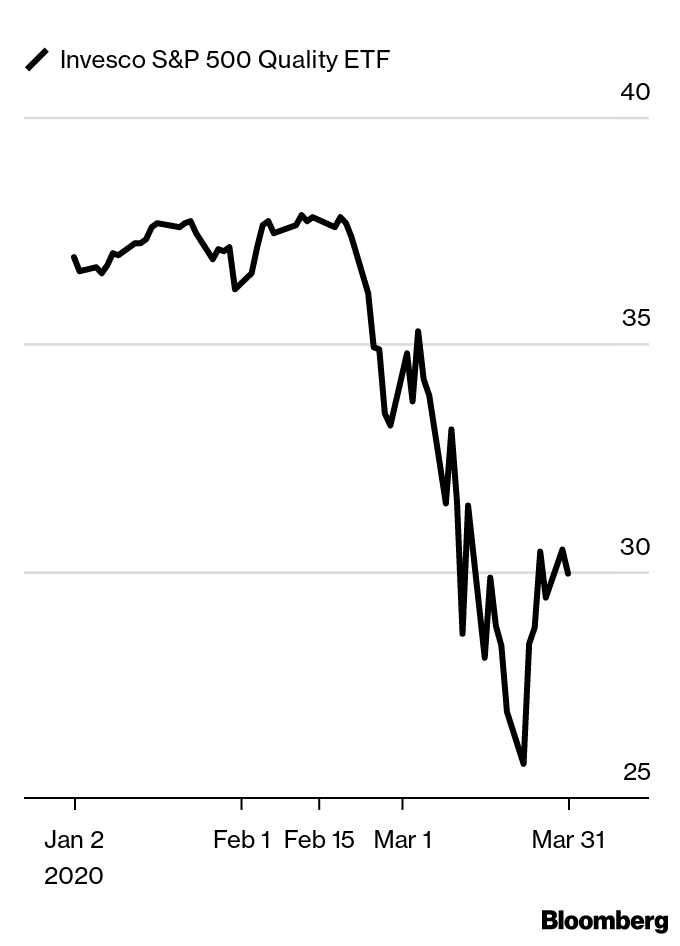 , with near 17% exposure to pharmaceuticals and 7% in biotech, could benefit from the possible development of a Covid-19 vaccine, said Balchunas, while its overweight position in tech hardware and semiconductors is attractive from a defensive standpoint. Its superior financial leverage profile should offer some protection even if there are still legs down in the equity market. The $1.5 billion fund charges 15 basis points.
, with near 17% exposure to pharmaceuticals and 7% in biotech, could benefit from the possible development of a Covid-19 vaccine, said Balchunas, while its overweight position in tech hardware and semiconductors is attractive from a defensive standpoint. Its superior financial leverage profile should offer some protection even if there are still legs down in the equity market. The $1.5 billion fund charges 15 basis points.
Performance of last quarter’s ETF plays: The iShares 1-3 year Treasury Bond ETF (SHY)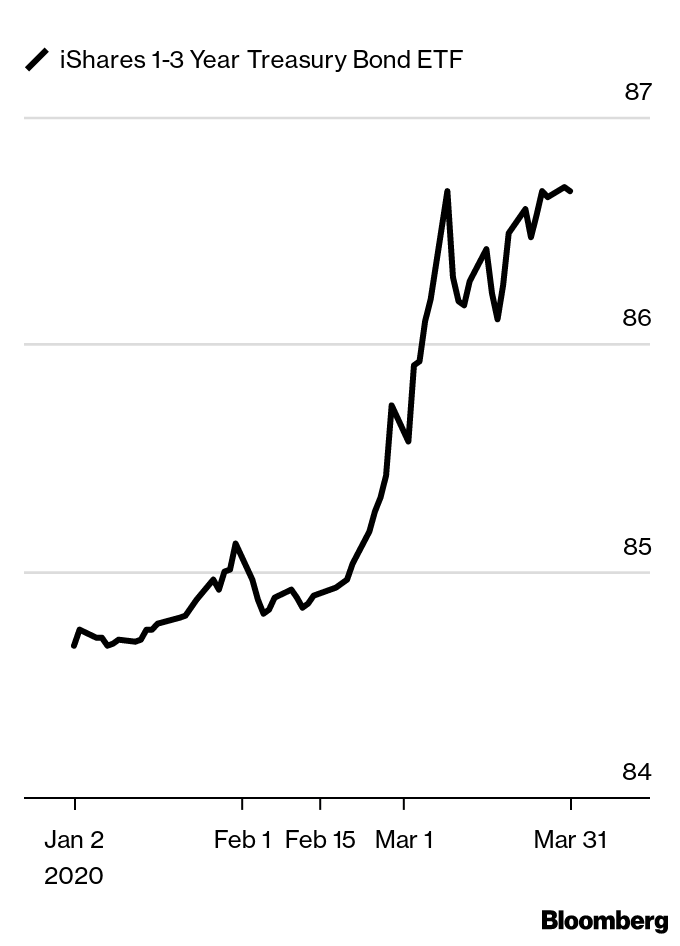 rose 2.5% in the first quarter, while the Vanguard Short-Term Inflation-Protected Securities ETF (VTIP)
rose 2.5% in the first quarter, while the Vanguard Short-Term Inflation-Protected Securities ETF (VTIP)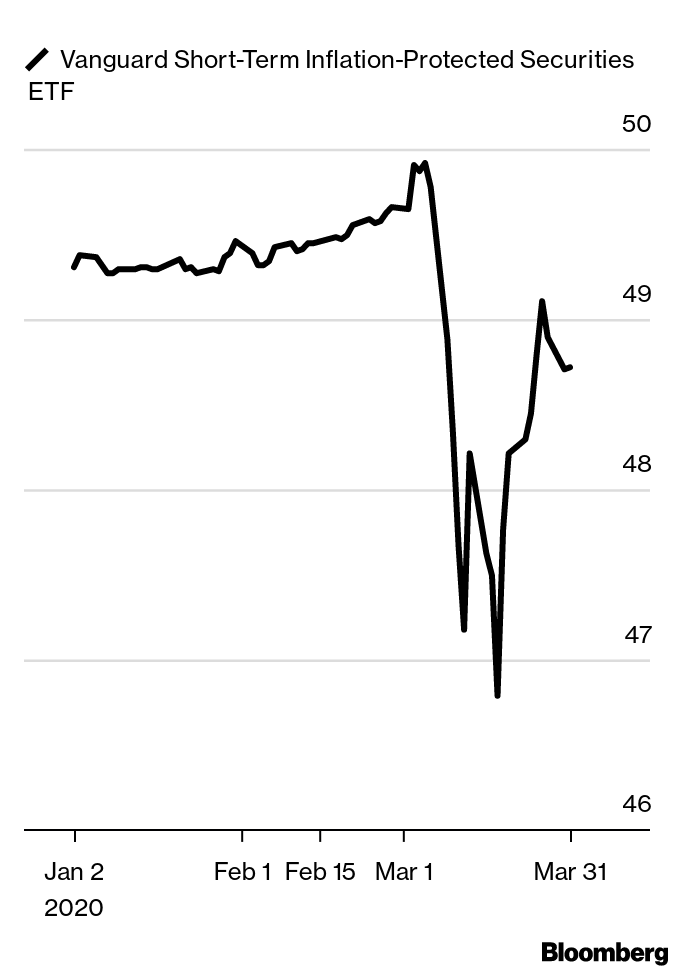 fell 1.1%.
fell 1.1%.
Batten Down the Hatches
Rate cuts, liquidity injections from the Federal Reserve and European Central Bank, as well as a “phase one” trade deal all helped push global equities up 10% in the fourth quarter of 2019. As a result, fears of U.S. and global recession have receded.
Despite this improving sentiment, our macro models continue to suggest that a sharp slowdown in global activity growth is in store for 2020. With U.S. and global equity valuations elevated, we favor defensive strategies and assets, focusing on wealth preservation rather than accumulation—at least for now.
The acronyms TINA (as in, There Is No Alternative — referring to equities) and FOMO were the key phrases for 2019. Investors ignored signs of slowing U.S. and global growth, focusing instead on how low policy rates and bond yields meant that there was no alternative to investing in equities if they had a reasonable dividend yield. As headline U.S. equity indices accelerated ahead of the median stock performance, active managers increasingly worried about being left behind passive fund returns, so that the “fear of missing out” took over.
However, this equity rally has been driven almost entirely by valuation expansion. Unless activity and earnings growth recovers, we doubt that these gains can be sustained. However, we see little sign of either. Our model of U.S. gross domestic product is decelerating sharply, and U.S. CEO confidence is as low as in the credit crunch. As well, U.S. earnings-per-share growth is negative for quoted large-cap stocks and falling at a staggering 32% annualized rate over the last six months for the S&P 600 index of small-cap stocks.
Our recession risk models remain elevated for the U.S. and our top-down profits models are suggesting EPS growth of -5% year-over-year in the U.S. and -9% year-over-year globally.
Given this backdrop, inflation is likely to decelerate in 2020. Weakening growth and inflation suggest that U.S. 10-year Treasury yields could fall back below 1.5% this year. If recession emerges and the Fed cuts rates towards zero by yearend, this will also provide good returns for short-dated (two-year) Treasuries. U.S. Treasury inflation-protected securities (TIPS) should also provide positive returns.
Given our views on Treasuries and TIPS, U.S. investors looking to reallocate funds within the U.S. equity market should focus on bond-sensitive sectors such as utilities, and prefer growth and quality factors rather than value. We would also suggest gold as a good hedge against any dollar weakness or recession.
How to play it with ETFs: For a good short-dated Treasury ETF for parking cash, while eking out a little yield, Balchunas picks the $17.5 billion iShares 1-3 year Treasury Bond ETF (SHY)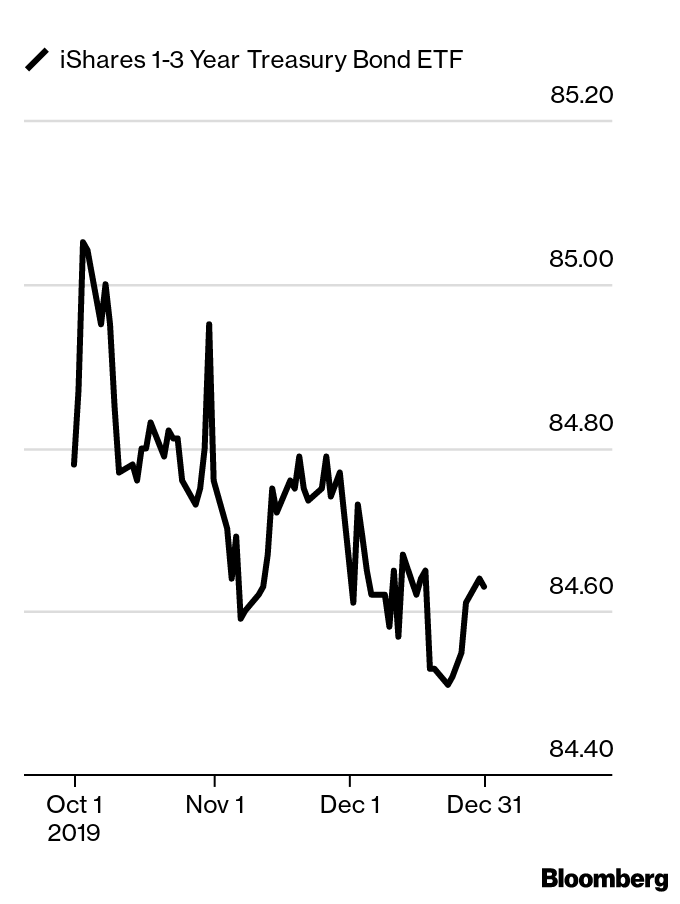 . It yields 2.1% and has a 0.15% fee. For those looking for an inflation-protected version of SHY, there’s the Vanguard Short-Term Inflation-Protected Securities ETF (VTIP)
. It yields 2.1% and has a 0.15% fee. For those looking for an inflation-protected version of SHY, there’s the Vanguard Short-Term Inflation-Protected Securities ETF (VTIP)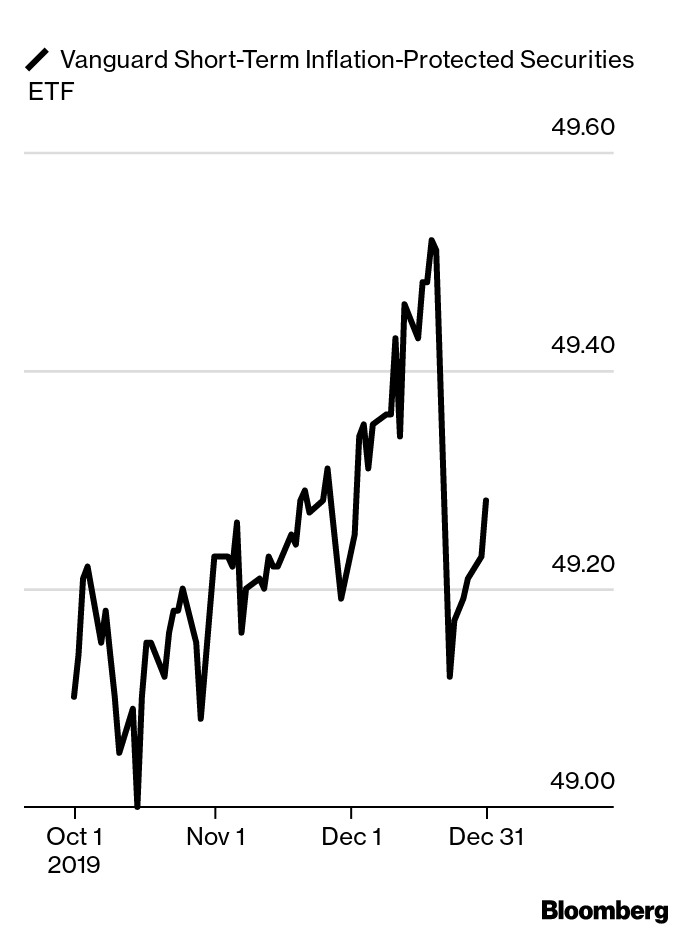 , which has $7.3 billion in assets and charges 0.06%.
, which has $7.3 billion in assets and charges 0.06%.
Performance of last quarter’s ETF plays: Balchunas’s pick for Harnett’s overall theme of avoiding risk, the Vanguard Short-Term Treasury ETF (VGSH) , saw its price fall 0.25%, and had a 0.5% total return, for the period.
, saw its price fall 0.25%, and had a 0.5% total return, for the period.
Retreat From Risk
Talk about recession is rising. For us at Absolute Strategy, however, it’s more than just talk—it’s now our central economic forecast for 2020. Given this, our investment advice is very straightforward: Be as risk-averse with your $10,000 as you can.
The reason is simple. In the 10 U.S. recessions seen since 1950, U.S. equities typically lost 20% from their pre-recession peak (six to nine months before the official start of recession) to their trough, which tends to only come deep into the recession, and only after the Fed has cut rates aggressively (usually about 400 basis points). These recession-driven equity bear markets typically see profits fall 15% and price-earnings multiples fall 5 points.
It is just not a good time to invest in risky assets. So, even though bond yields are low, they will go lower. We expect 10-year U.S. Treasuries to fall to 1%. However, with Fed funds likely to go close to zero by the end of 2020, shorter-dated bonds, such as two-year Treasuries, might provide better returns.
Even U.S. dollar cash yields of 2% may look a good return if equities fall 20%, and there are ultra-short-term bond funds that take a bit more risk and may offer a little more yield.
If real and nominal bond yields fall, as we expect, bond-sensitive assets will continue to outperform, such as gold, real estate investment trusts (REITs) and infrastructure-related funds.
If you feel that you must invest some of your $10,000 in equities, then stay in the U.S. market, rather than more risky international stocks, but stick to the bond-sensitive sectors such as utilities.
However, the one thing that does go up in a recession is equity volatility, so getting some protection from this source could be a good hedge for your portfolio.
These super-defensive suggestions may sound extreme. But while over half of the investors that we surveyed in September are concerned about a 2020 recession the majority still expect equities to beat bonds, despite the overwhelming lessons of history. The next six to nine months could be very ugly for equity markets as the reality of recession takes hold.
How to play it with ETFs: The Vanguard Short-Term Treasury ETF (VGSH)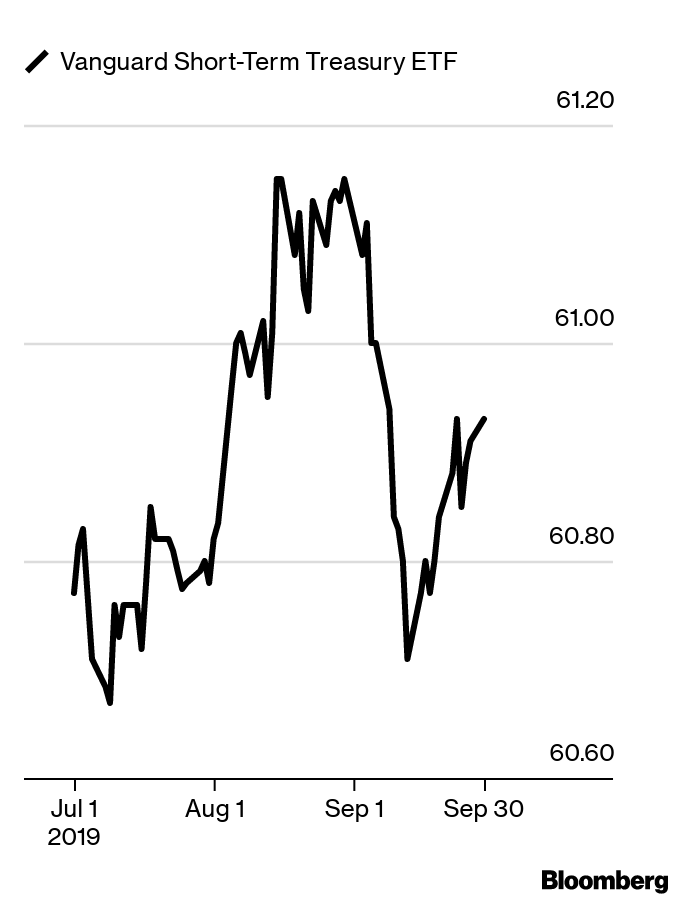 could act as a safe haven for assets. Its 12-month yield is 2.28% and the ETF has an expense ratio of 0.07%.
could act as a safe haven for assets. Its 12-month yield is 2.28% and the ETF has an expense ratio of 0.07%.
Performance of last quarter’s ETF plays: iShares U.S. Infrastructure ETF (IFRA)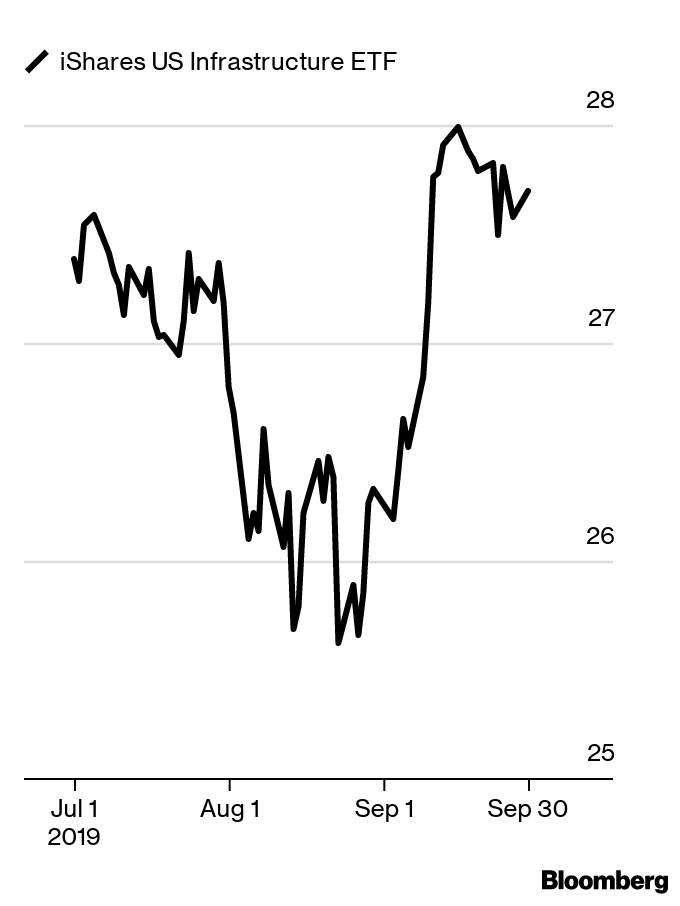 rose 1% for the quarter.
rose 1% for the quarter.
Play on Volatility, Infrastructure
The record highs seen in the U.S. equity market have come against the backdrop of U.S. 10-year Treasuries falling through 2%, global growth slowing and inflation pressures moderating.
The typical market narrative is that equities are gaining support from expectations of lower policy rates in the U.S. and elsewhere at the same time as global trade disputes are resolved.
We worry that this comfortable complacency will unwind in the coming quarters as investors realize that both equities and bonds cannot be right. Either global growth will re-accelerate with global trade, pushing bond yields higher as rate cuts are priced out of the market, or low bond yields will be validated by activity slowing further, with disappointing corporate earnings forcing policy makers into more aggressive rate cuts than currently expected. We view this as the more likely scenario.
We see this bond-friendly/equity-negative scenario as being supported by the rising recession risk indicators being published by the regional Federal Reserve banks. The fault line for equities will likely be the upcoming earnings season. We don’t expect it to go well. However, the rally in global equities has seen valuation multiples rise, which puts greater emphasis on companies meeting their earnings-per-share forecasts. U.S. companies are already guiding expectations lower, and we expect EPS growth in the coming year to be down 5%, rather than the 7% gain currently forecast by analysts.
Against this backdrop, we maintain our cautious stance on risk assets. After the recent equity rally has pushed market volatility measures down toward a 12-month low, we expect the VIX index to rise back toward 20 or higher in the coming six months. We would be buying equity volatility products.
If economic growth slows further, as our models suggest, bond yields should continue to fall, perhaps toward 1.5% on U.S. Treasuries, and zero for Treasury Inflation-Protected Securities (TIPS). Rather than investing directly in these declining bond yields, investors could buy infrastructure-related funds (which might also benefit from any domestic fiscal initiatives) or data-center real estate investment trusts.
Finally, while gold has been a strong performer in recent months, we suspect that this will continue if real yields fall and risk aversion rises across global markets.
Way to play it with ETFs: Way to play it with ETFs: Balchunas’s pick is the iShares U.S. Infrastructure ETF (IFRA)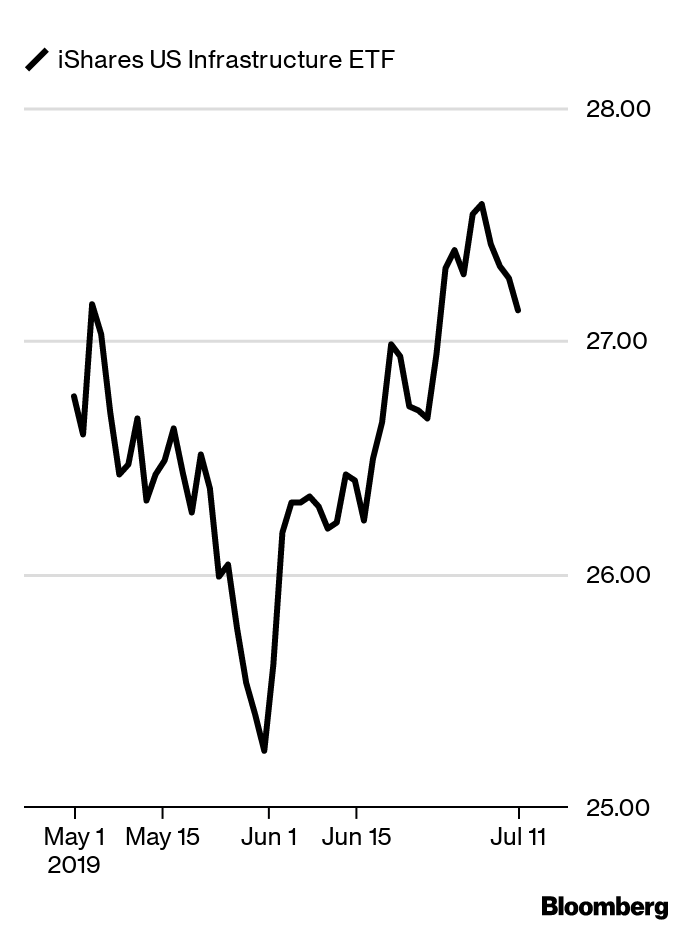 . It covers a less risky corner of the equity market, and is largely weighted to utilities, materials and industrial companies. The ETF may be helped by U.S. fiscal infrastructure initiatives and would benefit from a larger pivot to risk-aversion equity assets. The expense ratio is 0.40%.
. It covers a less risky corner of the equity market, and is largely weighted to utilities, materials and industrial companies. The ETF may be helped by U.S. fiscal infrastructure initiatives and would benefit from a larger pivot to risk-aversion equity assets. The expense ratio is 0.40%.
Performance of last quarter’s ETF plays: Balchunas’s pick, the Schwab U.S. Large-Cap Growth ETF (SCHG)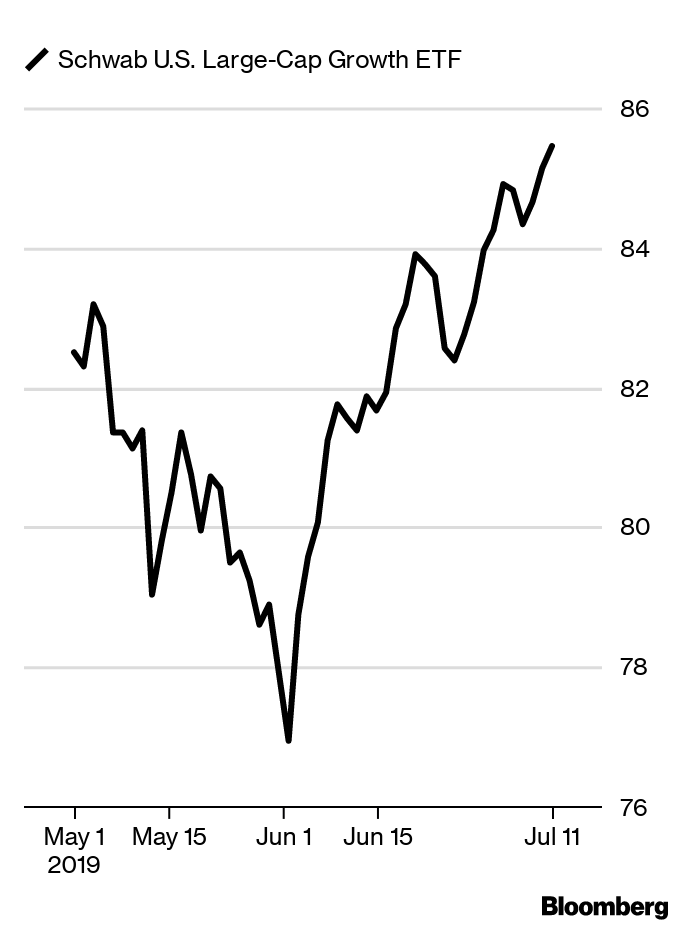 , rose 4.8% in the second quarter.
, rose 4.8% in the second quarter.
Target Tactical Trades
After a torrid December, the first-quarter risk rally saw U.S. equities dominate global asset returns, with tech stocks and cyclicals leading the way. The surprise, however, was that this rally came as U.S. Treasury yields collapsed through 2.5 percent, global activity slowed and pricing power evaporated.
We worry that the year’s second quarter will see these downdrafts played out in the earnings data. Despite analysts’ downgrading their estimates across most sectors in recent months, consensus U.S. earnings-per-share growth remains optimistic, at almost plus 6 percent for the coming 12 months and a 16 percent compound annual growth rate for the next five years. These compare with our expectations of minus 5 percent and plus 5 percent, respectively.
The market view is that these earnings worries take into account the relatively low valuations in U.S. cyclicals. While this depressed sentiment can provide scope for a short-term rally, as we’ve seen in the first quarter, we doubt that this is the start of a more major rotation into cyclical value.
For investors who want a bit more of a “tactical trade,” however, cyclical sectors such as basic resources and oil and gas may still have scope for further improvement in the second quarter, especially if commodities rally because of low real yields.
We also expect some investors to lock in gains from the U.S. market after its stellar performance—you’ve just seen three years’ worth of performance in three months! These investors may well begin looking at euro-zone equities thanks to their low valuations. The weak euro and signs of China recovering might boost European exporters—especially in the unloved German market.
The U.K., after several years of being largely uninvestable, might begin to benefit from its low valuations as Brexit uncertainty eases. If we are to see U.K. and euro-zone equities rally, we will also need to see banks rally. There is scope for a tactical rally in banks if bond yields bounce back from their recent lows.
For the full year, we remain cautious on the outlook for U.S. and global economic activity and maintain our cautious strategic stance by staying overweight growth versus value, and preferring quality to momentum.
Strategic caution and tactical agility may be important in a world where volatility appears ready to trend higher in the next year or two.
Way to play it with ETFs: Balchunas highlights the Schwab U.S. Large-Cap Growth ETF (SCHG)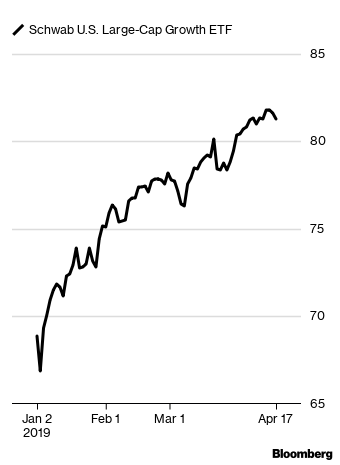 as a fund that offers more growth than the S&P 500. It overweights information technology, consumer discretionary and communication services, and underweights staples and financials. The fund has a low correlation with the S&P 500 and an expense ratio of 0.04 percent.
as a fund that offers more growth than the S&P 500. It overweights information technology, consumer discretionary and communication services, and underweights staples and financials. The fund has a low correlation with the S&P 500 and an expense ratio of 0.04 percent.
Performance of last quarter’s ETF plays: Balchunas’s pick, the iShares Global Infrastructure ETF (IGF)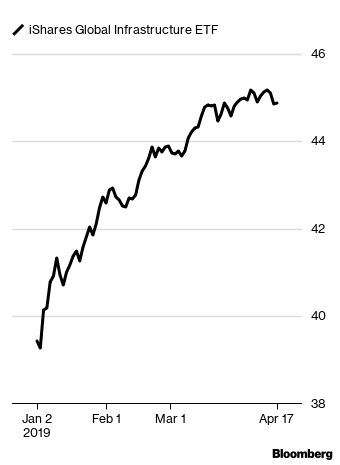 , rose 13.8 percent in 2019’s first quarter.
, rose 13.8 percent in 2019’s first quarter.
Focus on Wealth Preservation
Our cautious approach to risk assets and our preference for U.S. Treasuries was well-rewarded last quarter. The question now: Is it safe to “buy the dip”?
The narrative behind our caution was straightforward. Higher U.S. interest rates and the Federal Reserve’s cutting the size of its balance sheet created a global liquidity shortage at a time when global growth was already slowing. This challenged the outlook for U.S. (and global) equities and made the more than 3 percent yield on Treasuries attractive.
The Fed decided to stay more focused on the tight domestic labor market instead of the weakening global economy and global financial markets. But increasingly, the markets have taken the view that the Fed will change course through 2019. As a result, Treasury yields and the U.S. dollar have started to fall.
This implicit easing in monetary conditions, combined with the S&P 500 moving into “oversold” territory in December, provides some scope for a short-term bounce in U.S. equities. Equity volatility should fall and encourage a recovery in risk assets such as emerging-market equities and technology. There might even be scope for U.S. banks to bounce if bond yields head back to 2.8 percent and oil prices firm up.
Actions speak louder than words, however, and until policy easing is more explicitly embraced by the Fed, the omens for the longer-term outlook for U.S. equities and risk assets more generally remain clouded.
Our models show an increased risk of U.S. recession in 2020, confirmed by credit yields starting to rise even as Treasury yields are falling. In China, where policy is being eased more explicitly, trade wars and tech wars continue to obscure the picture. And in the euro zone there are early signs of unemployment fears beginning to rise just as the European Central Bank finishes its quantitative-easing program. We also worry that several systemically important euro-zone financial institutions have fallen more than 40 percent through 2018.
Thus, for longer-term investors, or those for whom wealth preservation is key, we recommend maintaining a defensive bias. When U.S. new orders fall as they have recently, real yields tend to fall. This will help support precious metals, equity income, utilities and infrastructure stocks.
Way to play it with ETFs: Balchunas points to the iShares Global Infrastructure ETF (IGF)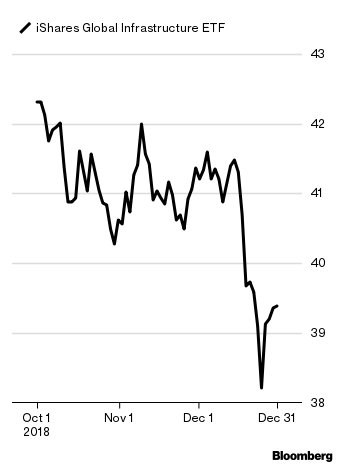 . The ETF has 40 percent allocation to utilities and a 3.3 percent yield. It has a dose of emerging markets exposure, although its biggest allocation is the U.S., at 37 percent.
. The ETF has 40 percent allocation to utilities and a 3.3 percent yield. It has a dose of emerging markets exposure, although its biggest allocation is the U.S., at 37 percent.
Performance of last quarter’s ETF plays: The ETF Balchunas chose as the best proxy for Ketterer’s views last quarter, the iShares U.S. Treasury Bond ETF (GOVT)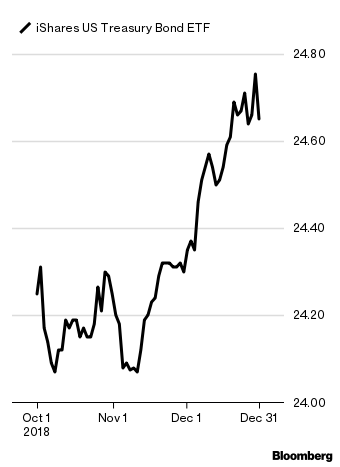 , rose 2.1 percent.
, rose 2.1 percent.
Go Long on Treasuries
U.S. Treasuries have seen a perfect storm these last few weeks. The key question for investors is whether they are now a buy or a sell. We say buy!
The Treasury sell-off started with the short end of the yield curve, as the Federal Reserve hiked rates. The hawkish tone was bolstered by a record number on the ISM Non-Manufacturing index, which measures business conditions in nonmanufacturing industries. Inflation fears intensified as unemployment fell to 3.7 percent, its lowest level since 1969, and OPEC promised continued supply discipline, boosting oil prices. Finally, yields on very long-dated Treasuries went well above long-held ranges in the wake of Federal Reserve Chair Jerome Powell’s suggestion that this economic cycle might persist “effectively indefinitely.” As a result, U.S. 10-year yields moved toward 3.25 percent and the 30-year pushed toward 3.45 percent.
Such yields will be hard to maintain. Although U.S. growth currently remains healthy, rising real [inflation-adjusted] rates and a stronger dollar will begin to challenge activity, as will higher oil prices squeezing real incomes. The rest of the world will also suffer as dollar strength increases the funding costs for the $12 trillion of dollar-denominated debt raised outside the U.S.
For us, therefore, the expectation of rising prices on Treasuries makes those with yields above 3 percent attractive now. Slower global growth and an inability of OPEC to maintain its supply discipline will likely see West Texas Intermediate crude prices closer to $65 than $75 by yearend. We suggest buying very long-dated bonds—all the way up to the 30-year—with yields close to 3.4 percent, since even the hawks don’t expect more than four rate rises in the coming year.
Bonds also look attractive relative to equities. The recent weakness in equities suggests some investors are already selling them to lock in additional income. Alternatively, we suggest buying bond-sensitive equities. Although health-care stocks have already done well, utilities, telecoms, and food producers have yet to catch up.
Another equity strategy is to buy U.S.-exposed stocks in markets that have sold off aggressively for other reasons. A basket of U.S-exposed euro-zone stocks will likely perform well, and with Italian equities stressed due to domestic politics, companies such as Fiat-Chrysler Automotives N.V. and Luxottica Group SpA, which both have over 50 percent of their sales in the U.S., could provide a cheap route to buying U.S. earnings.
Finally, in a world where global growth is slowing, food producers typically outperform industrial metals, and with expectations of a new El Niño this year, prices on soft commodities [commodities that are grown rather than mined] should rally.
Way to play it with ETFs: Balchunas points to the $6.5 billion iShares U.S. Treasury Bond ETF (GOVT)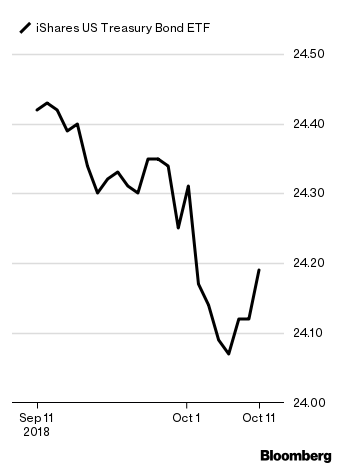 which invests along the entire yield curve. It charges 0.15 percent.
which invests along the entire yield curve. It charges 0.15 percent.
Performance of last quarter’s ETF plays: The iShares 20+ Year Treasury Bond ETF (TLT)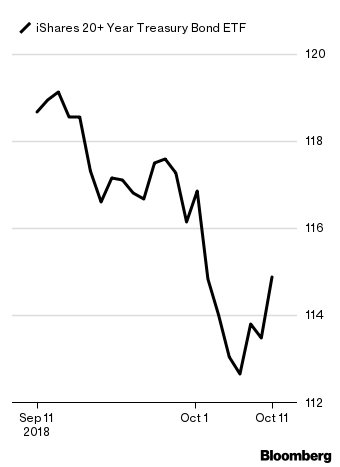 and the Consumer Staples Select Sector SPDR ETF (XLP)
and the Consumer Staples Select Sector SPDR ETF (XLP)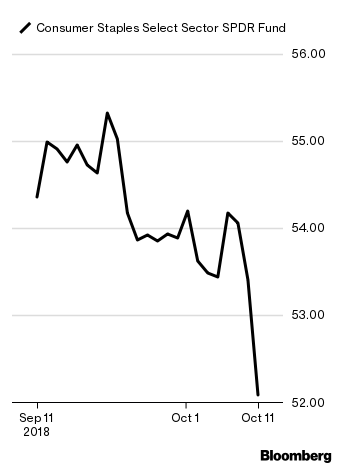 , Balchunas’s choice to play on the consumer staples theme, rose 5.2 percent in the third quarter. The iShares 20+ Year Treasury Bond ETF (TLT)
, Balchunas’s choice to play on the consumer staples theme, rose 5.2 percent in the third quarter. The iShares 20+ Year Treasury Bond ETF (TLT) fell 3.4 percent.
fell 3.4 percent.
Look for ‘Peak Growth’ in the U.S.
A defining feature of 2018 has been how the Trump tax cuts have helped boost U.S. GDP to be consistently faster than other developed economies. However, GDP growth of 4.1 percent in the year’s second quarter will likely be “peak growth” for this cycle. Our early-warning indicators suggest that activity is now likely to slow in most major economies through the second half.
Despite the risk of slower U.S. growth, Federal Reserve Chair Jerome Powell has indicated his willingness to push rates higher in coming months. The U.S. dollar has gained due to the divergence in relative growth, higher U.S. rates and a faster pace of tightening. Not only has this meant pressure on developed markets, it’s also signaled that global liquidity conditions are tightening rather than easing. We expect dollar strength to be sustained through the second half.
U.S. investors have largely escaped the consequences of dollar strength and tightening global liquidity. The pain has been felt not only in emerging-market bonds, equities and currencies, but also in the global systemically important financial institutions (SIFIs), which fell 20 percent between late January and the end of June.
Given this backdrop for the global economy and liquidity, we expect markets to reward wealth preservation in the second half, with bonds looking increasingly attractive relative to equities. We believe there should be opportunities to make money buying 10-year and 30-year U.S. Treasuries above 3 percent.
For equity investors, such a backdrop will tend to keep financials under pressure and favors consumer staples and consumer service stocks. We are becoming less positive on the outlook for technology stocks; the adoption of the new communication sector will likely add to the regulatory volatility within the sector. [S&P Global Ratings and MSCI Inc. are reclassifying a number of stocks previously in the technology, telecom and media sectors, and including some of them in a new communications-services group.]
We remain buyers of equity volatility, which we expect to rise on a trend basis in the next year, given the rise in real and nominal rates.
Way to play it with ETFs: For a Treasury play, investors can use the iShares 20+ Year Treasury Bond ETF (TLT)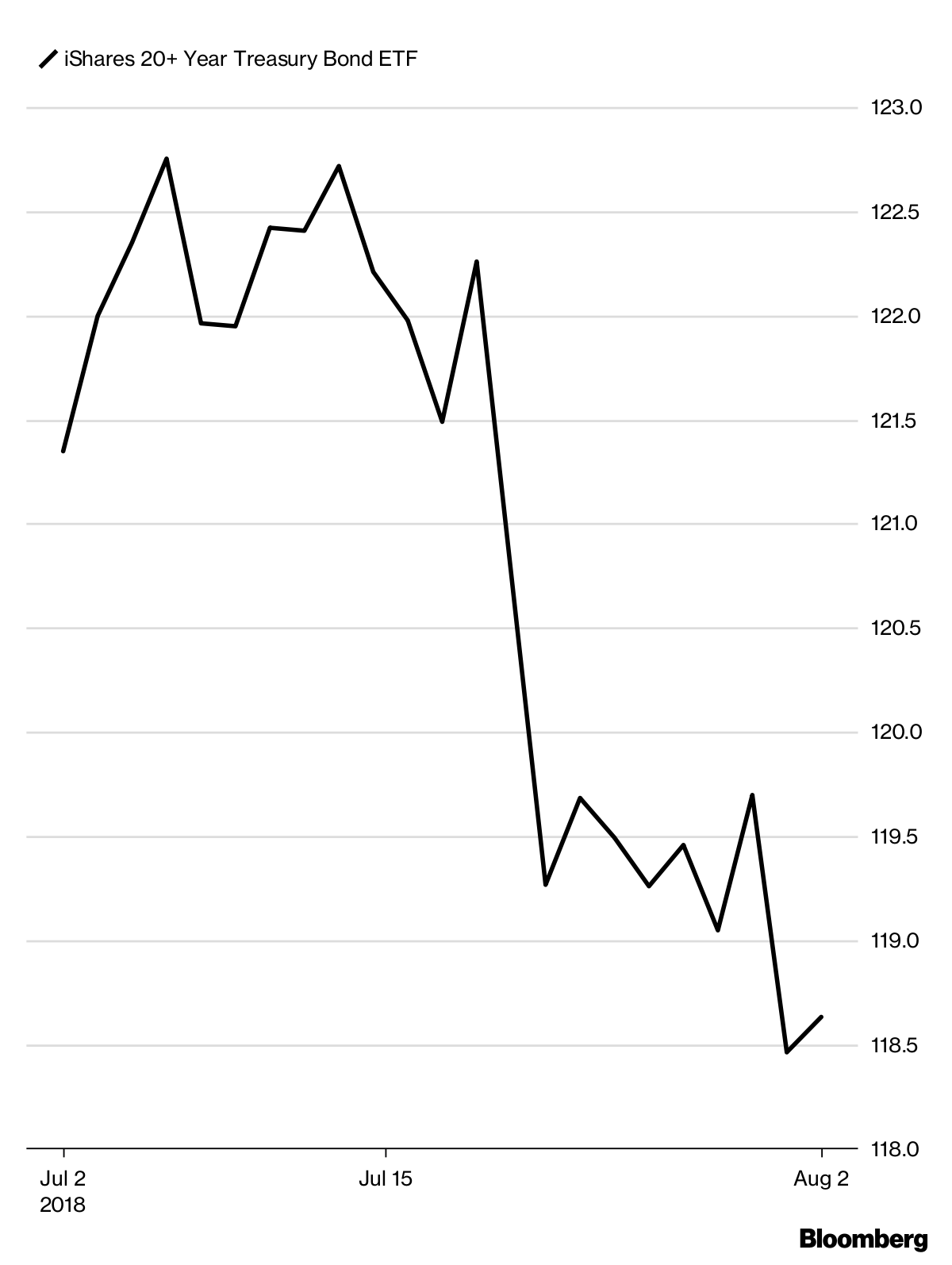 , which is extremely liquid and charges 0.15 percent, Balchunas said. For the consumer staples play, there is the Consumer Staples Select Sector SPDR ETF (XLP)
, which is extremely liquid and charges 0.15 percent, Balchunas said. For the consumer staples play, there is the Consumer Staples Select Sector SPDR ETF (XLP)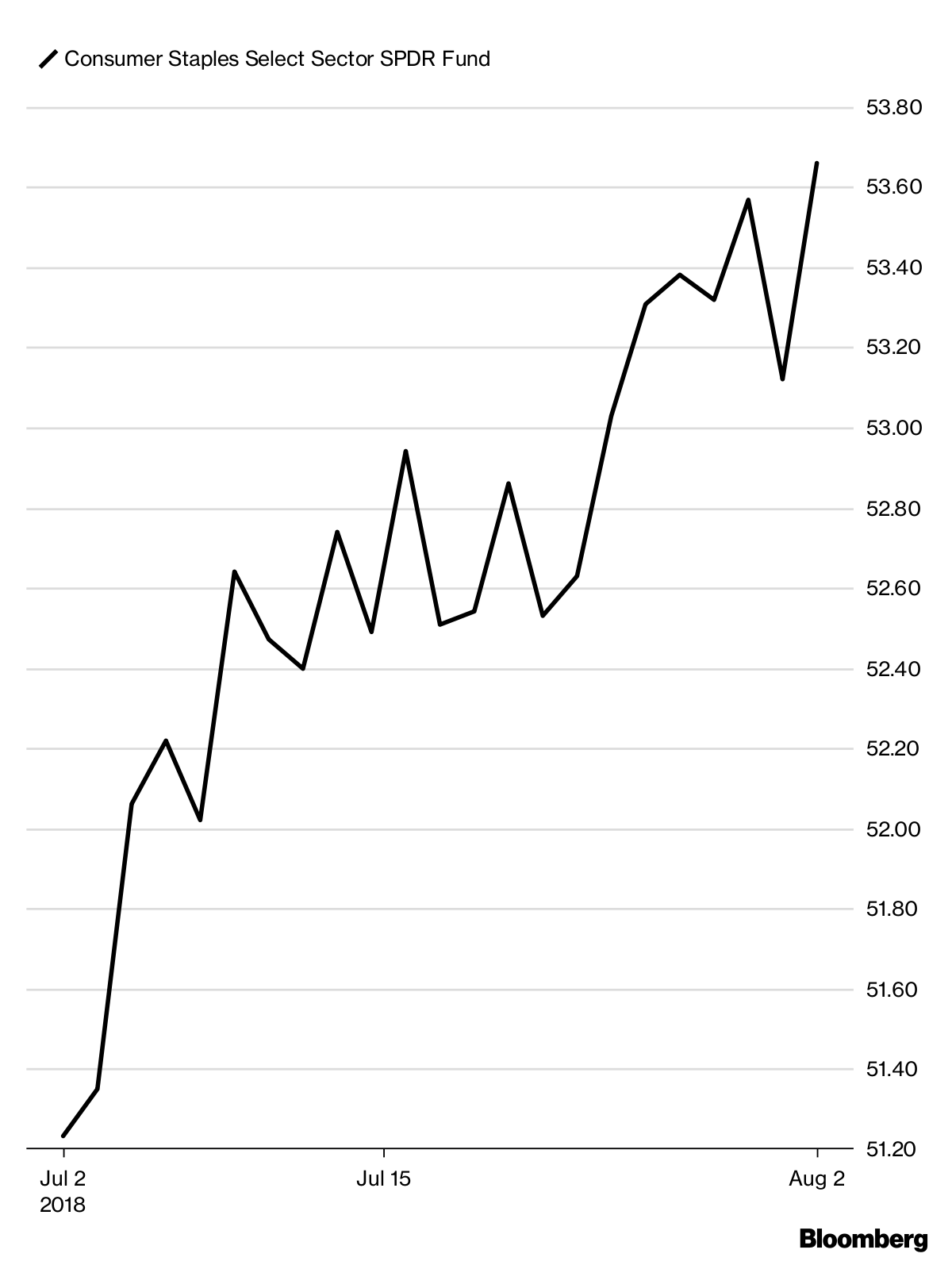 . It, too, is super-liquid and also super-cheap, at 0.13 percent.
. It, too, is super-liquid and also super-cheap, at 0.13 percent.
Performance of last quarter’s ETF plays: Balchunas suggested the VanEck Vectors ChinaAMC China Bond ETF (CBON)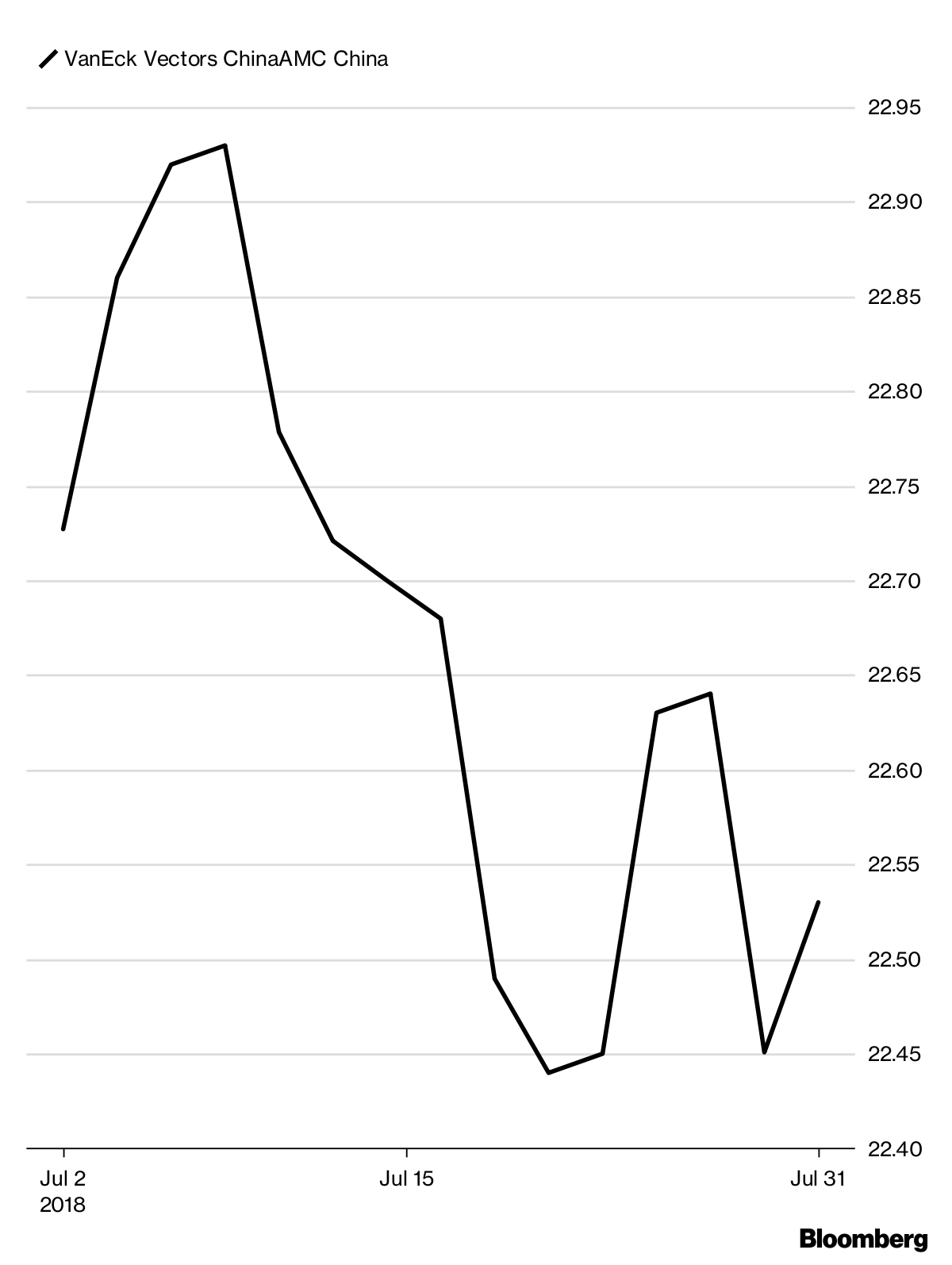 for those who wanted exposure to Chinese government debt. The ETF fell 4.5 percent in the second quarter.
for those who wanted exposure to Chinese government debt. The ETF fell 4.5 percent in the second quarter.
Sell the Rallies
Equity clouds may have a silver lining.
Many investors appear to be assuming that the equity volatility of early February and mid-March was largely technical. It was shallow, short-lived and lacked major contagion into other asset classes, prompting an apparent willingness to “buy the dips.”
We, however, view these bouts of market nervousness as part of an incomplete market correction and suggest that investors should “sell the rallies” and focus on more defensive assets and strategies.
Why so cautious? First, we believe that the global economic cycle has begun to slow. Our activity surprise measures, which track the extent to which economic data deviates from forecasts of investment professionals on a daily basis from the previous quarter, are negative for the first time since 2016. We doubt that the U.S. can “decouple” from a global slowdown. U.S. tax cuts may only serve to offset the impact of the higher U.S. bond yields and Fed funds rates seen in the last 18 months. With Chinese growth slowing, euro-zone activity decelerating and global real money growth decelerating rapidly, global “peak growth” is probably behind us, making U.S. and global earnings forecasts liable to disappointment.
Despite these signs of slowing growth, policymakers in the U.S. and other developed economies appear intent on “normalizing” monetary policy. The combination of rate rises and the reduction in the pace of monetary stimulus from the European Central Bank and the Bank of Japan, as well as the reduction in the Fed balance sheet in the U.S., will challenge the upside for global risk assets.
Slower growth and tighter monetary conditions are also a toxic combination for highly indebted companies or economies. That means U.S. high-yield debt will likely struggle, as will the banking sectors and currencies of highly indebted economies such as Canada, Australia and Sweden, which may unsettle markets more generally.
In such an environment, where are the investment opportunities? As economic growth disappoints, expect bonds to beat equities. We favor U.S. Treasuries over other developed-market government bonds. Slowing growth and easing inflation pressure also favor Chinese government debt. Options strategies that bet on a long-term higher level of market volatility or that hedge equity risk will also likely be rewarded.
Finally, many investors typically turn toward gold if global growth slows. However, silver has lagged behind gold by 17 percent in the last year and almost 50 percent in the last five years, suggesting that it may have more upside potential if the economic outlook becomes cloudier.
Way to play it with ETFs: For Chinese government debt, an asset class thought impossible for retail investors to get exposure to just five years ago, Balchunas points to the VanEck Vectors ChinaAMC China Bond ETF (CBON)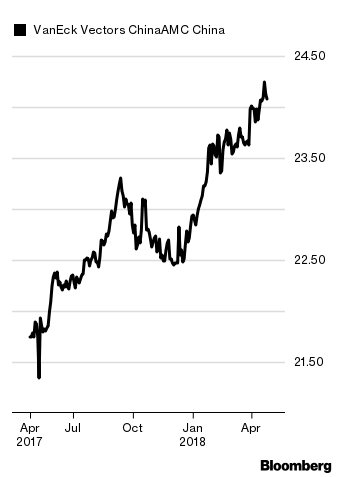 . It tracks fixed-rate, renminbi (“RMB”)-denominated bonds issued in the People’s Republic of China by Chinese credit, governmental and quasi-governmental issuers. While the fee of 0.50 percent is decent for such exotic exposure, Balchunas notes that the ETF is very small, at $4.8 million. Those wanting to buy the ETF should use a limit order to specify the price they are willing to pay.
. It tracks fixed-rate, renminbi (“RMB”)-denominated bonds issued in the People’s Republic of China by Chinese credit, governmental and quasi-governmental issuers. While the fee of 0.50 percent is decent for such exotic exposure, Balchunas notes that the ETF is very small, at $4.8 million. Those wanting to buy the ETF should use a limit order to specify the price they are willing to pay.
Performance of last quarter’s ETF plays: The Guggenheim Defensive Equity ETF (DEF) was Balchunas’s pick as a defensive market maneuver. The ETF was virtually flat in the first quarter, down 0.1 percent. Two other picks, the PowerShares DB Agriculture Fund (DBA)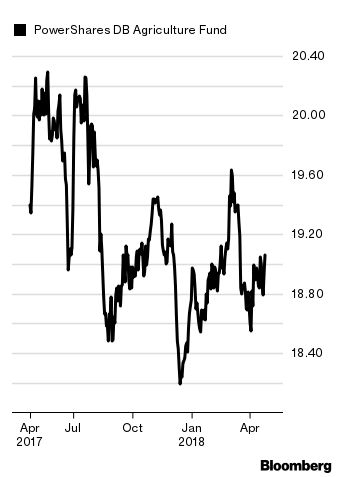 and the VanEck Vectors Agribusiness ETF (MOO)
and the VanEck Vectors Agribusiness ETF (MOO)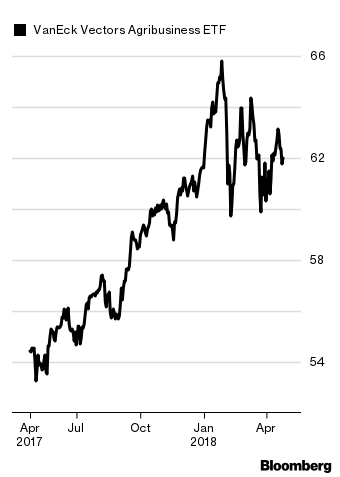 , were both positive, if barely—up 0.2 percent and 0.1 percent respectively.
, were both positive, if barely—up 0.2 percent and 0.1 percent respectively.
Start Selling the Rallies
At the end of 1996, then-Federal Reserve Chairman Alan Greenspan chided market participants for their “irrational exuberance.” Today, there appears to be little reason to repeat his comments. The shift into risk assets by investors looks like rational exuberance in response to a benign economic backdrop not seen since the 1960s, with tax cuts and low rates expected to boost economic recovery. We doubt, however, that this can become sustainable exuberance, as 2018 will likely see this benign growth and inflation mix challenged. Fear will replace greed, rewarding more-defensive investments.
Signs of excess appear almost everywhere. The global economy looks close to a cyclical peak. The U.S. ISM manufacturing index, the Institute for Supply Management’s measure of economic activity in that sector, and similar measures for the euro zone are close to 30-year highs. Falling unemployment rates during the last six months in most of the Group of 20 biggest industrialized and emerging economies have helped boost consumer confidence, while low interest rates and stable inflation have encouraged consumers and corporations to reduce their savings and spend more.
Equities are showing classic late-cycle signs, with industrial stocks up 30 percent over the last 12 months. Basic-resource stocks are up 35 percent, while the 40 percent rise in oil prices is also characteristic of this phase for the global economy. The Goldilocks economy (sustained low inflation despite economic recovery) has helped push U.S. price-earnings ratios to 25 times trailing earnings and 32 times on a CAPE (cyclically adjusted p-e) basis, levels seen only in the tech bubble during the last 70 years—higher even than in the Nifty 50 era of the early 1960s.
With interest rates subdued and central banks adding $2.5 trillion to their balance sheets in the past year, liquidity has been plentiful, keeping volatility stubbornly low and creating some of the most benign financial market conditions of the last 30 years. Such benign conditions for the global economy and markets have rarely been sustainable for long. We worry that a China growth slowdown has the capacity to offset any U.S. or euro zone recovery, while liquidity is likely to be reined back in the U.S. as the Federal Reserve tightens monetary policy and in the euro zone with tapering by the European Central Bank.
If global growth slows, then interest rate expectations may have run ahead of themselves, making shorter-dated Treasuries attractive. With liquidity likely to be less plentiful, Treasury inflation-protected securities (TIPS) could underperform conventional Treasuries. Equities are now signaling “overbought” relative to bonds on our short-term tactical models and sentiment indicators. If earnings-per-share growth is 5 percent to 6 percent, as our models suggest, rather the consensus of 13 percent, oversold defensive sectors such as consumer staples and health care may outperform. Agricultural commodities are relative safe havens compared with industrial commodities.
Successful long-run investors are typically those who avoid the losses at the peaks of markets rather than those who focus on the next big win. It may not yet be time to be in full defensive mode. But after the gains of the last year and the post-credit-crunch bull market, it is time for equity investors to start selling the rallies rather than buying the dips.
Way to play it with ETFs: For defensive sectors, there’s the Guggenheim Defensive Equity ETF (DEF)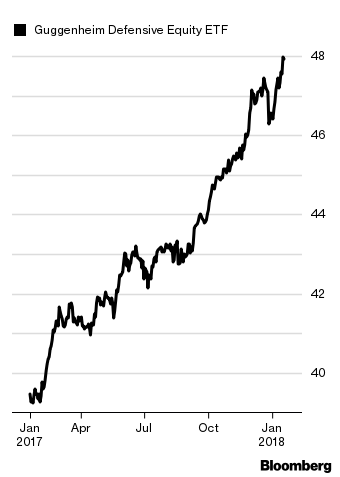 , which tracks the 100 companies that have the best risk and return profiles during a bear market. It charges 0.60 percent. To play agricultural commodities, there is the PowerShares DB Agriculture Fund (DBA)
, which tracks the 100 companies that have the best risk and return profiles during a bear market. It charges 0.60 percent. To play agricultural commodities, there is the PowerShares DB Agriculture Fund (DBA)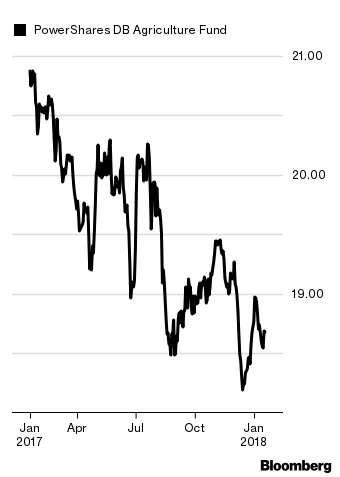 or the VanEck Vectors Agribusiness ETF (MOO)
or the VanEck Vectors Agribusiness ETF (MOO)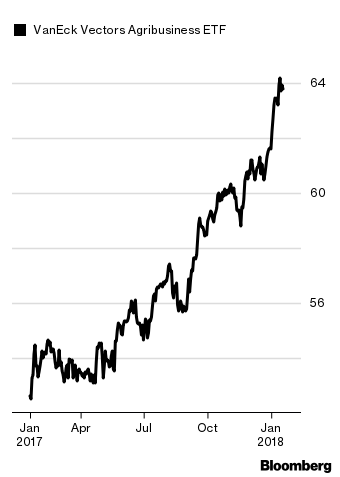 . DBA charges 0.89 percent, and MOO’s fee is 0.54 percent.
. DBA charges 0.89 percent, and MOO’s fee is 0.54 percent.
Brian Singer
Portfolio co-manager, William Blair Macro Allocation Fund
Consider Chinese debt
While most central banks around the world have tended toward cutting interest rates over the past couple of years to support their economies by expanding access to credit, the People’s Bank of China (PBOC) has held policy rates relatively steady. Only recently has it cut rates.
Now, we count 5-year Chinese sovereign debt among the most relatively attractive across our global sovereign debt universe.
After cutting rates and guiding expectations lower in March and April, the PBOC has largely paused and made little change to monetary policy. While this is consistent with the continued stabilization in the economy, the overall outlook for the year has remained more ambiguous. And the Chinese government has said little about a specific growth target in 2020.
Looking ahead, the pickup in economic activity is likely to be driven by supply rather than demand. Much of the consumption seems to be attributed to near-term stocking of electronics (driven by “work from home”) and medical equipment. Lastly, the outlook for “slowly but steadily” increasing participation by, and inflows from, investors continues to look favorable. These lead us to think there may once again be pressure to lower rates rates in the medium term, after it ebbed in the summer.
The combination of possible lower rates and more difficult increases in growth from here may provide a relative tailwind to China fixed income. We also expect this exposure to have low correlation to many other exposures (such as country- and sector-level equities), so it provides investors nice diversification benefits.
How to play it with ETFs: The VanEck Vectors ChinaAMC China Bond ETF (CBON)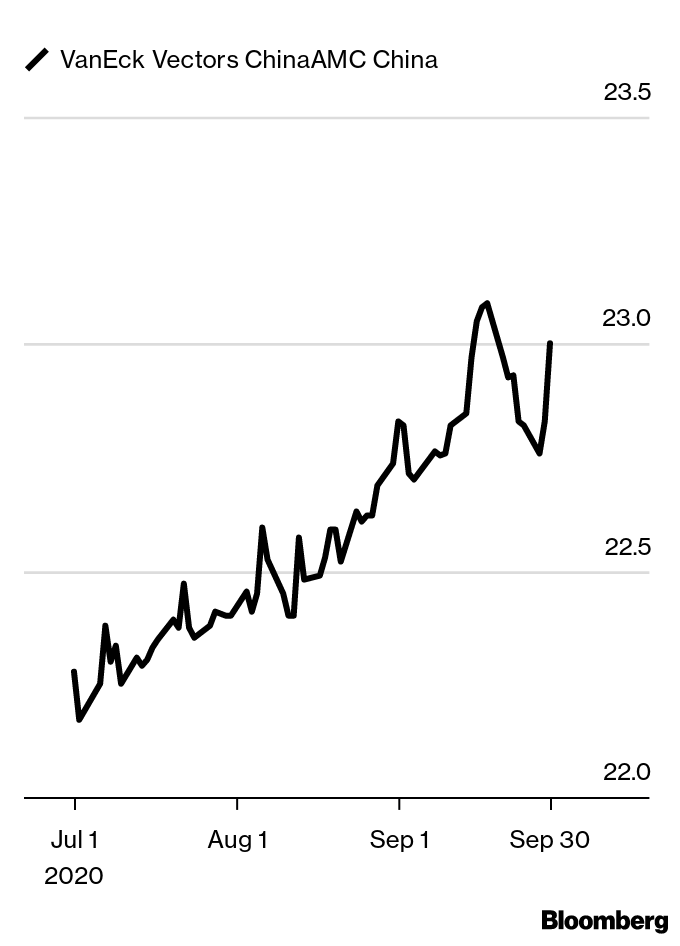 is one of the few ETFs that invests in mainland China debt. Near 20% of the small ($16 million) fund is sovereign debt and 67% is corporate debt. The expected yield is 2.95% and the expense ratio is 0.50%.
is one of the few ETFs that invests in mainland China debt. Near 20% of the small ($16 million) fund is sovereign debt and 67% is corporate debt. The expected yield is 2.95% and the expense ratio is 0.50%.
Performance of last quarter’s ETF plays: The iShares MSCI United Kingdom ETF (EWU)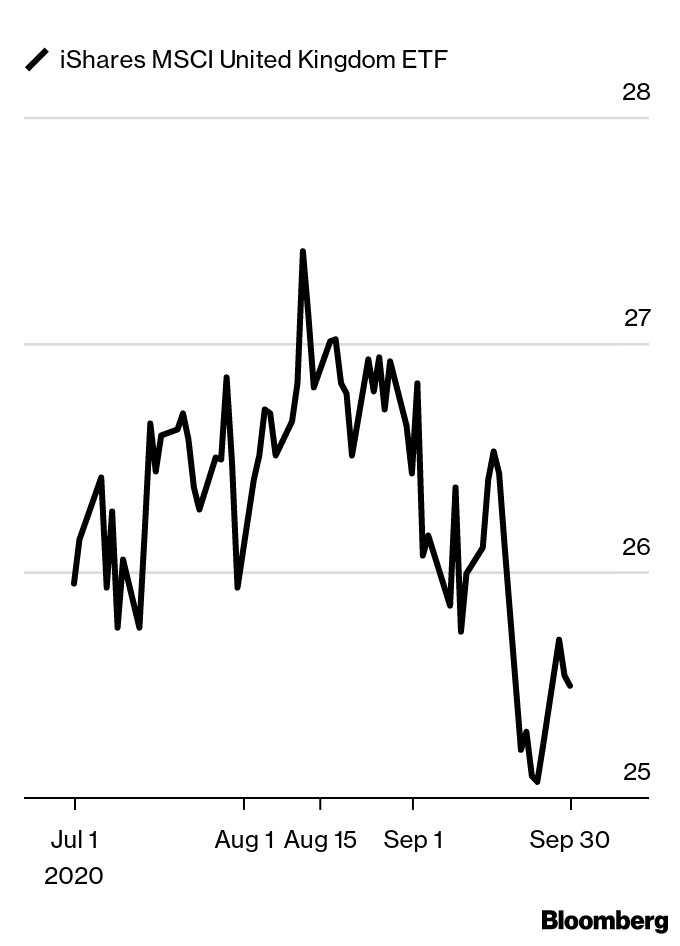 fell 0.4%.
fell 0.4%.
British Bargains
The virus-driven downturn has now made the U.K. market one of the cheapest in our investment universe, with its current pricing about 80% below our estimate of its fundamental value.
The U.K. was hit harder by the pandemic than most countries, with respect to cases and fatalities. After an initial lag, Boris Johnson’s government has reversed its original stance and followed the same strict path as other European governments, significantly slowing transmission of the coronavirus. Restrictions on social and economic activity are already being lifted. In addition, the U.K. was able to swiftly implement large monetary and fiscal policy support.
Looking past the pandemic, the U.K.’s government is more growth-friendly than those headed by previous conservative prime ministers. Meanwhile, faced with a tight time frame to negotiate future trade arrangements with the European Union, we may end up with a Brexit that looks more like “no deal” than a comprehensive free-trade arrangement. Although this is bad for the economy, markets have had ample time to adjust.
It is unlikely that equity markets overall will deliver strong returns while economic activity slowly resumes, but we believe the medium-term prospects for the recovery of U.K. equities are among the brightest.
How to play it with ETFs: The iShares MSCI United Kingdom ETF (EWU)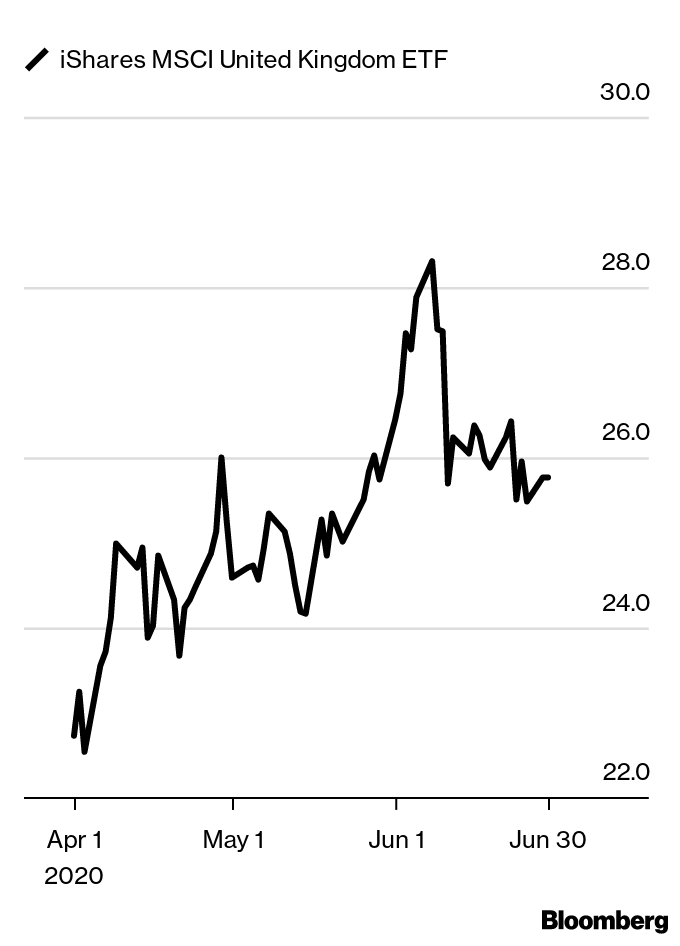 offers market cap-weighted exposure, with pharma (13%) and oil and gas (11.2%) the largest sector exposures. The fund is the most-traded index fund tracking the U.K. market and has an expense ratio of 0.50%.
offers market cap-weighted exposure, with pharma (13%) and oil and gas (11.2%) the largest sector exposures. The fund is the most-traded index fund tracking the U.K. market and has an expense ratio of 0.50%.
Performance of last quarter’s ETF plays: The iShares MSCI Brazil ETF (EWZ)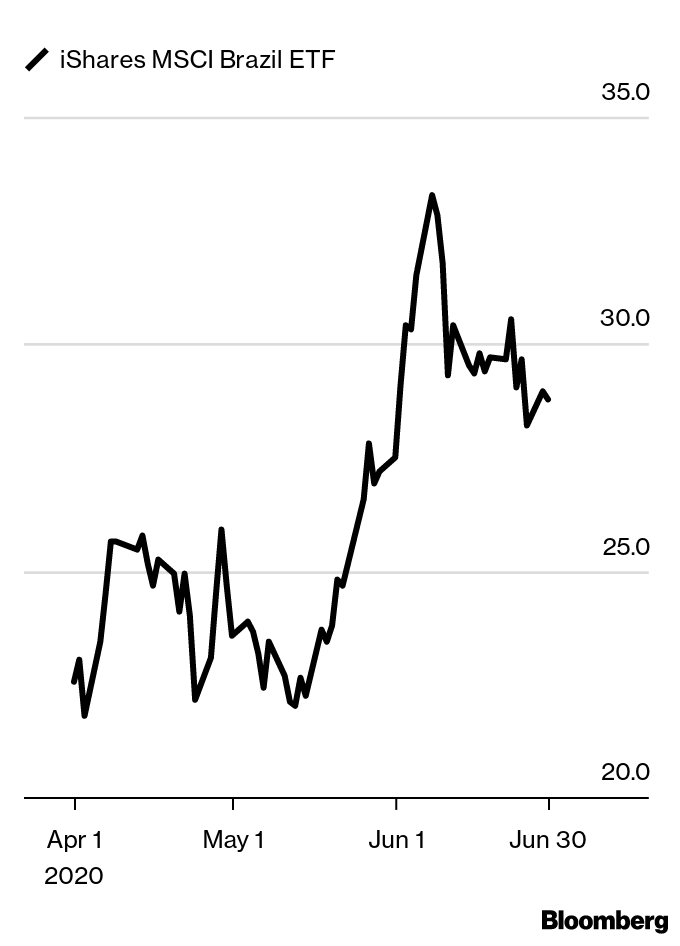 rose 20.6% in the second quarter.
rose 20.6% in the second quarter.
Play a Battered Brazil
The effects of Covid-19 will likely continue to dominate market sentiment for at least the next several months, in concert with uncertainty about oil prices and other concerns. Amid the market turmoil associated with the virus, Brazil underperformed other equity markets to a larger extent than would otherwise be expected during most of the first quarter. It is common for Brazil to fall more sharply than others in a risk-off environment. However, the relative moves since the virus started weighing on markets in mid-February cannot be explained by risk-off sentiments alone.
It seems likely that Brazil has suffered from both the general market turbulence wrought by the rapid global spread of the virus and the frequent association of the country with other largely energy-oriented economies. In reality, however, the portion of Brazil’s economy that is dependent on energy is much smaller than others by comparison, and other more energy-heavy markets have outperformed Brazil in recent weeks. Of the more than 30 equity markets we follow closely, Brazil’s was the second-worst performer in March (-29%) and the third-worst for the quarter (-36%).
Reforms being pursued by the new administration, led by Brazilian President Jair Bolsonaro, were driving positive sentiment from investors before the virus outbreak and oil price collapse. We share this optimism and see these reforms as a material contributor to economic growth going forward.
Our optimism is also fueled by the fact that the Brazilian equity market is cheap on a fundamental basis. We estimate that Brazil is currently priced at less than half of its fundamental value, and expect that the market has the potential to generate substantial returns during the next five years.
The market has thus far focused largely on one aspect of these reforms: the pension system. If successful, this will help stabilize the government budget, which has become increasingly burdened by debt. The unexpected emergence of the virus has Brazil, as well as other governments around the world, launching fiscal stimulus packages that are likely to weigh on government finances in the near term.
We understand some of this concern in the short run, but don’t see this development as disrupting the recent cooperation in the government to progress on these reforms. The reform process is on hold but likely to resume as this crisis subsides. Therefore, Brazil has the potential to rebound well when markets better decipher that the country is less reliant on high oil/energy prices than is thought, and the market again returns to more of a risk-on sentiment.
Since the Brazilian currency (the real) is also fundamentally attractive in our view, an unhedged ETF could be a nice way to play this opportunity.
How to play it with ETFs: The iShares MSCI Brazil (EWZ)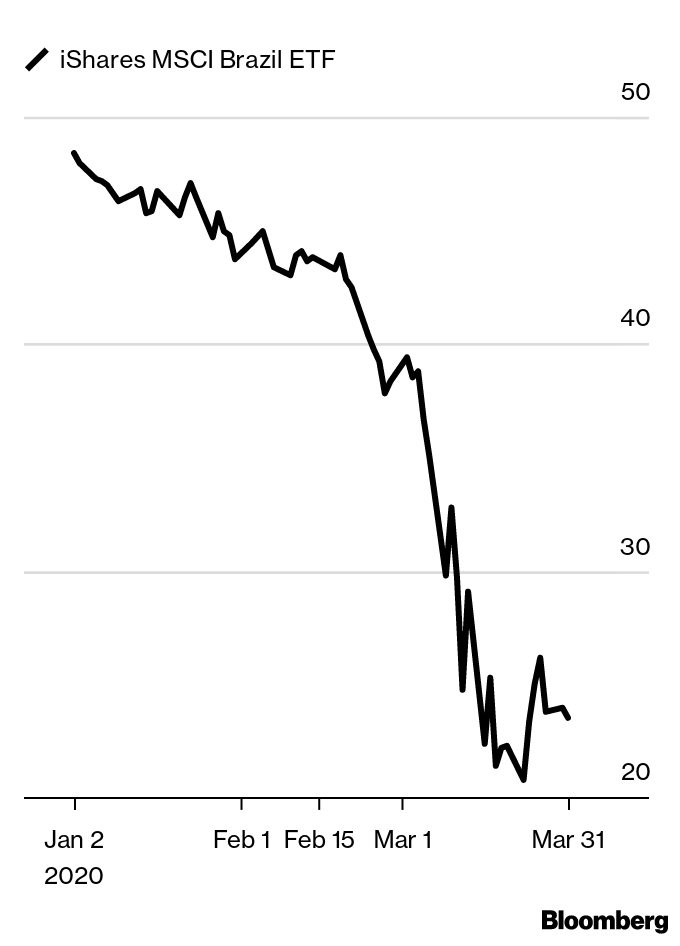 is Balchunas’s pick to play Singer’s theme. It covers 85% of the listed equity market in Brazil and is not currency hedged. It is a market cap-weighted ETF with $5.2 billion in assets and a fee of 59 basis points.
is Balchunas’s pick to play Singer’s theme. It covers 85% of the listed equity market in Brazil and is not currency hedged. It is a market cap-weighted ETF with $5.2 billion in assets and a fee of 59 basis points.
Performance of last quarter’s ETF plays: The iShares MSCI United Kingdom ETF (EWU) , and its sibling, the iShares Currency Hedged MSCI United Kingdom ETF (HEWU)
, and its sibling, the iShares Currency Hedged MSCI United Kingdom ETF (HEWU)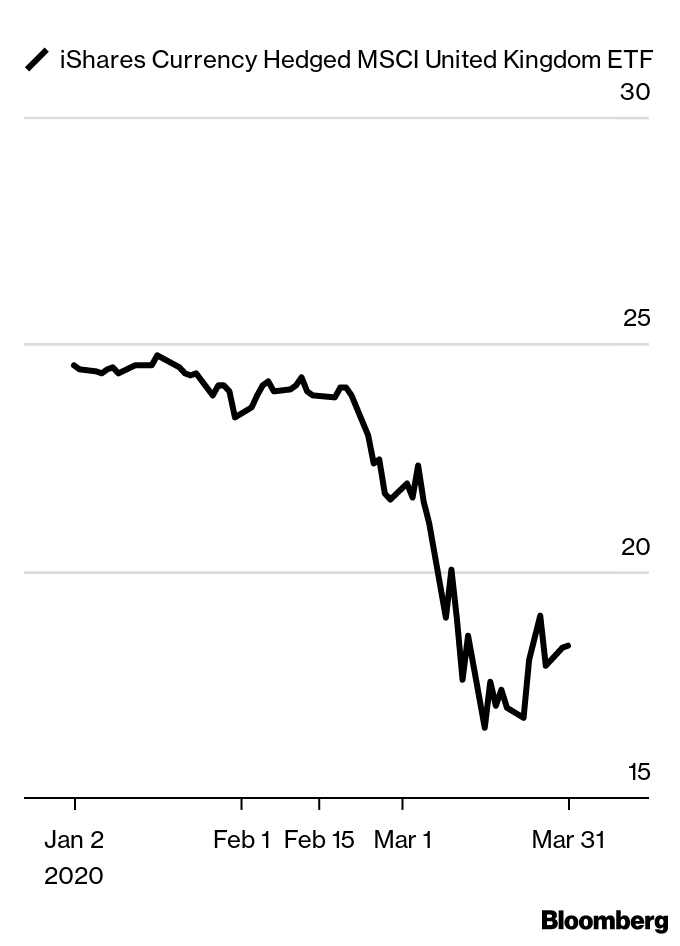 , dropped 30% and 24.6%, respectively.
, dropped 30% and 24.6%, respectively.
Check out the U.K.
Boris Johnson’s Conservative Party was re-elected in December’s U.K. general election with its largest majority in three decades, substantially reducing the likelihood of a “no-deal” Brexit. Johnson’s hard line on Brexit had remained a considerable risk up until the Dec. 12 election. To be clear, a departure from the European Union (EU) with no withdrawal agreement in place (“hard” or “no deal” Brexit) was the most negative potential outcome, likely to produce a significant adverse shock to growth and trade.
The size of the election victory substantially reduces the ability of opposition parties—and of factions in the conservative party—to derail the government’s Brexit intentions, which these groups were able to do prior to the election. These developments subdue a major negative risk to the U.K. equity market as well as the British pound (GBP). We think this creates a more positive environment for investors.
This is important because both U.K. equities and the pound remain cheap on a fundamental basis. The U.K. equity market is 60% cheaper than fair value and the British pound sits about 20% below its equilibrium rate, or the level at which supply and demand for the currency are equal, according to our calculations. This is based on increased future earnings levels and expanding growth rates, as well as current and projected demographic trends such as overall population growth, immigration and emigration projections, and workforce characteristics.
While a “no deal” Brexit is not yet entirely removed as a risk, as we enter 2020 we believe it is of very low intensity and not a large impediment to the valuation opportunities in U.K. equities and the pound. With this risk having been largely diluted, investors would be wise to consider an investment in the U.K., both in the equity market and in the currency.
How to play it with ETFs: Balchunas says the iShares MSCI United Kingdom ETF (EWU)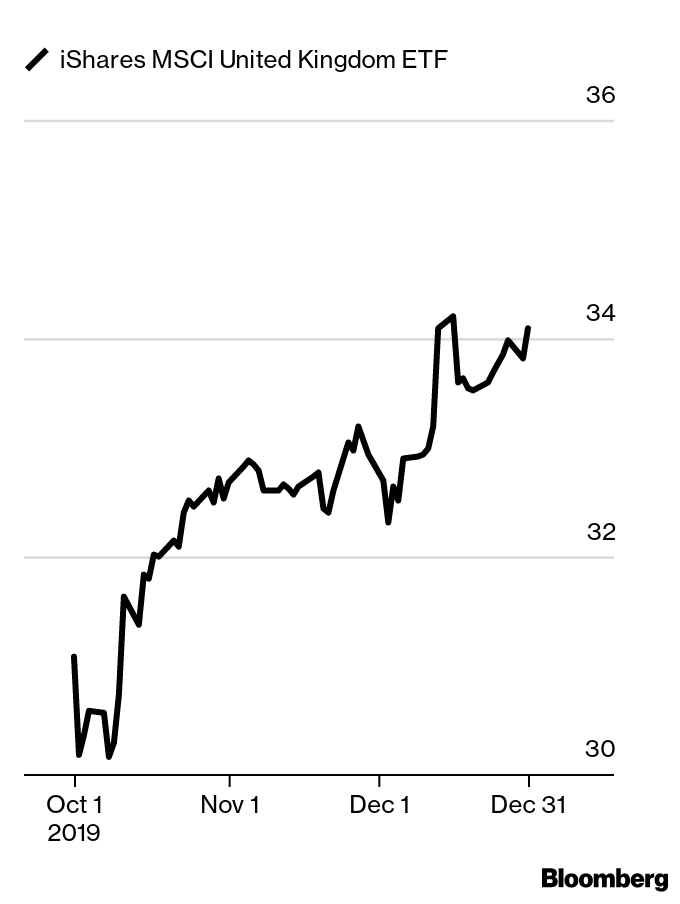 makes sense as a way to get unhedged (currency) exposure to U.K. equities. The ETF holds stocks like HSBC Holdings, BP and AstraZeneca. It’s pretty big for a country fund, at $2.6 billion, and charges 0.47%. For those looking to remove the foreign exchange component from this play, there’s EWU’s sibling, the iShares Currency Hedged MSCI United Kingdom ETF (HEWU)
makes sense as a way to get unhedged (currency) exposure to U.K. equities. The ETF holds stocks like HSBC Holdings, BP and AstraZeneca. It’s pretty big for a country fund, at $2.6 billion, and charges 0.47%. For those looking to remove the foreign exchange component from this play, there’s EWU’s sibling, the iShares Currency Hedged MSCI United Kingdom ETF (HEWU) .
.
Performance of last quarter’s ETF plays: Balchunas’s choice, the iShares MSCI India ETF (INDA)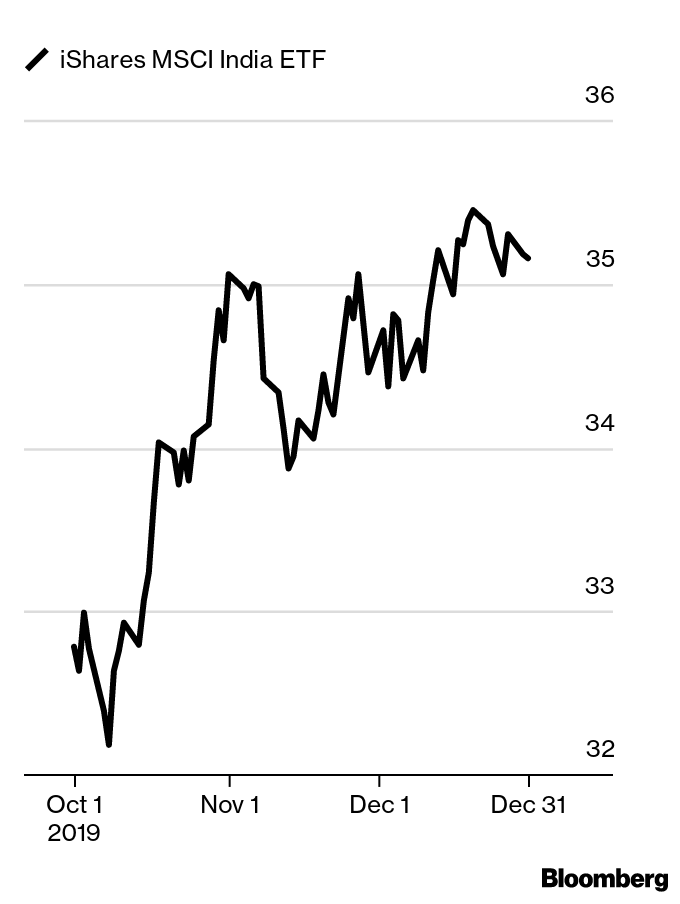 , rose 4.8% in the quarter.
, rose 4.8% in the quarter.
Head Into Indian Equities
When India unveiled a $20 billion package of corporate tax cuts in September, it sparked a jump in the country’s stock market, and we think the move by Prime Minister Modi will remain a positive for investors in Indian equities.
Economic growth in India has been slowing—albeit from rates still much faster than developed markets—and combined with high corporate tax rates investors have had reason to be somewhat concerned about Indian stocks. As we’ve noted on numerous occasions, despite the generally higher volatilities that emerging economies may exhibit (in the near-term, relative to developed economies), we believe that (positive) social institutional change among emerging economies is advancing at a faster rate than that of developing economies. That is giving a boost to intermediate- and longer-term growth prospects in these emerging economies, especially on a relative basis.
The promise of a lower effective tax rate delivered a short-term boost, but should also provide enduring uplift in the level of earnings to which shareholders have a claim. A drop in the effective tax rate of about six percentage points should have almost a one-to-one benefit to corporate earnings per share. There is also the possibility that a smaller tax burden will result in greater investment by companies that could lead to an increased growth rate of corporate earnings.
Even before the tax change, we thought Indian equities were about 30% undervalued. We don’t expect that to be corrected overnight, but the longer-term tide, as gross domestic product grows at around 6%, should continue to pull prices toward fundamental value, and the tax cut is a tailwind. Over the next five years Indian equities have the potential to return around 10% per annum.
How to play it with ETFs: Balchunas points to the iShares MSCI India ETF (INDA)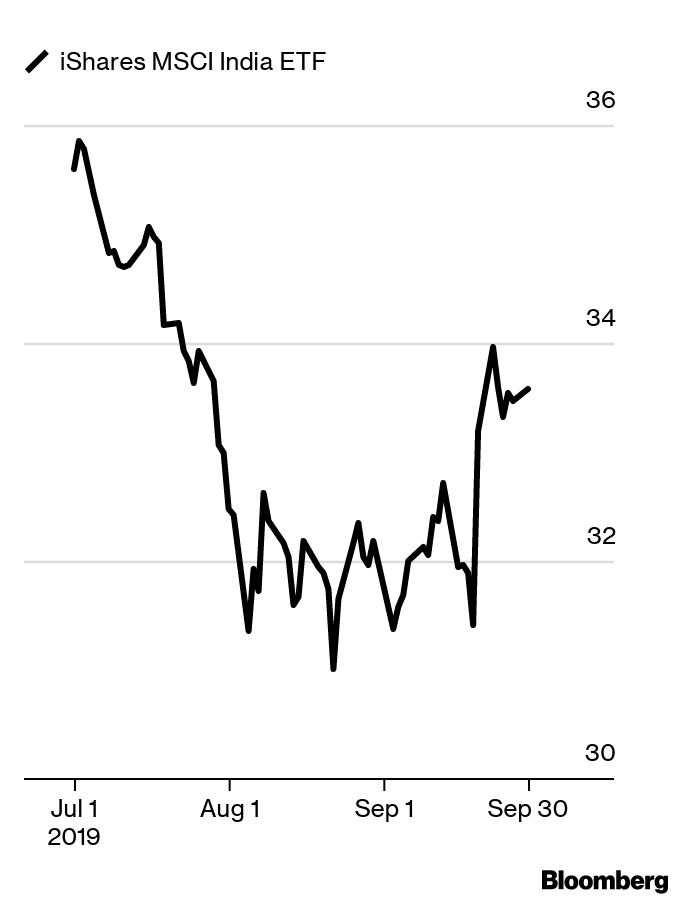 . The ETF covers India’s public market with exposure to some 80% of the country’s largest companies, and has an expense ratio of 0.68%.
. The ETF covers India’s public market with exposure to some 80% of the country’s largest companies, and has an expense ratio of 0.68%.
Performance of last quarter’s ETF plays: Innovator S&P 500 Power Buffer ETF (PJUL) gained 0.9% for the quarter ending Sept. 30.
gained 0.9% for the quarter ending Sept. 30.
Anticipate Shocks—and Short Mexico
Over the last number of years, the equity market story has been largely a story of rallies built on central bank policy. That includes direct communication from the Federal Reserve, ECB and others, as well as changes in market expectations, as investors attempt to predict what central bank committees might do.
At present, the perception that the Fed and ECB will continue to act to support equities has become pervasive. When stocks fall, as they did in May and last fall, interest rate markets revise expectations from expected rate increases to no change or cuts and longer periods of low or negative levels.
Central banks’ support of equity markets—implicit and explicit—is also now set against a backdrop of slower global economic growth. Indicators of slowing growth may justify flat or lower interest rates, but also offer less compelling support for repeated stock market rebounds.
We think liquidity is king, so we want to lower equity exposure and keep cash on hand to limit the pain of downside shocks and have the opportunity to deploy capital when drops occur.
We are also identifying particularly overpriced markets such as Mexico, where we have one of our largest short positions in equities. The country’s finance minister abruptly resigned, and we have concerns about whether economic and fiscal policy will be able to counter the serious challenges the country faces.
Way to play it with ETFs: For those who want protection against shocks, Balchunas points to the Innovator S&P 500 Power Buffer ETF (PJUL)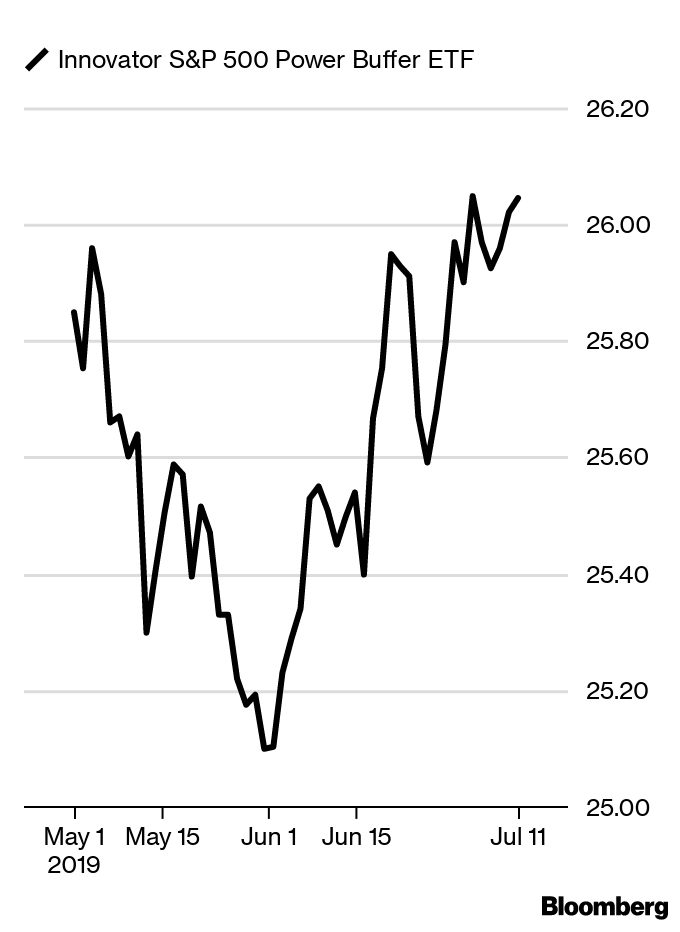 . It protects investors from losses greater than 15% in a steep drawdown if held to maturity in July 2020. The fund, a set of actively managed options on the S&P 500, maintains some exposure to equity growth but caps gains at 8.88%. It has a fee of 0.79%.
. It protects investors from losses greater than 15% in a steep drawdown if held to maturity in July 2020. The fund, a set of actively managed options on the S&P 500, maintains some exposure to equity growth but caps gains at 8.88%. It has a fee of 0.79%.









